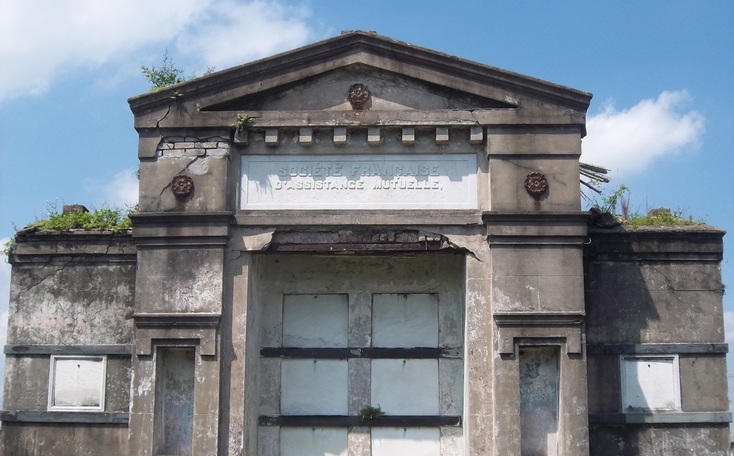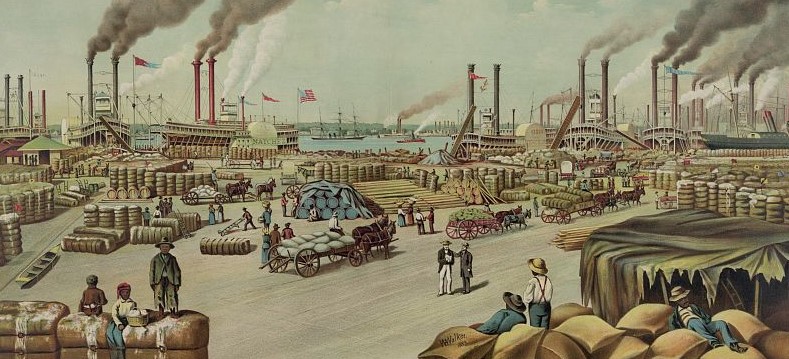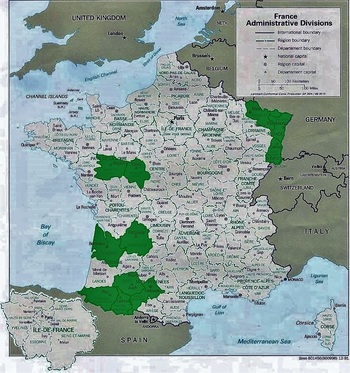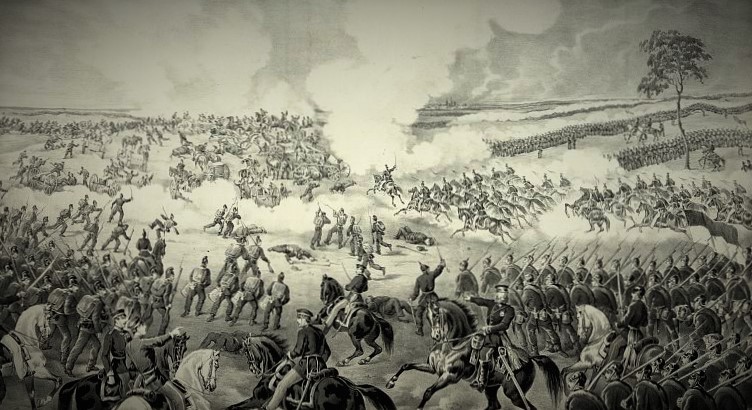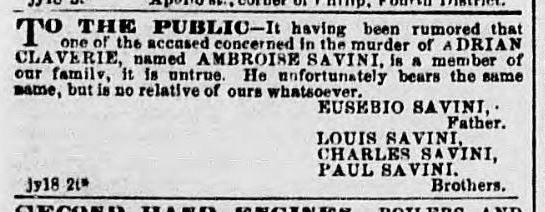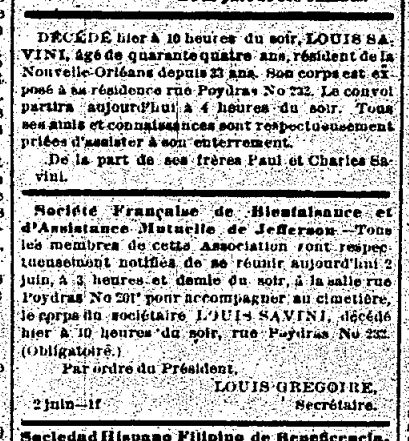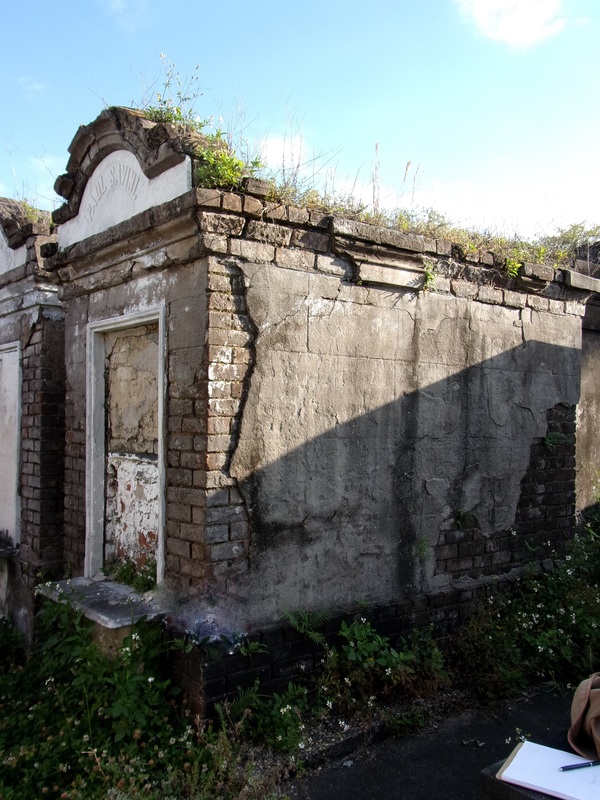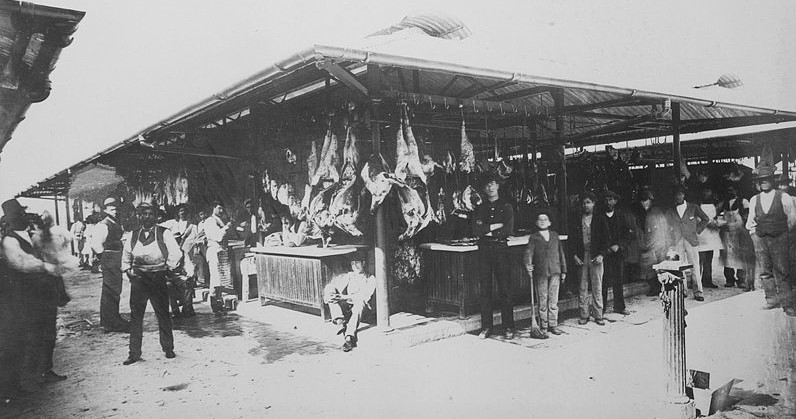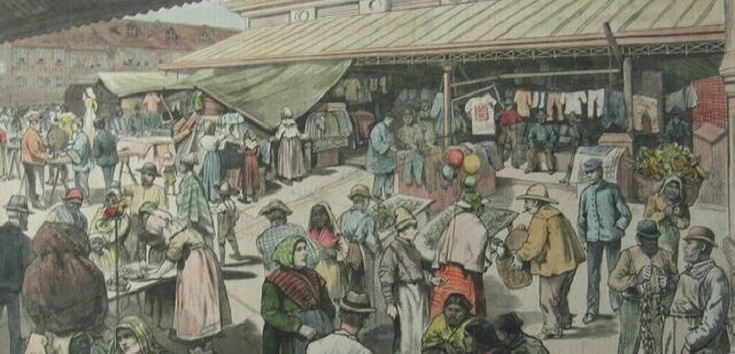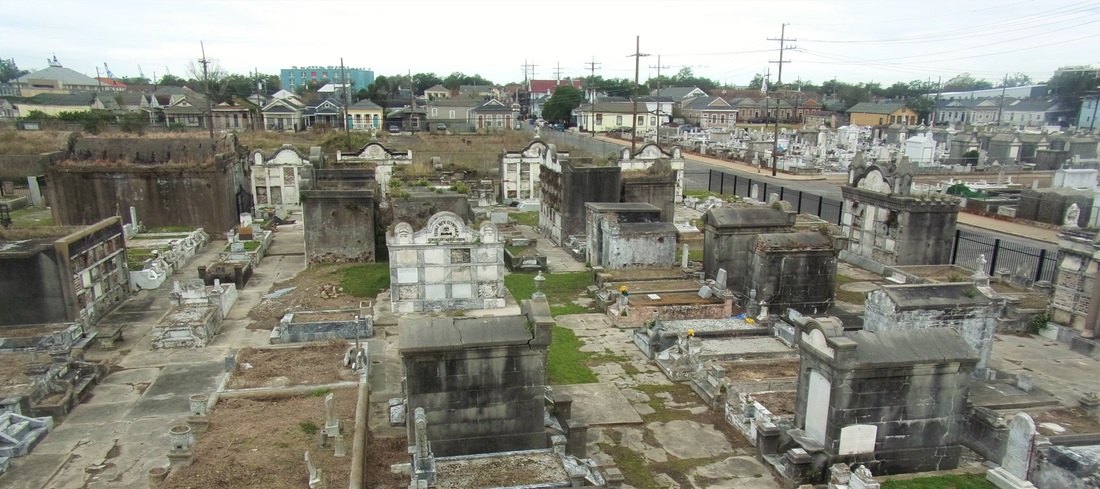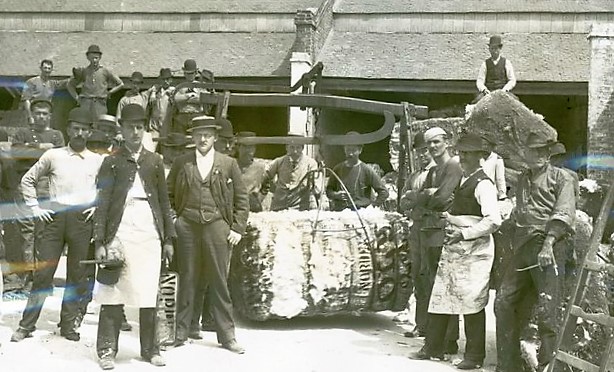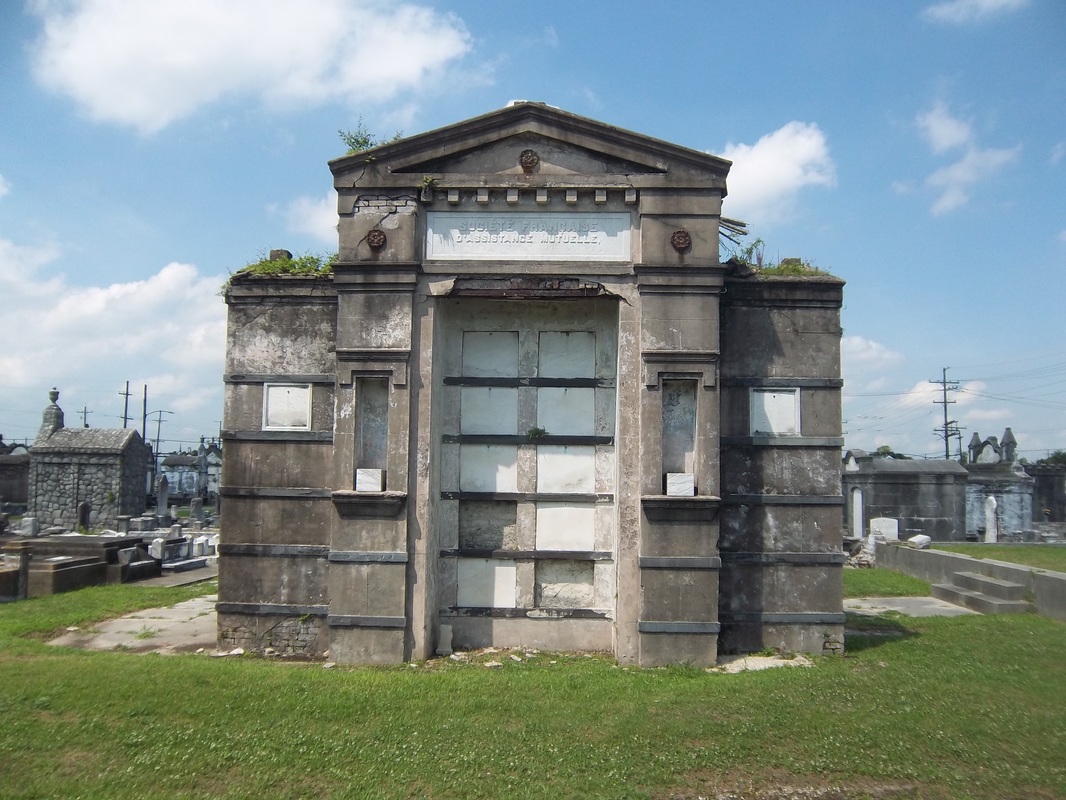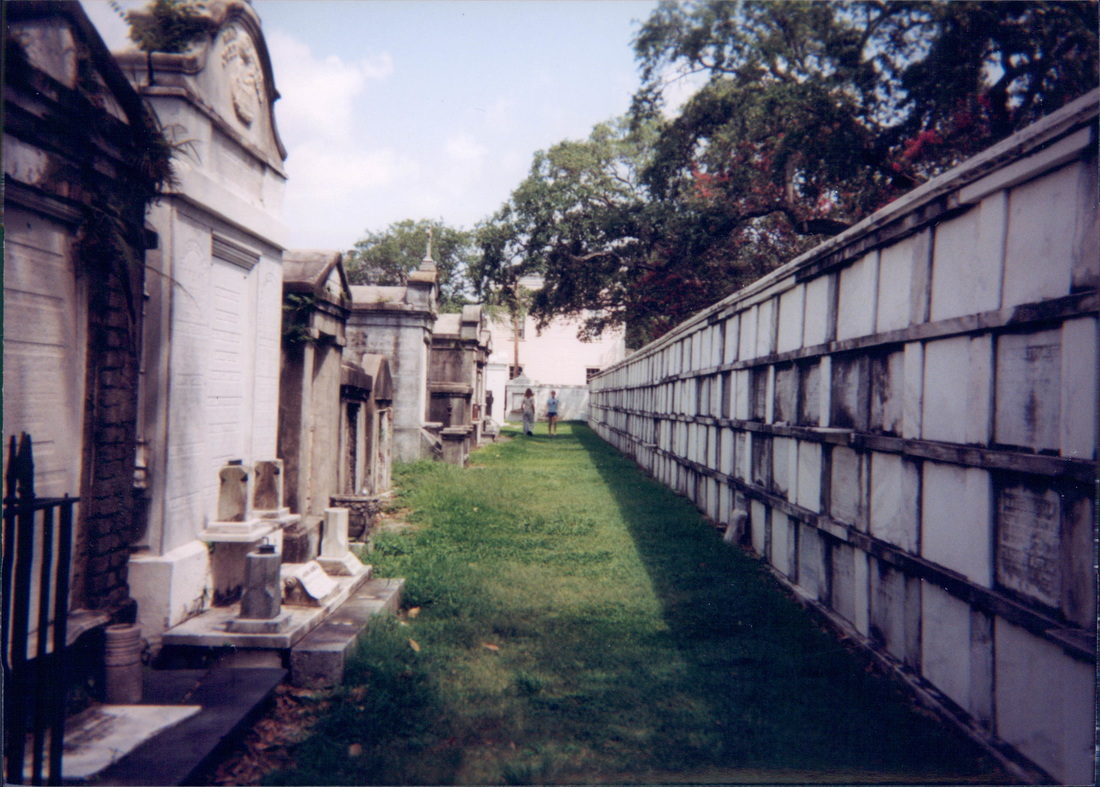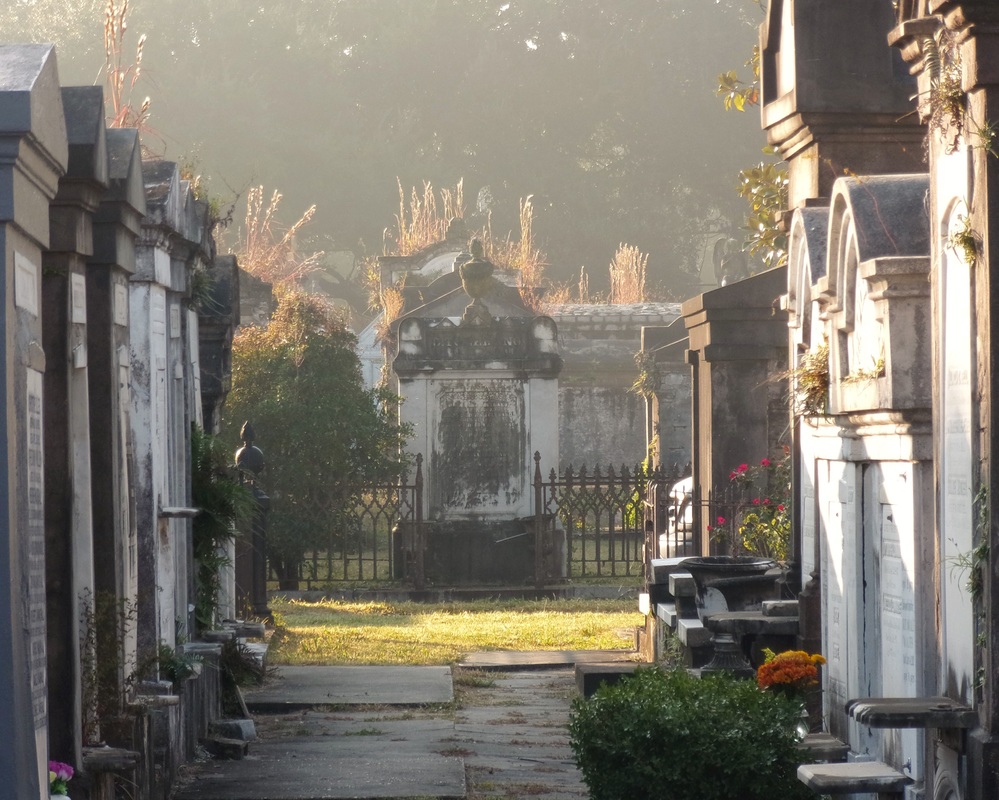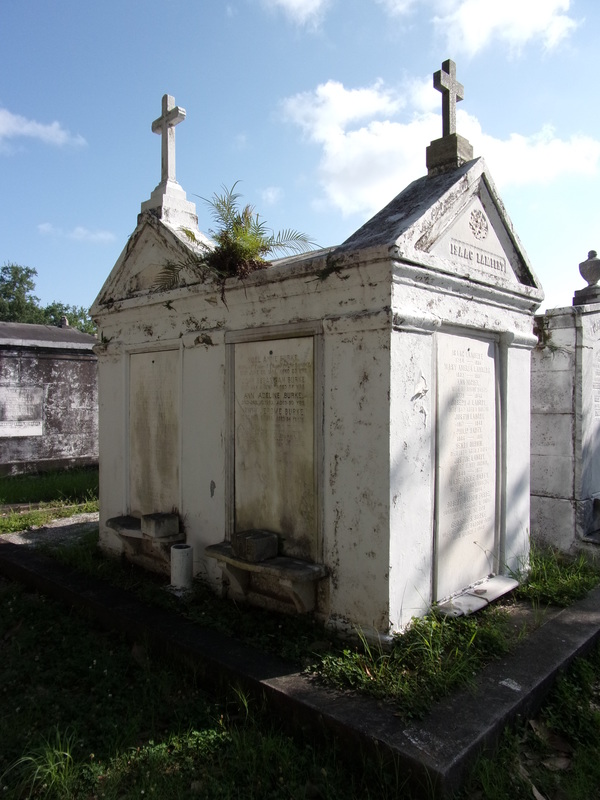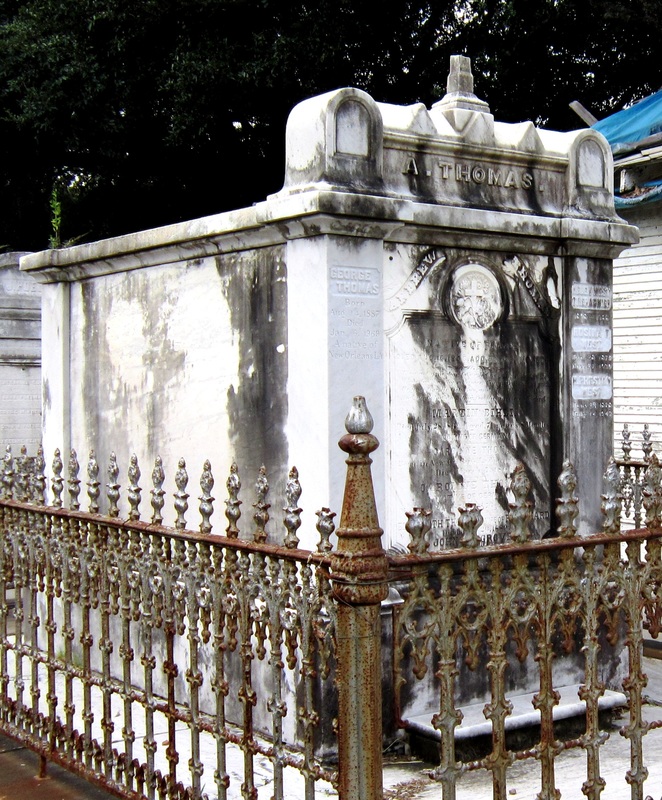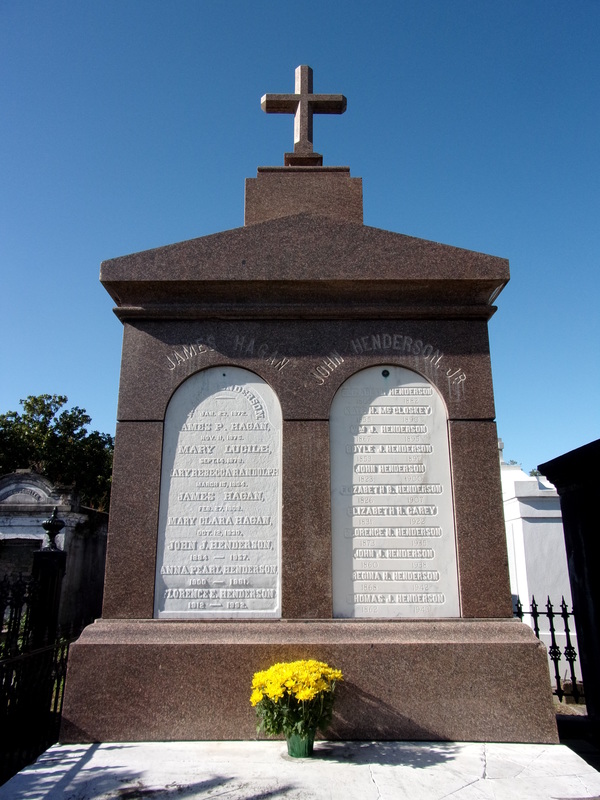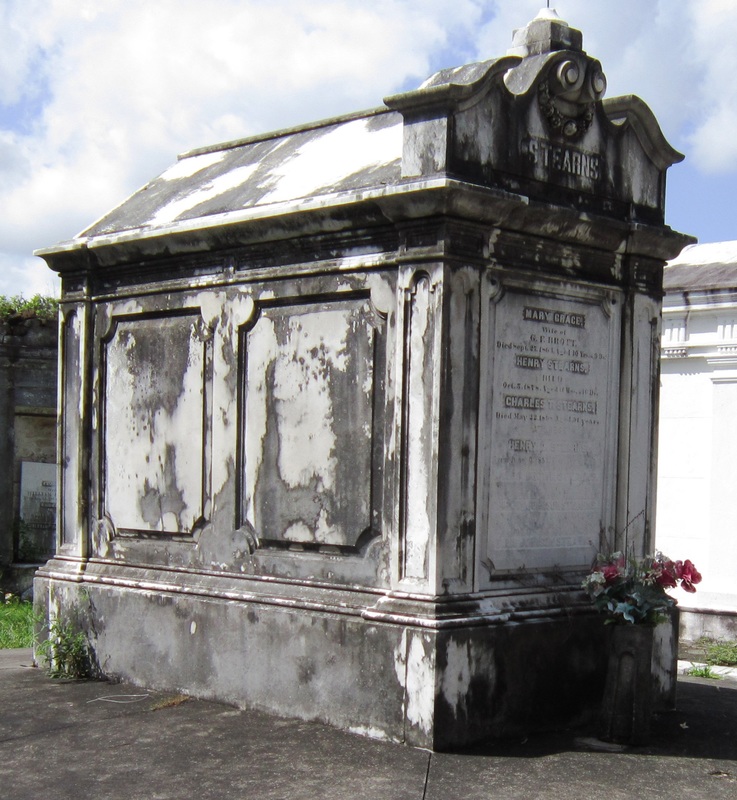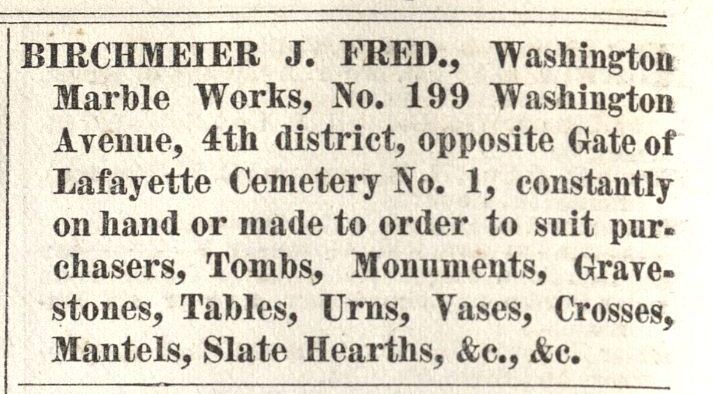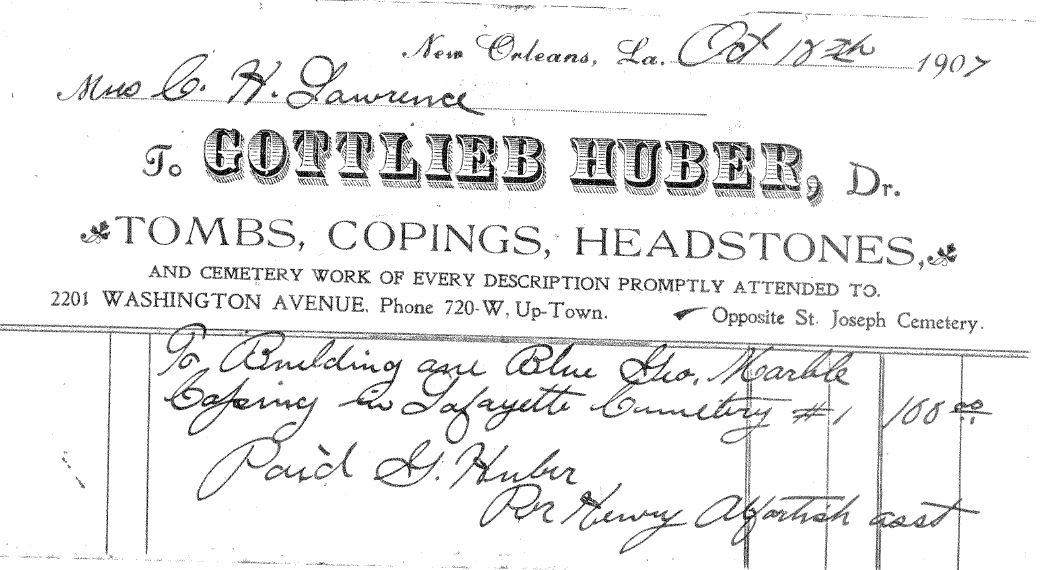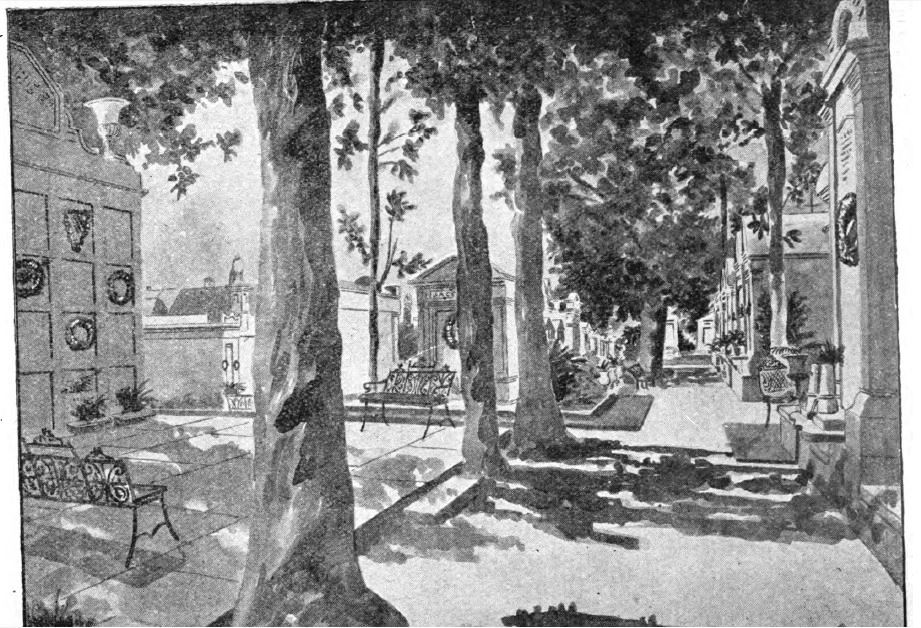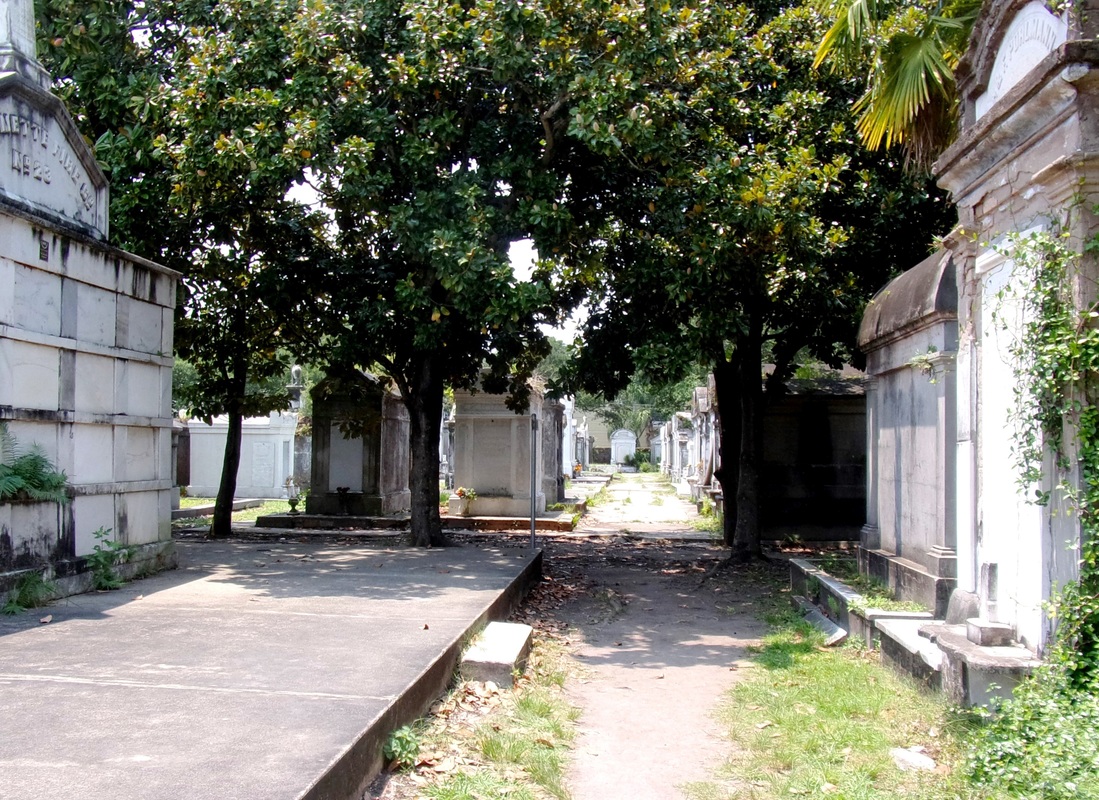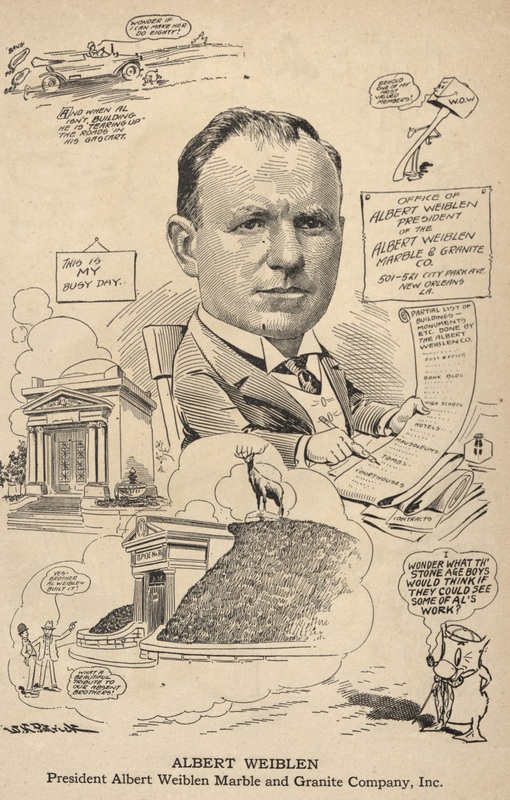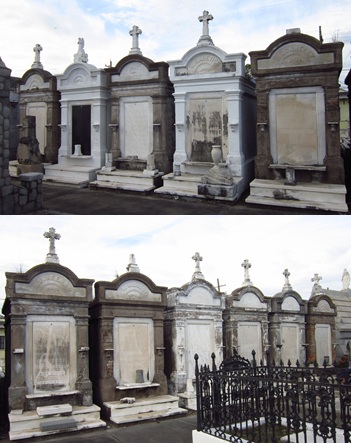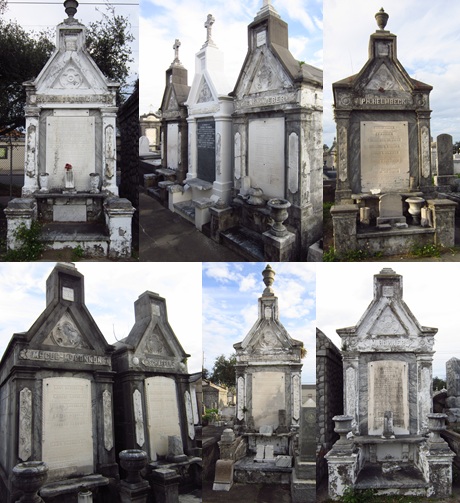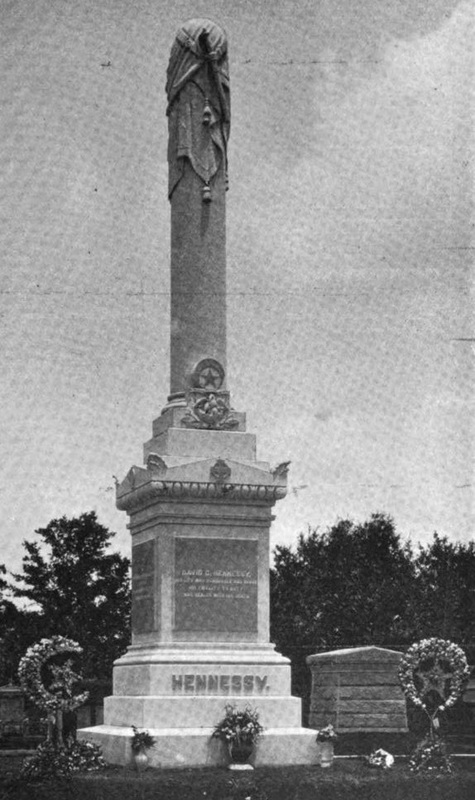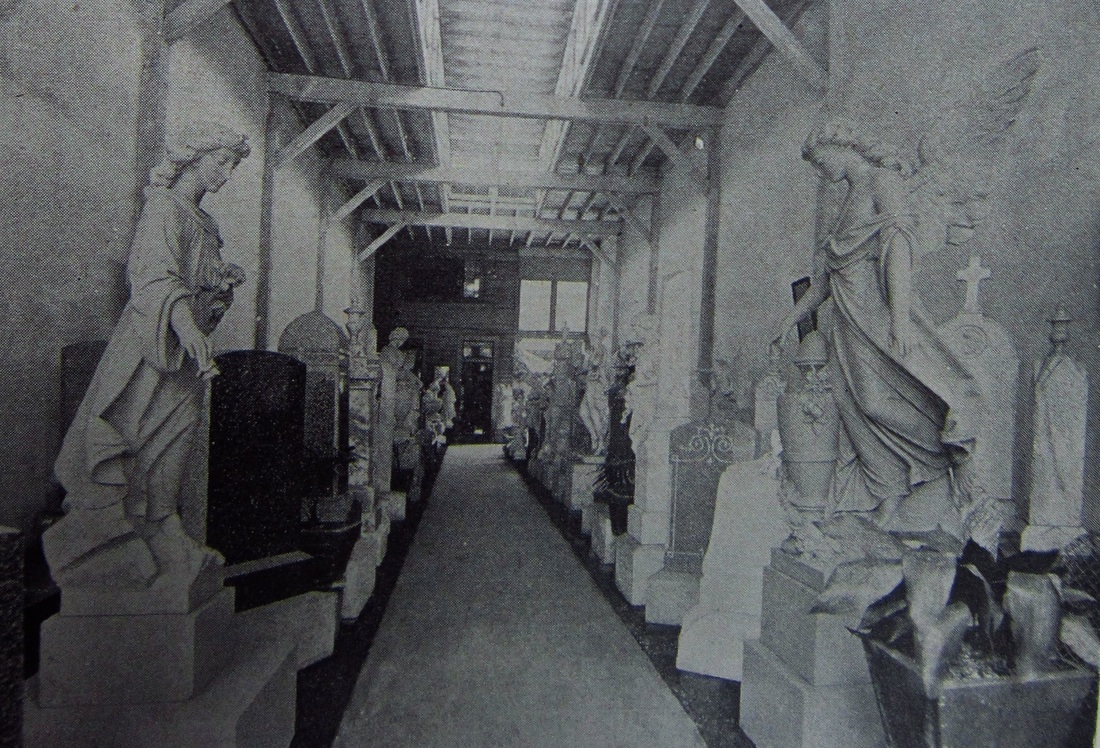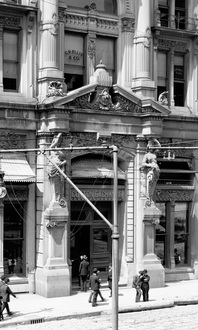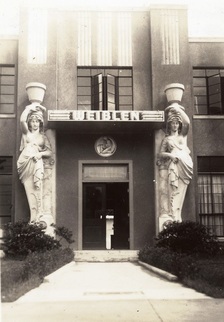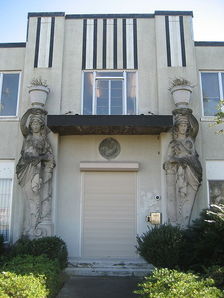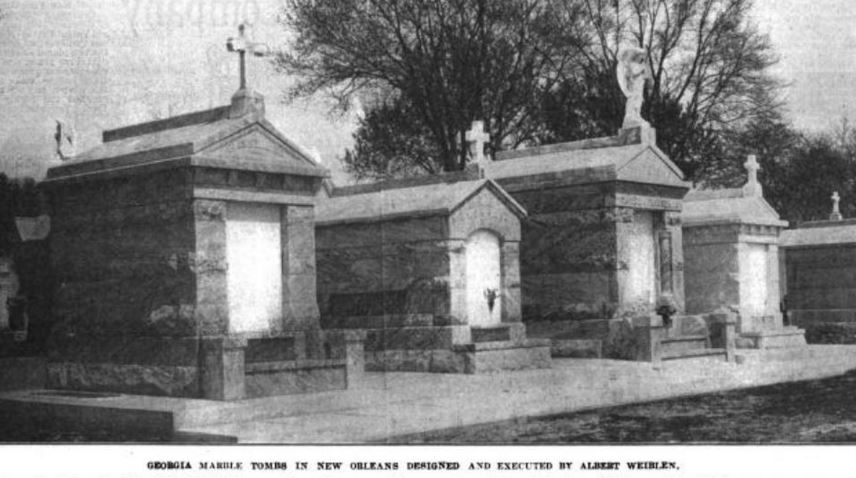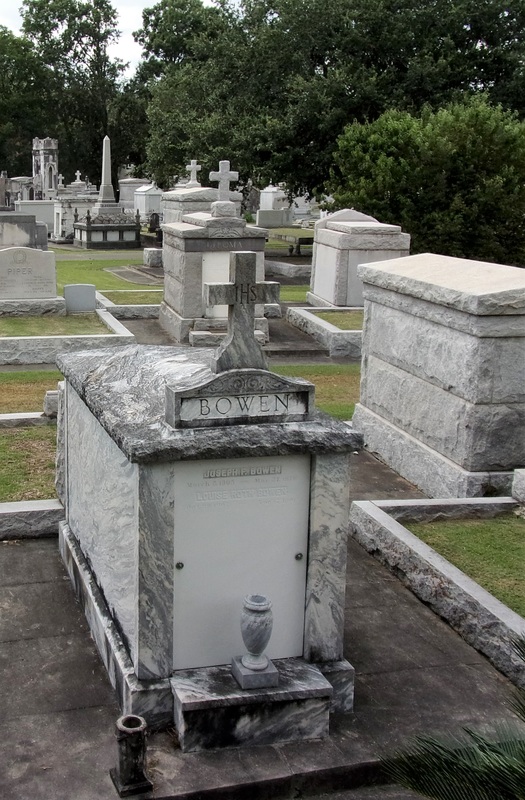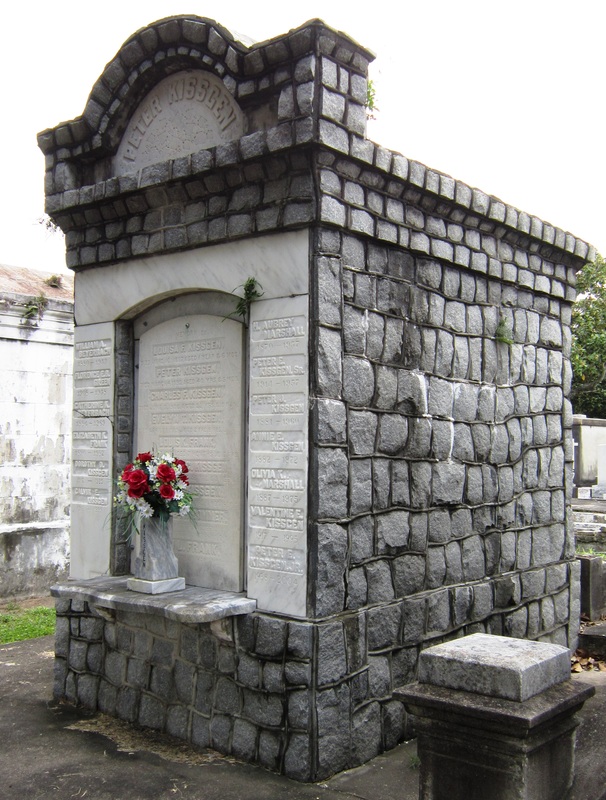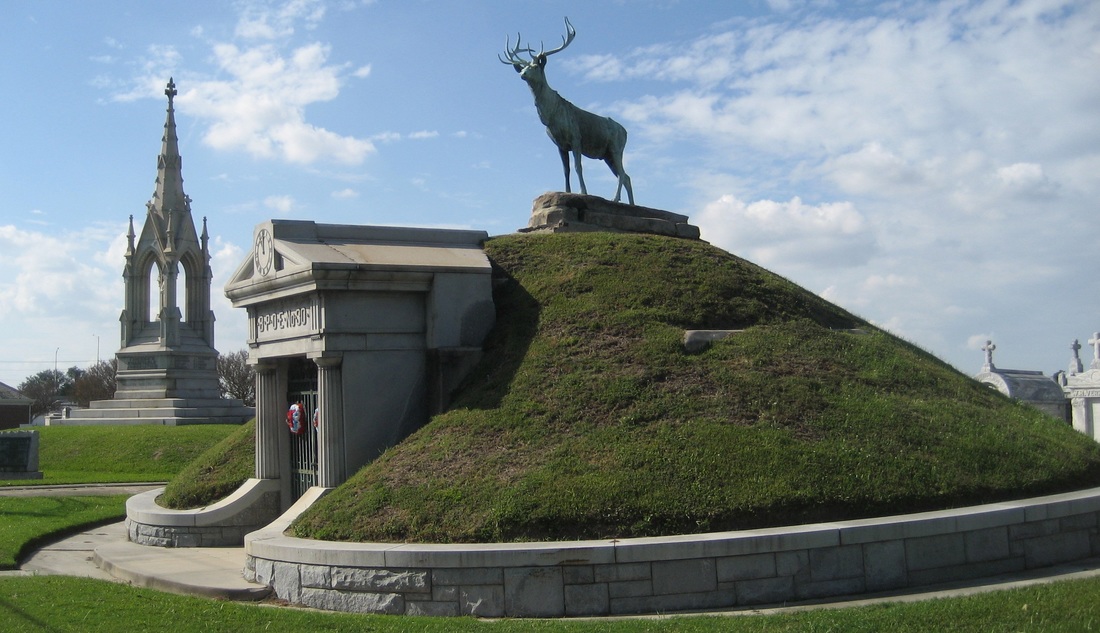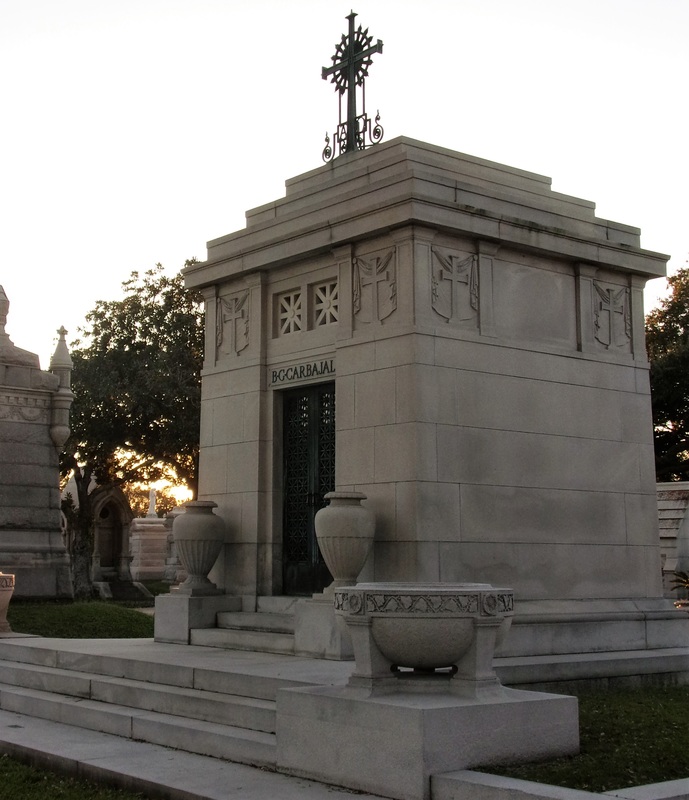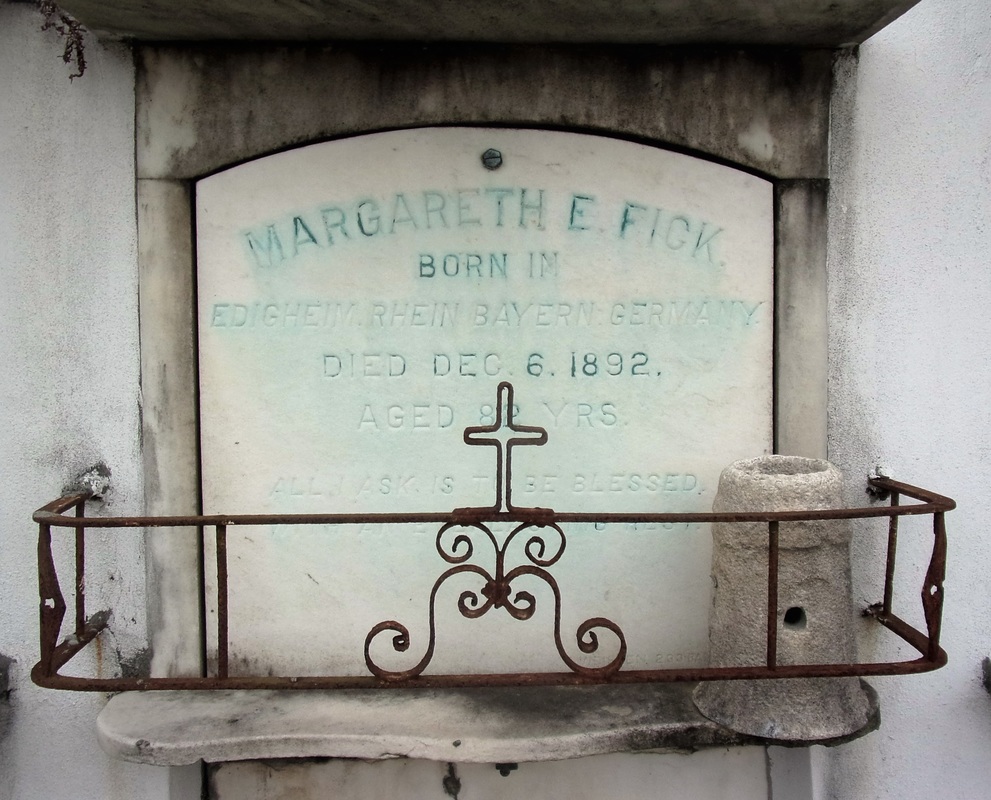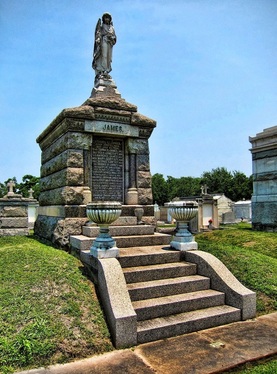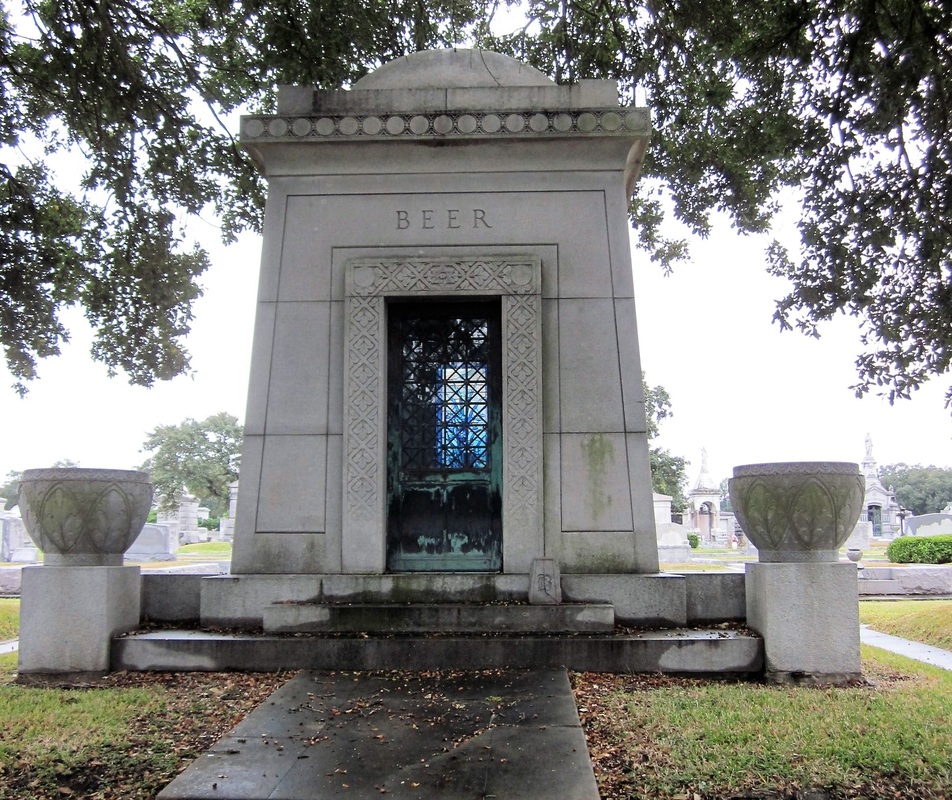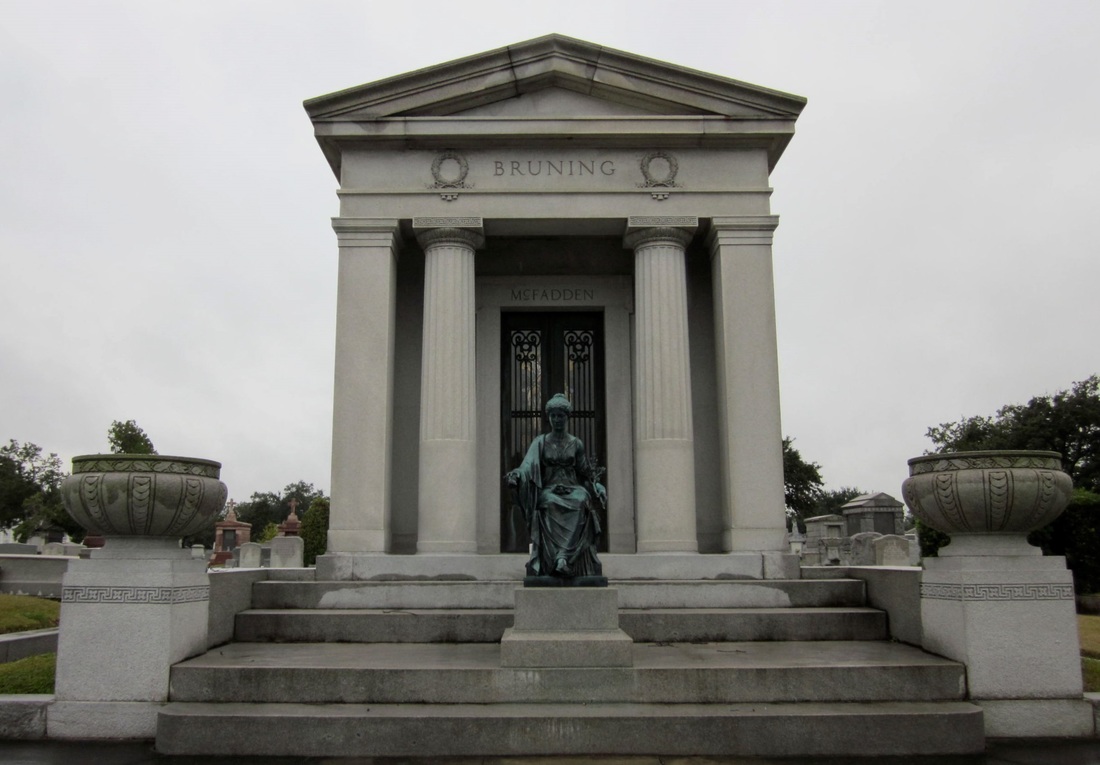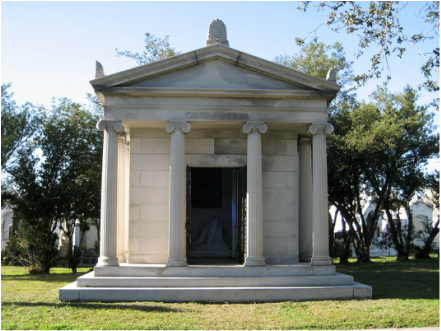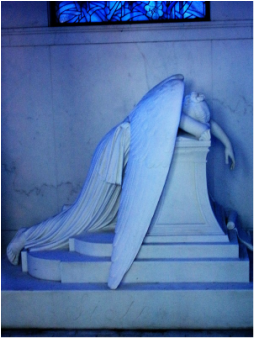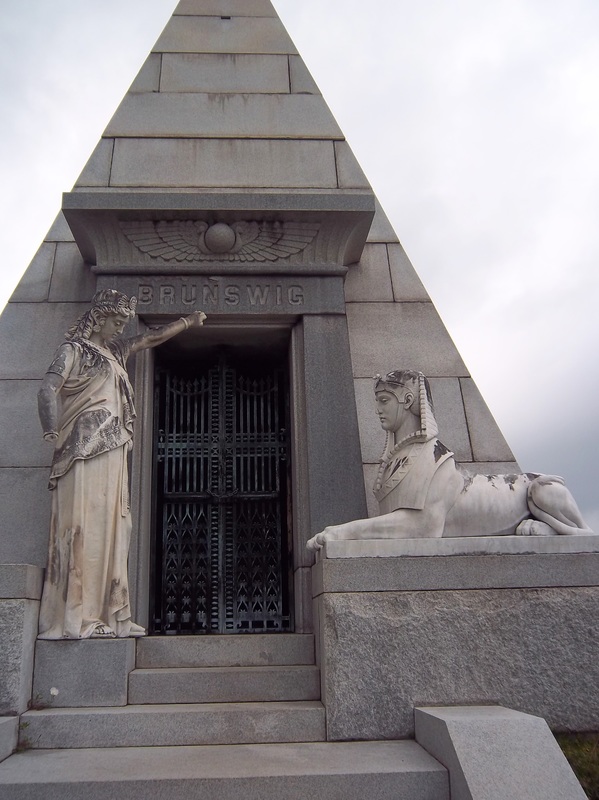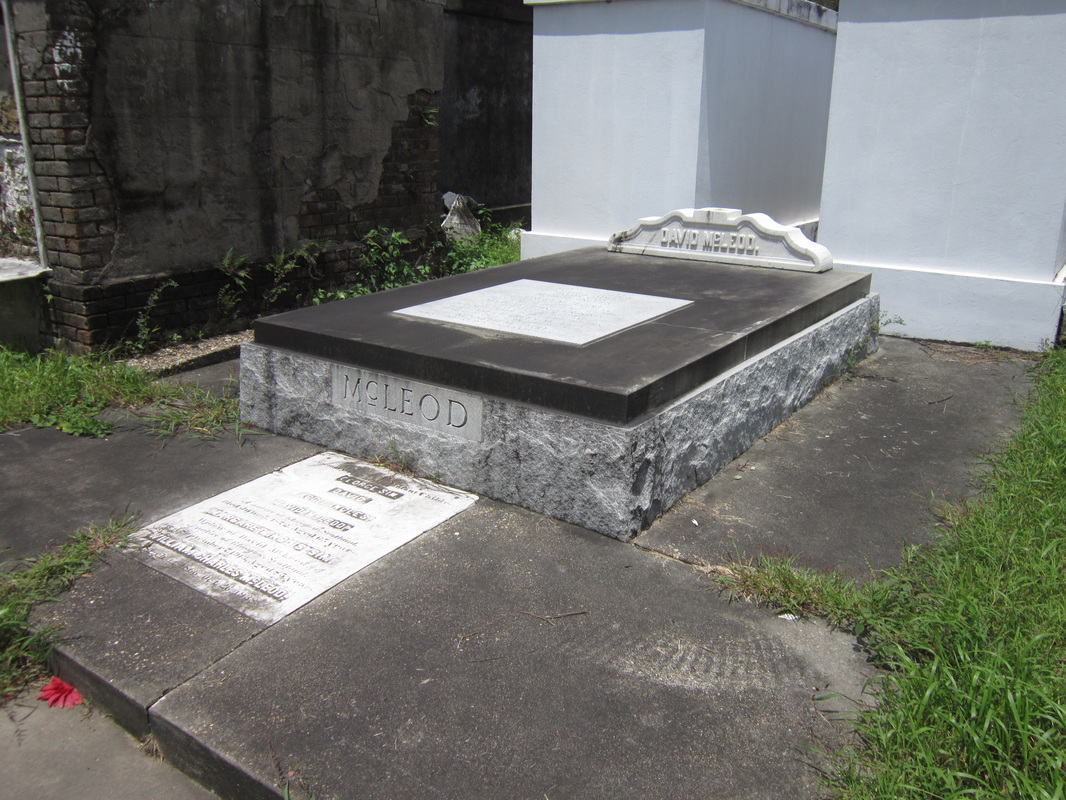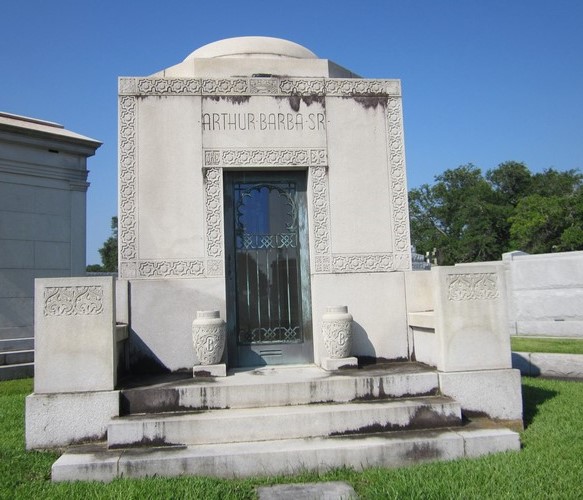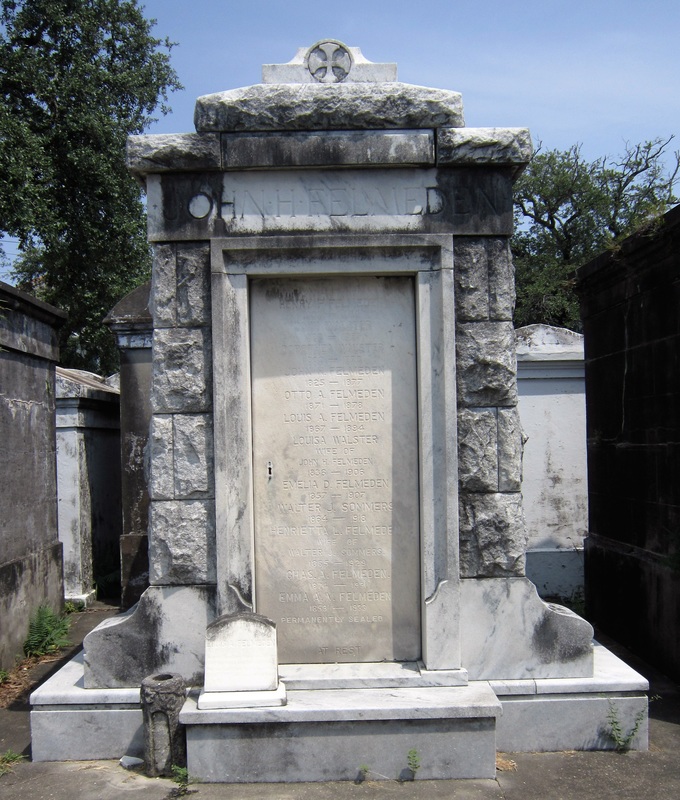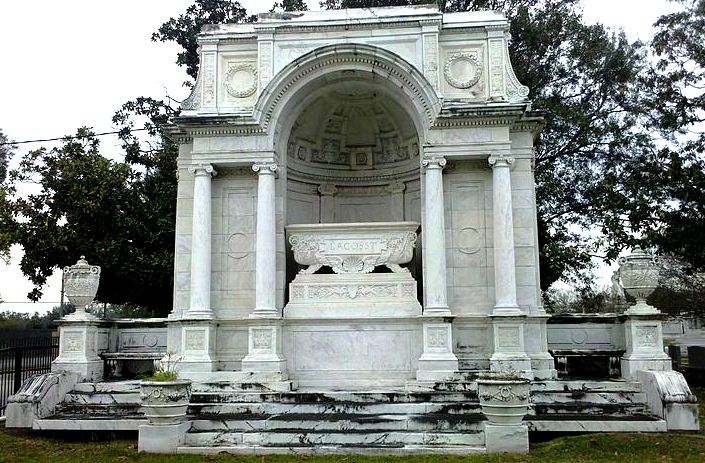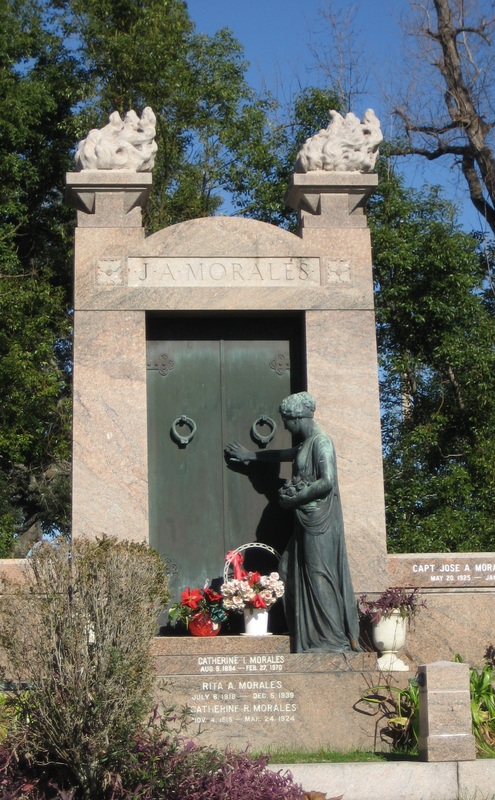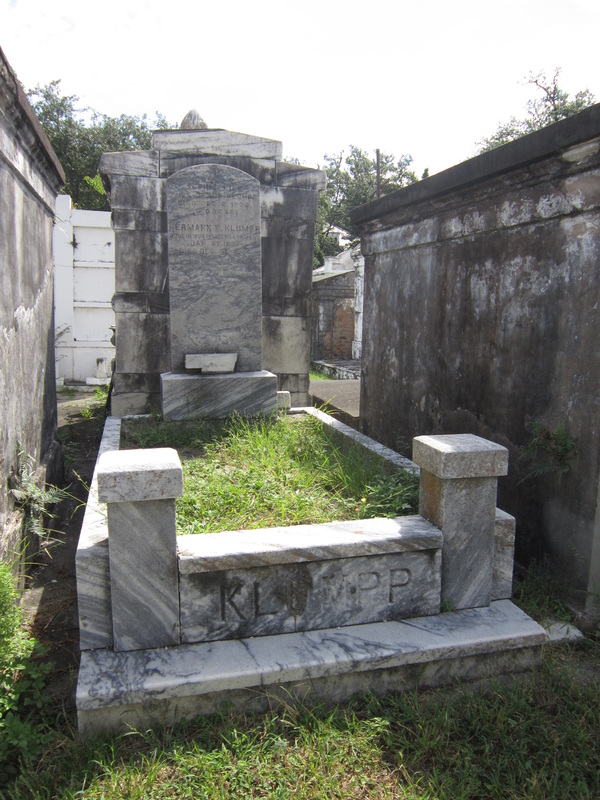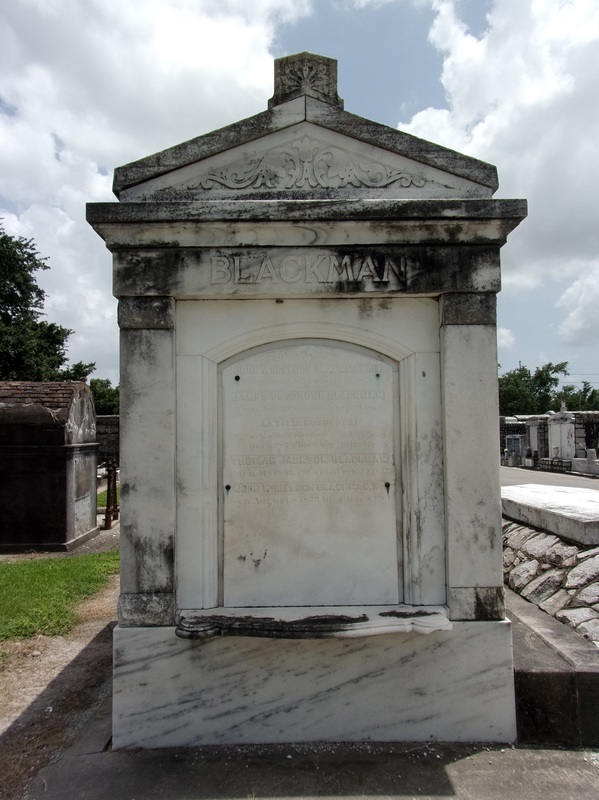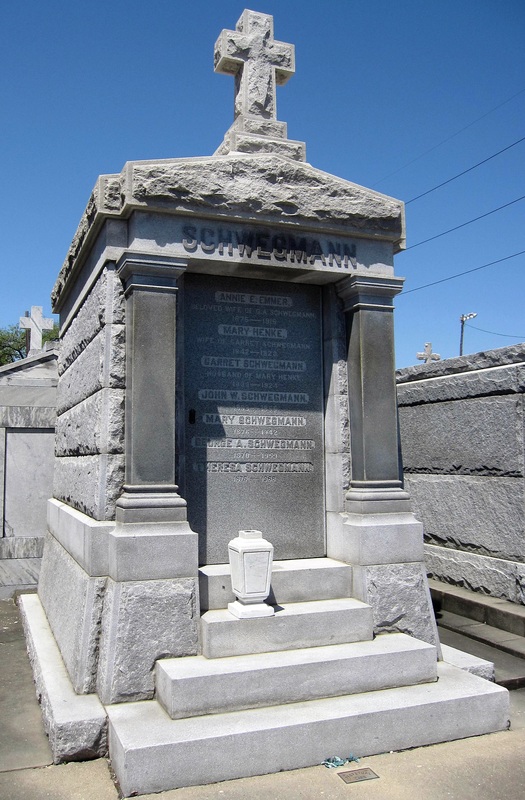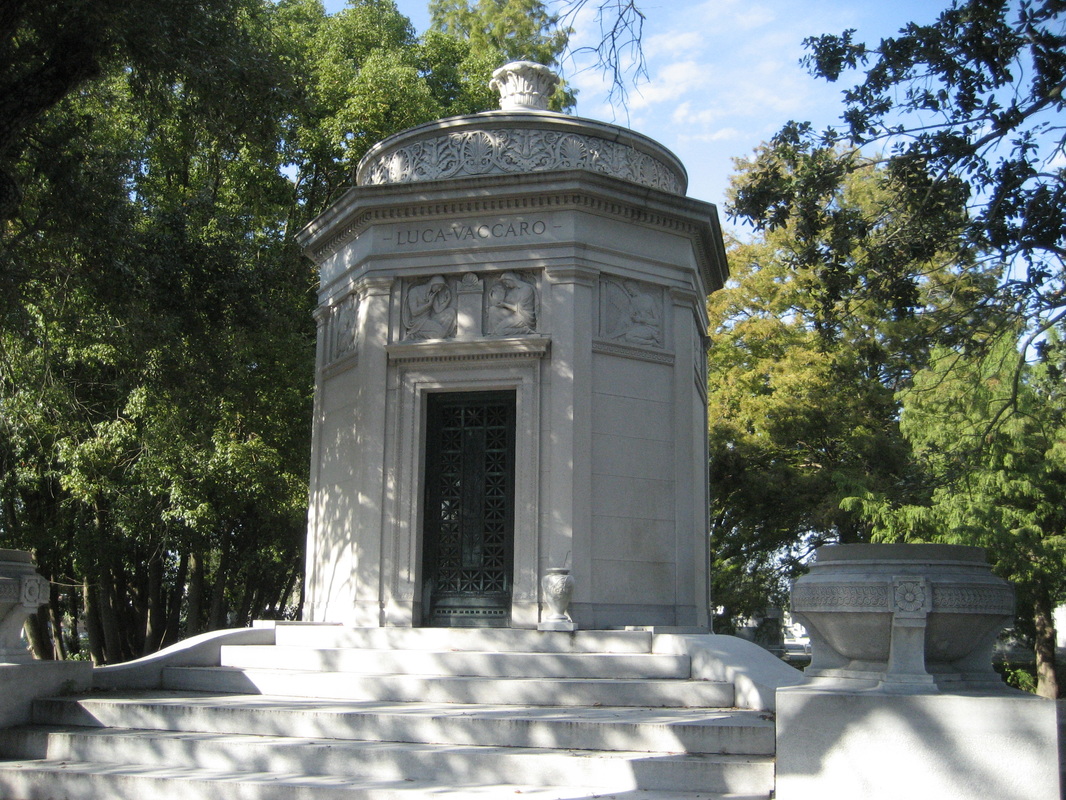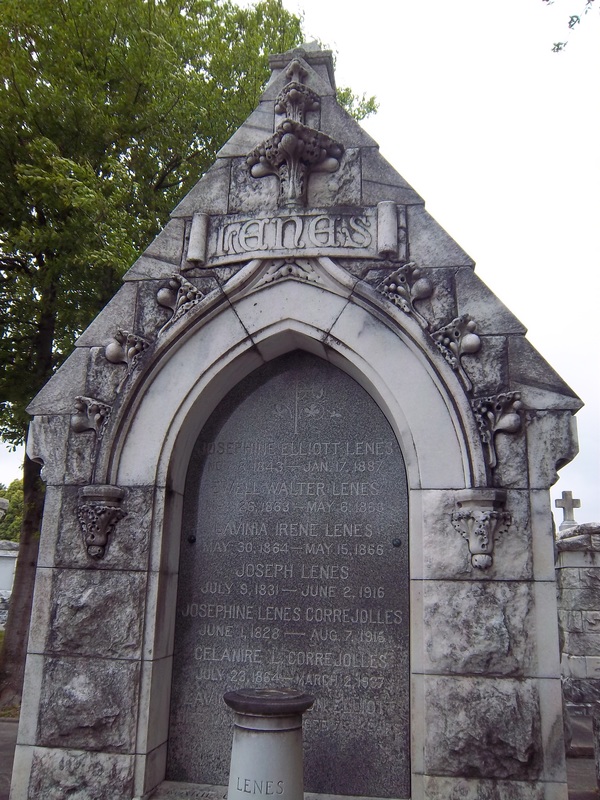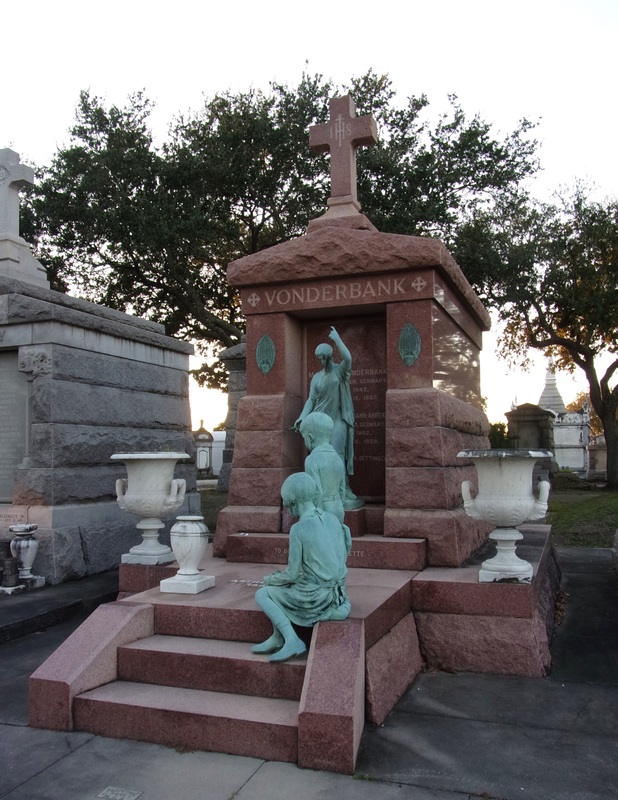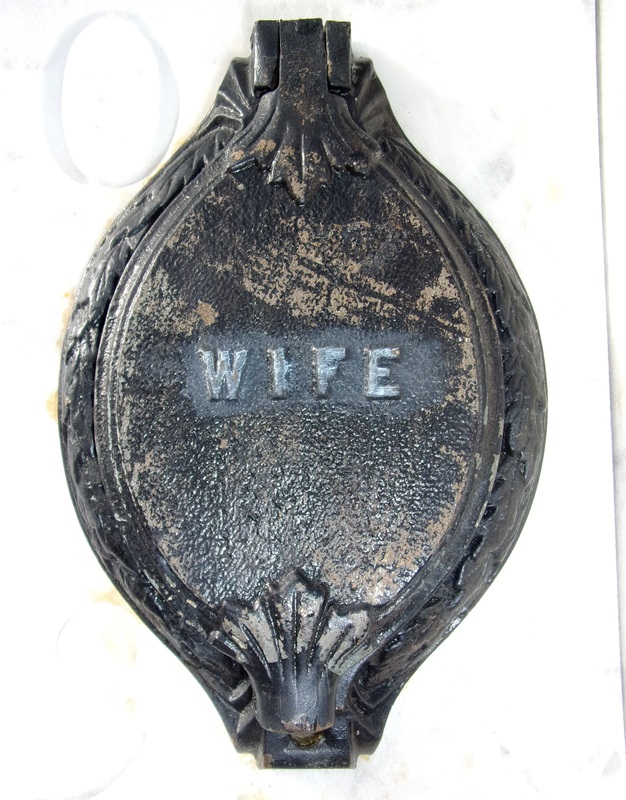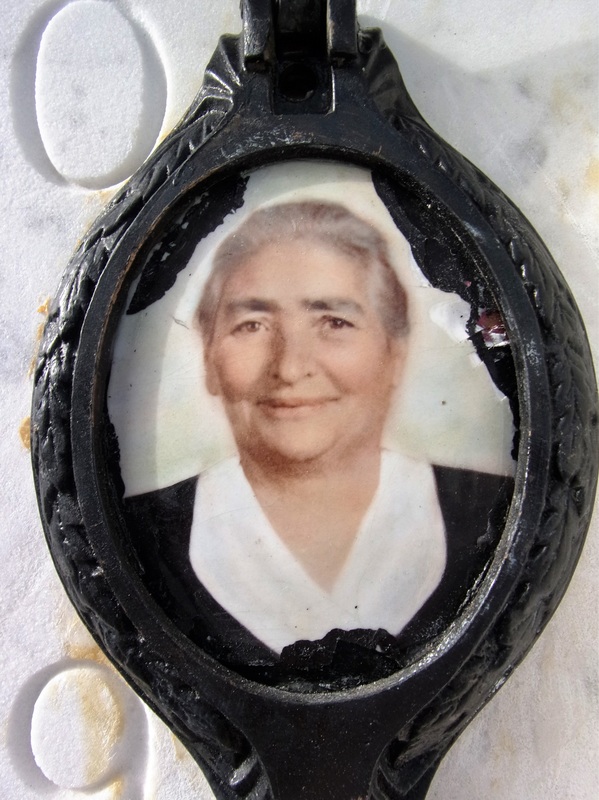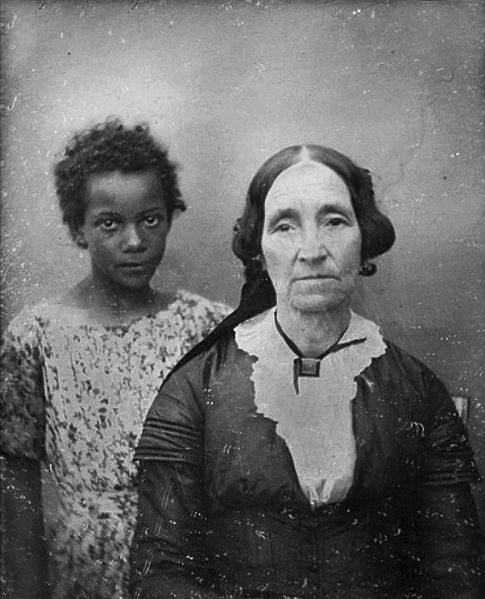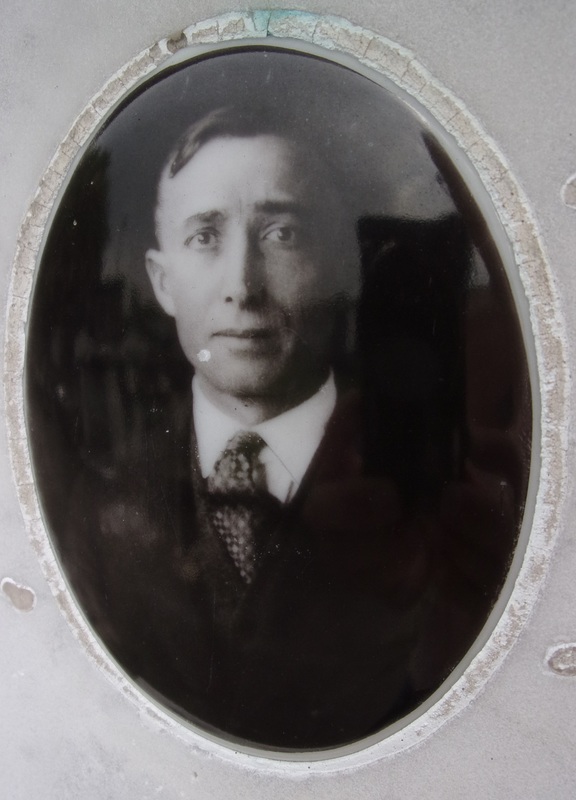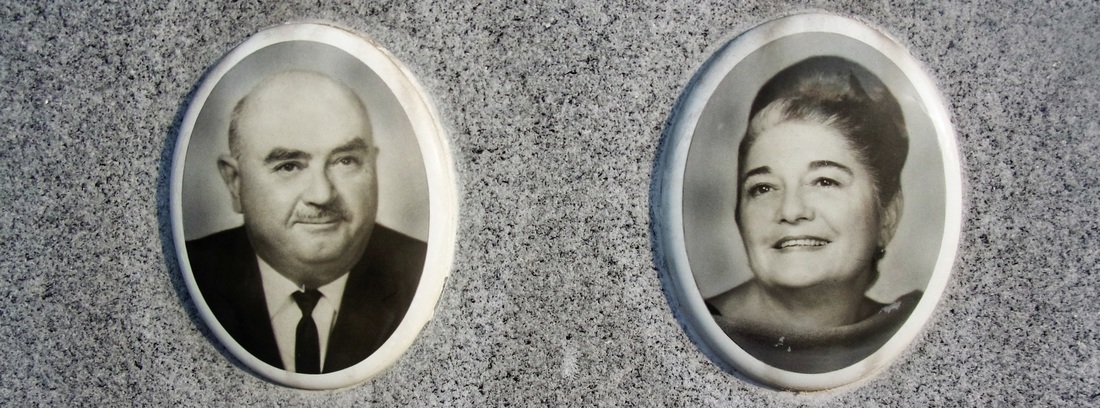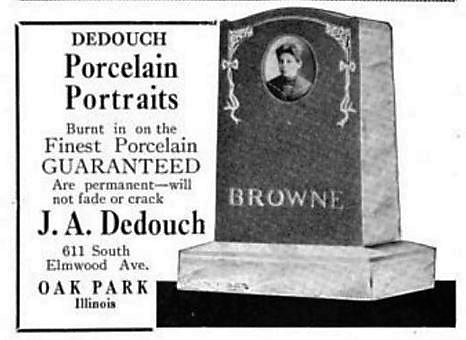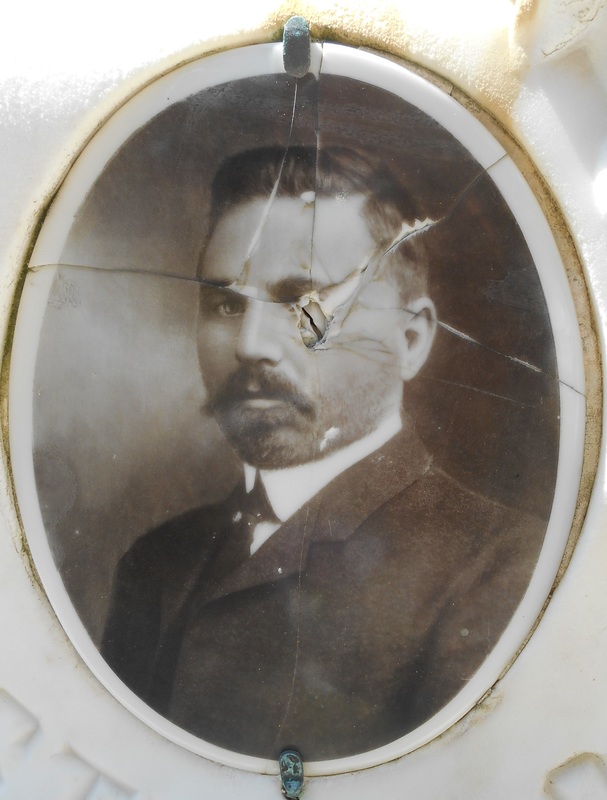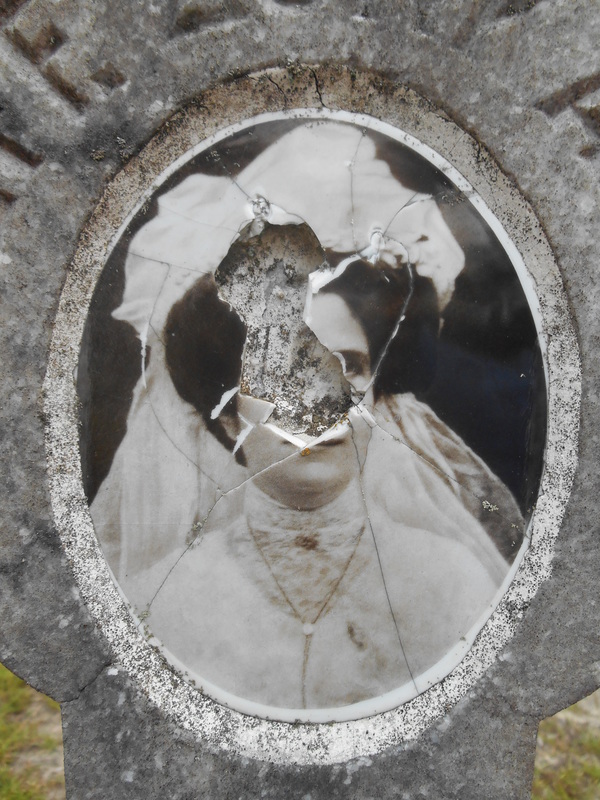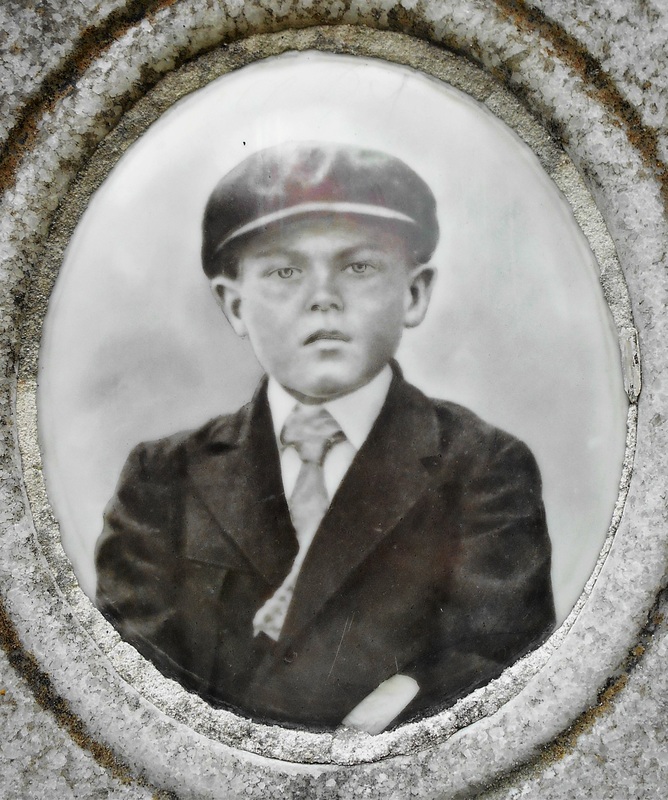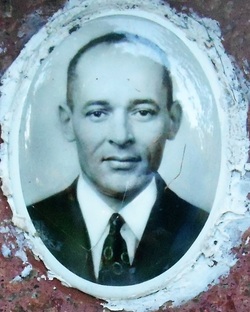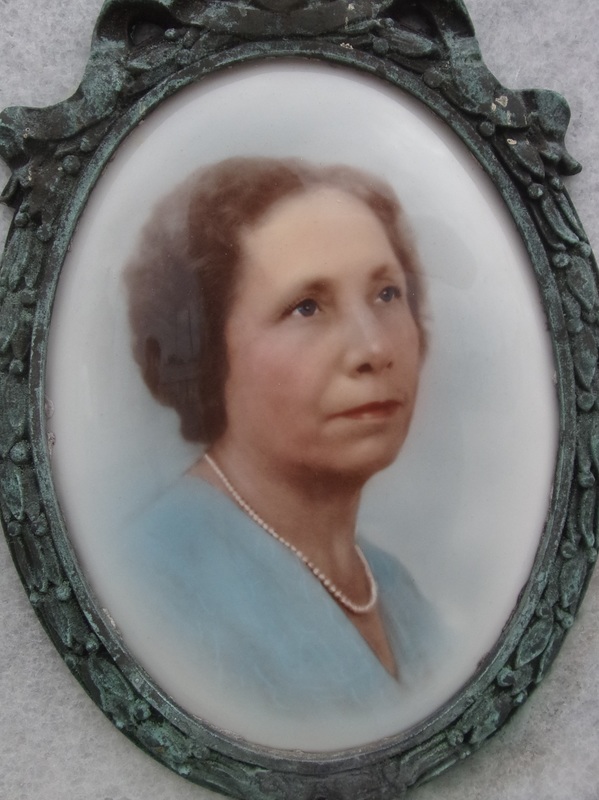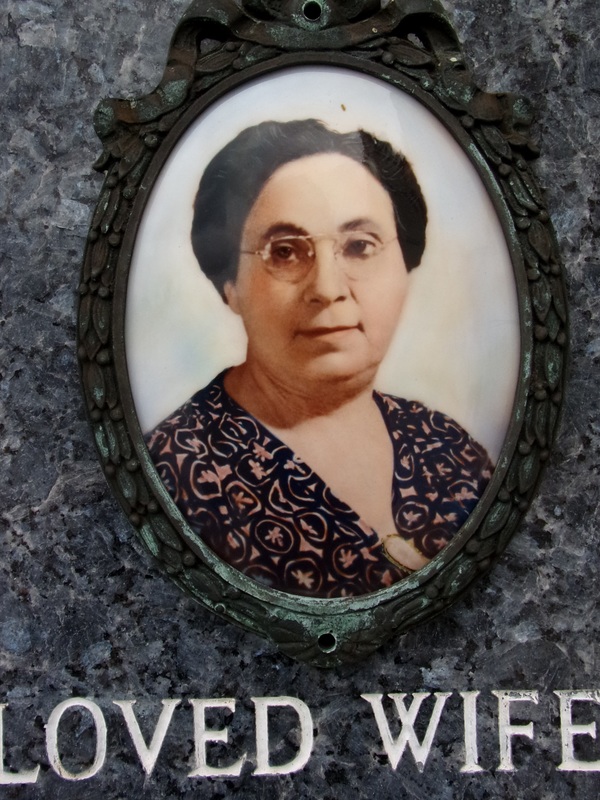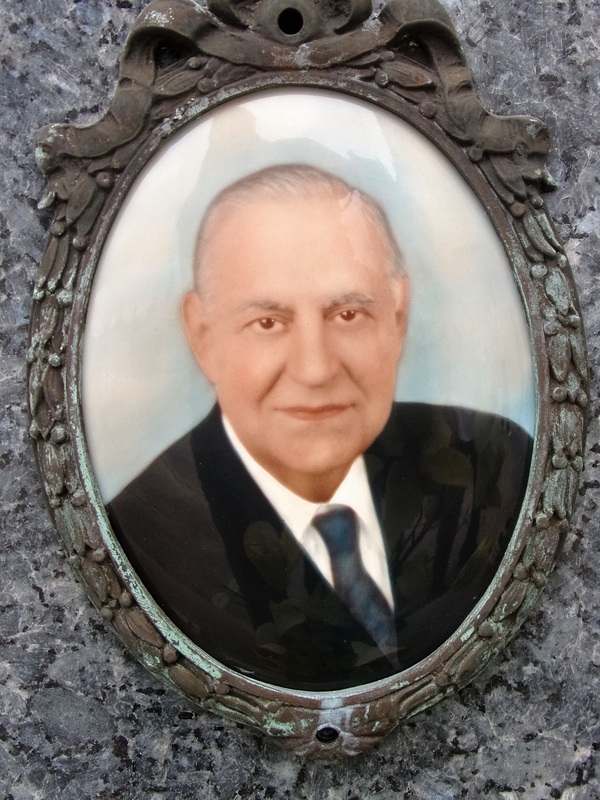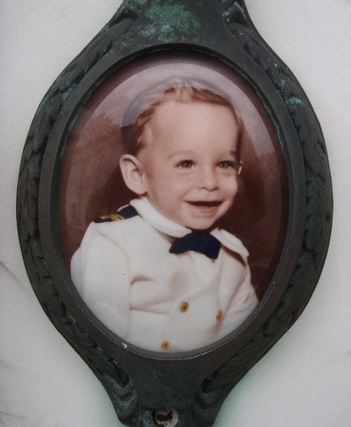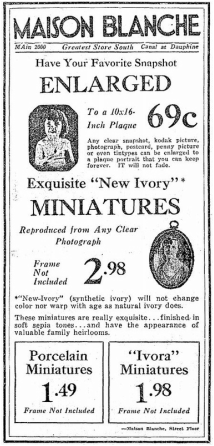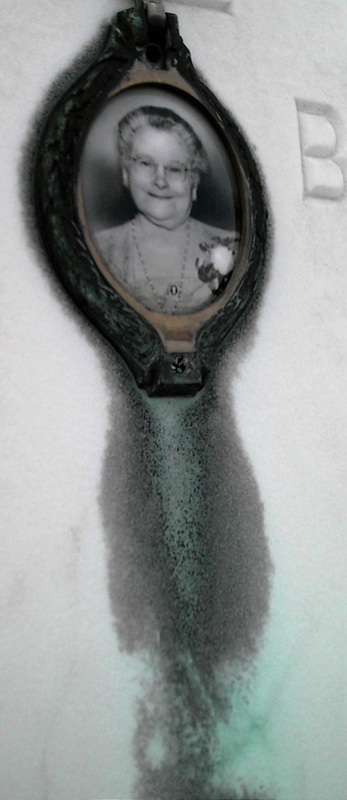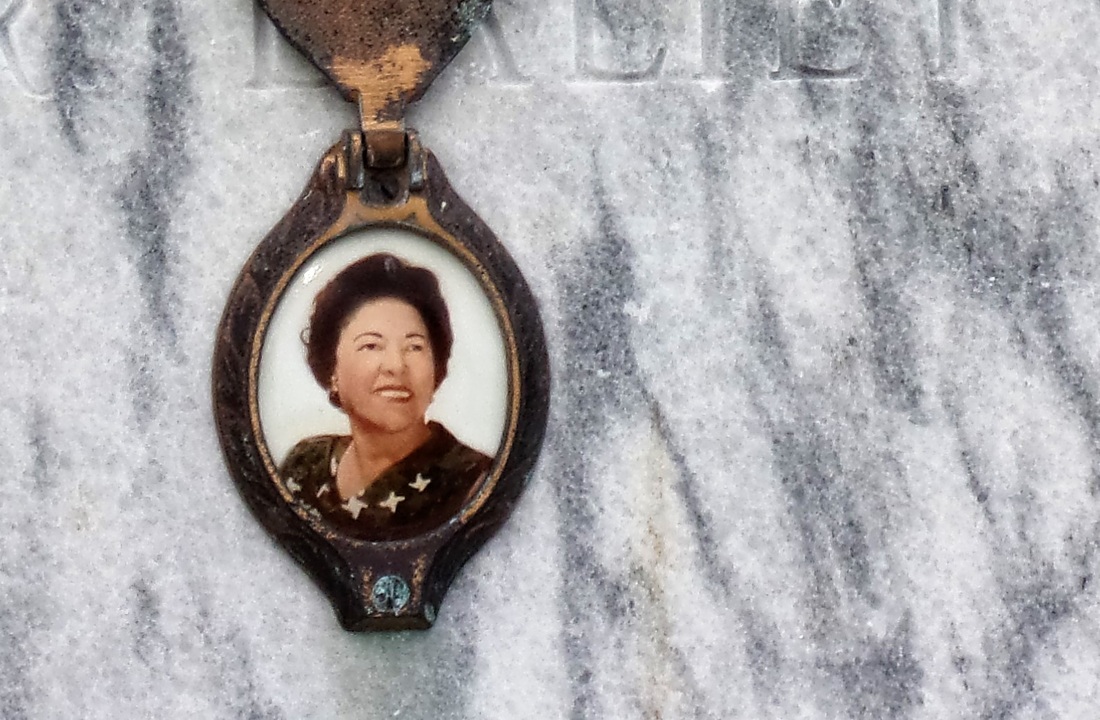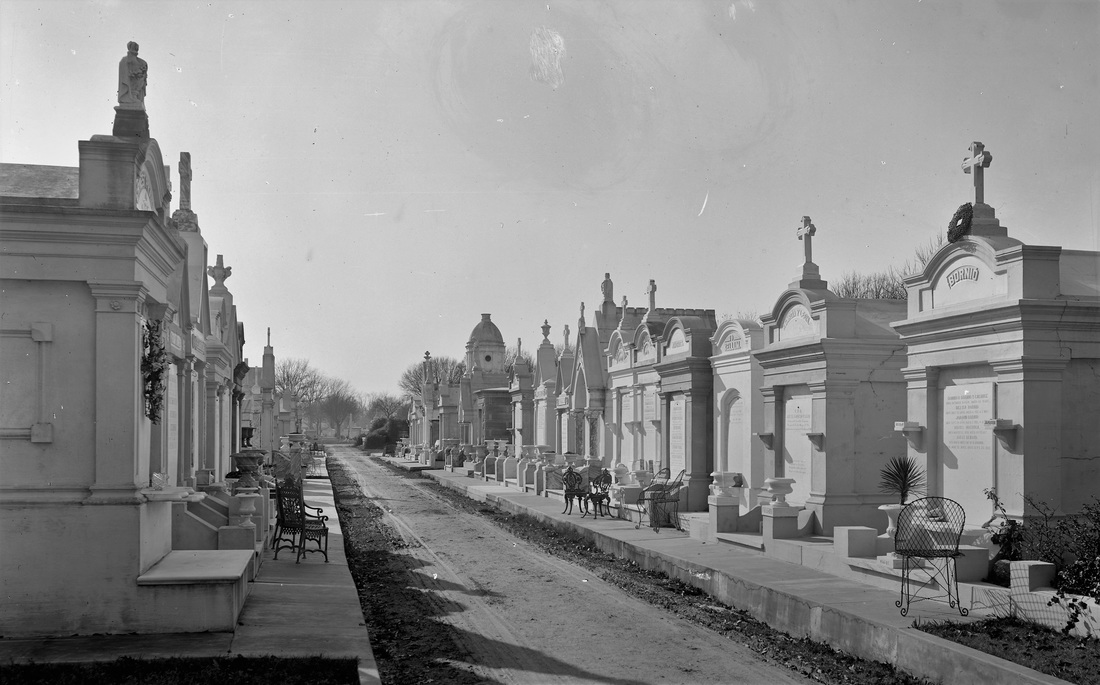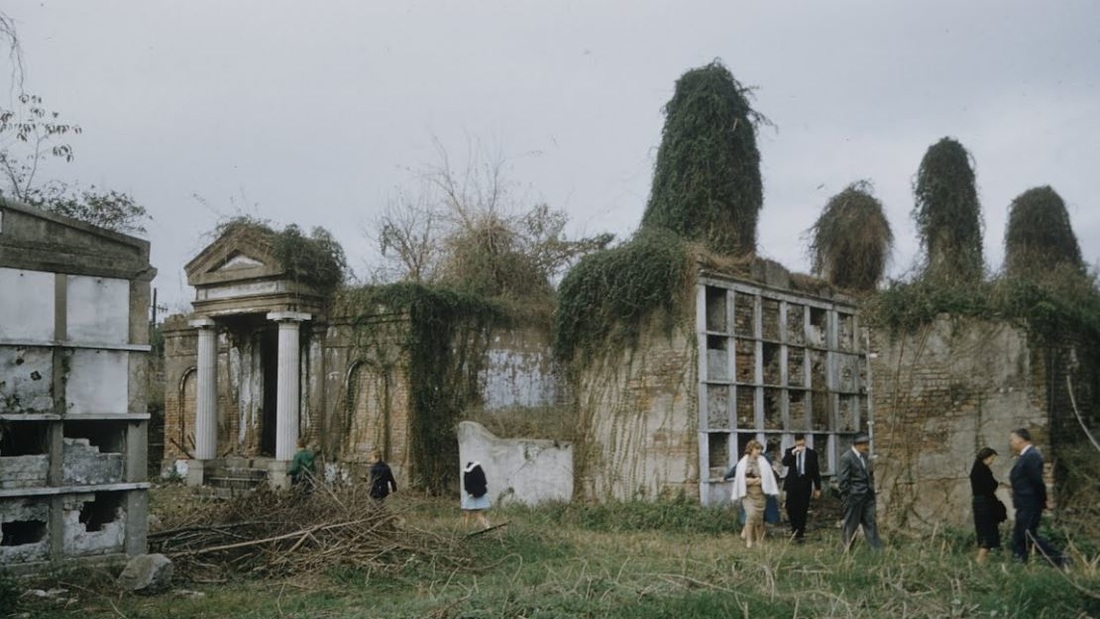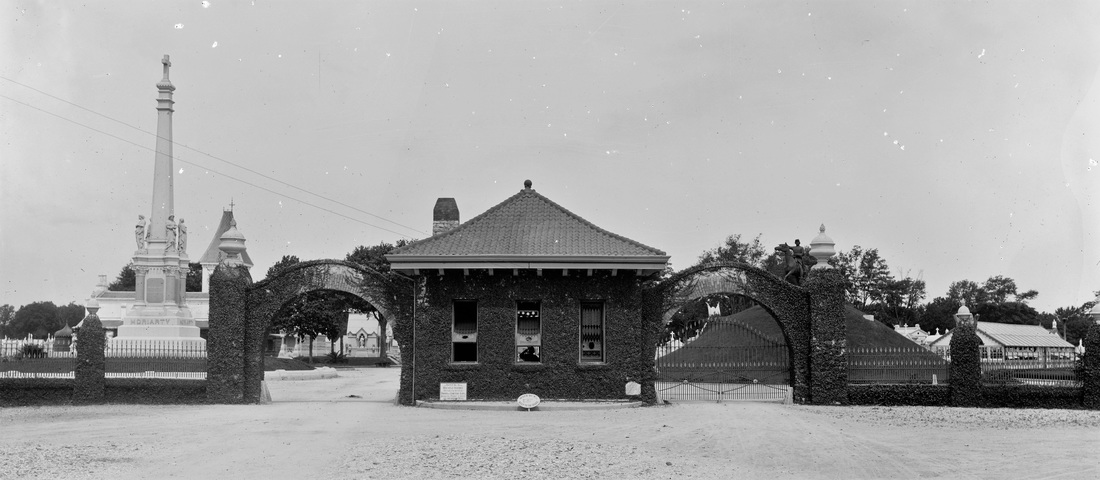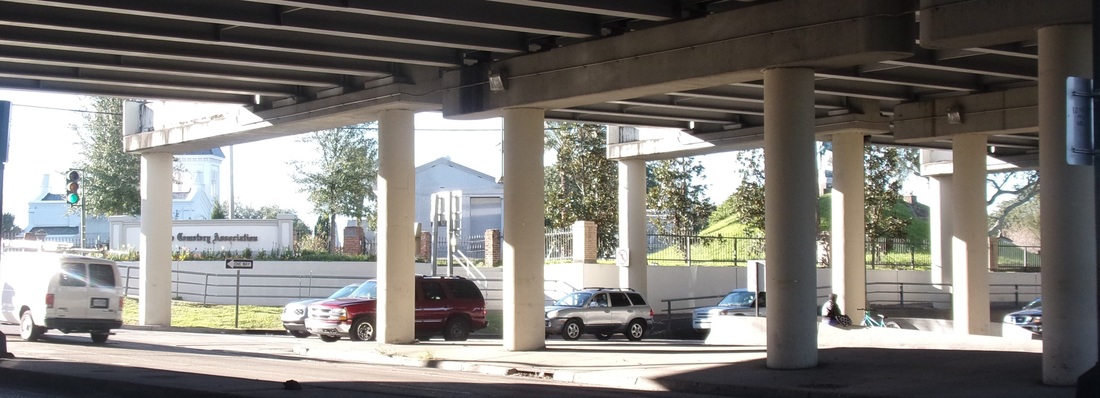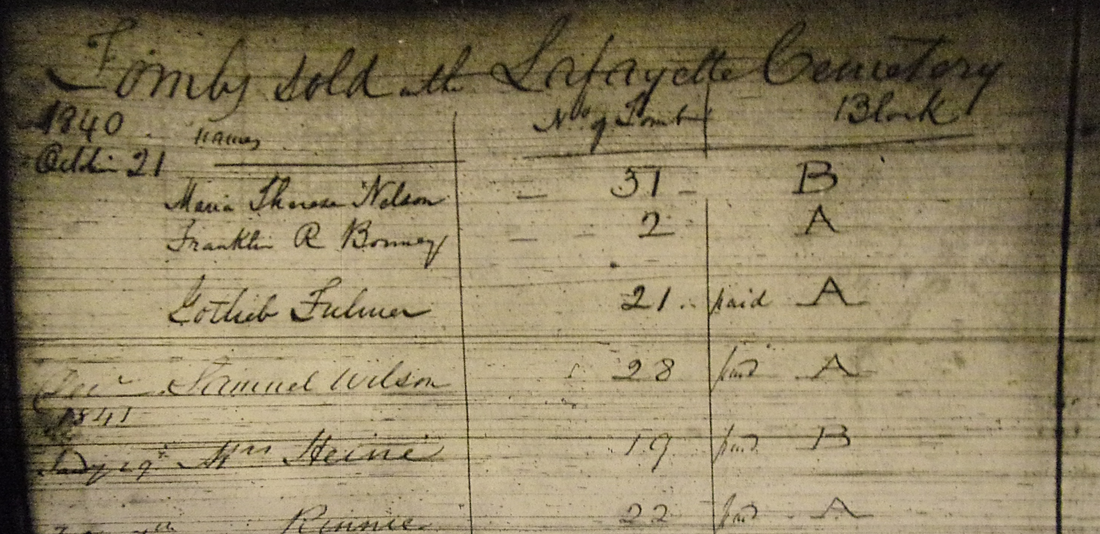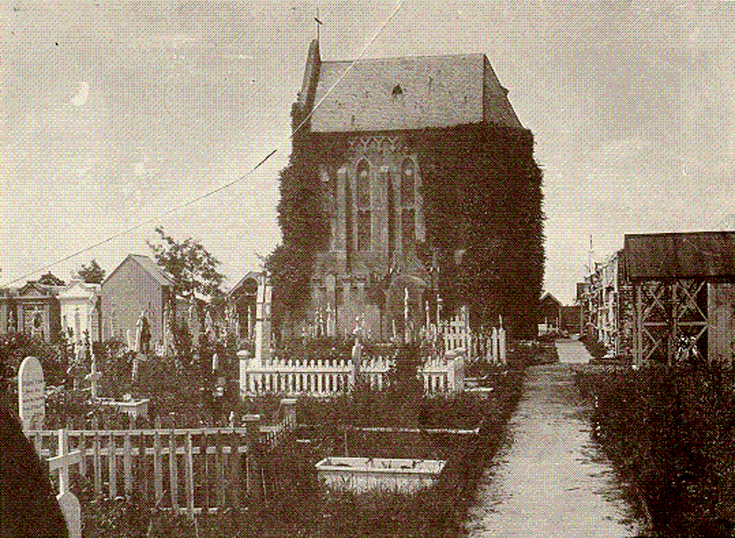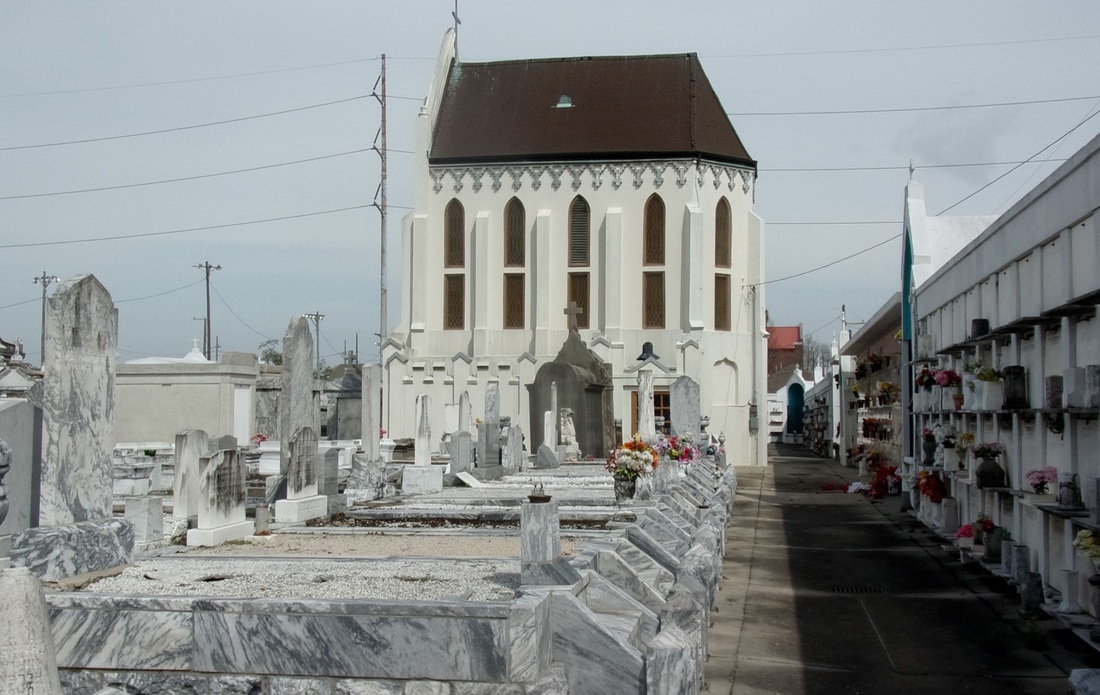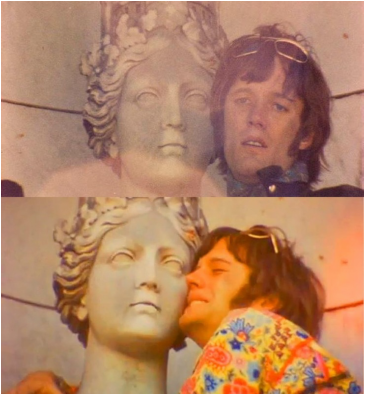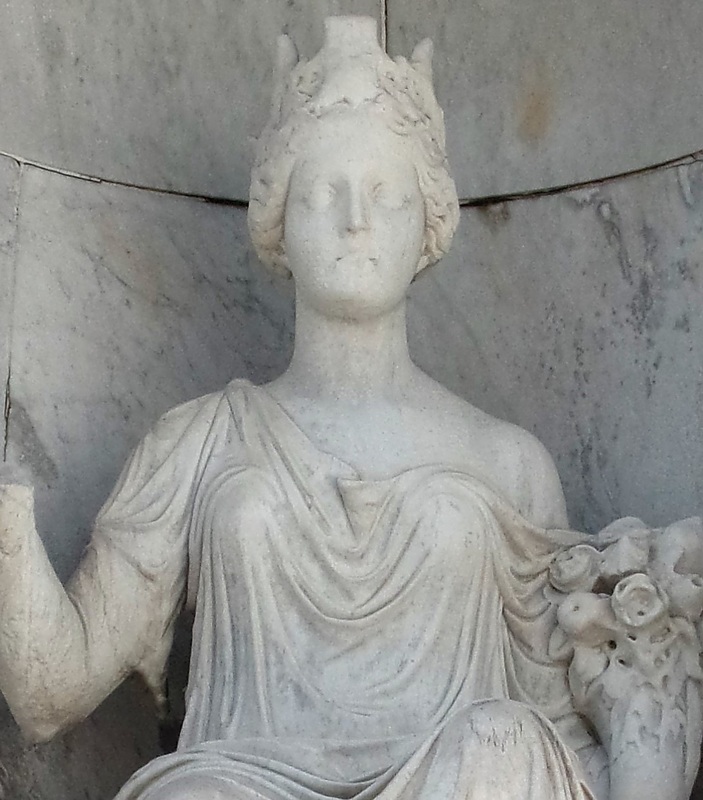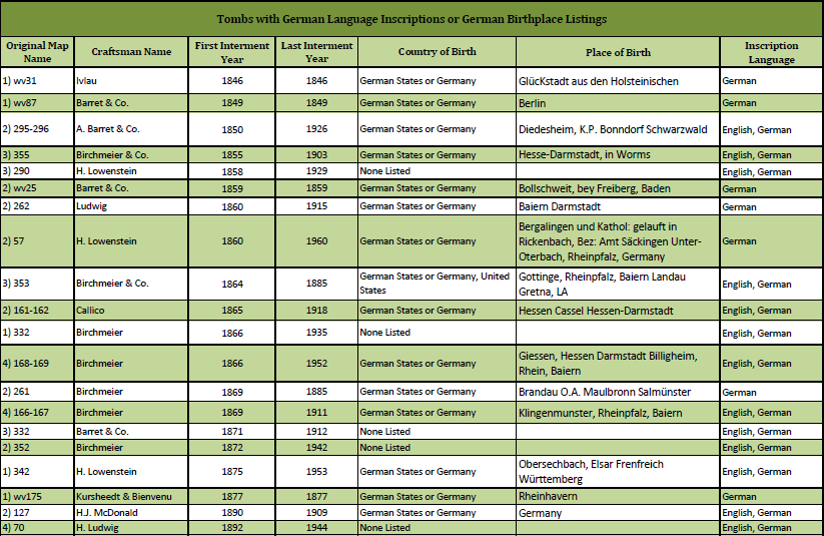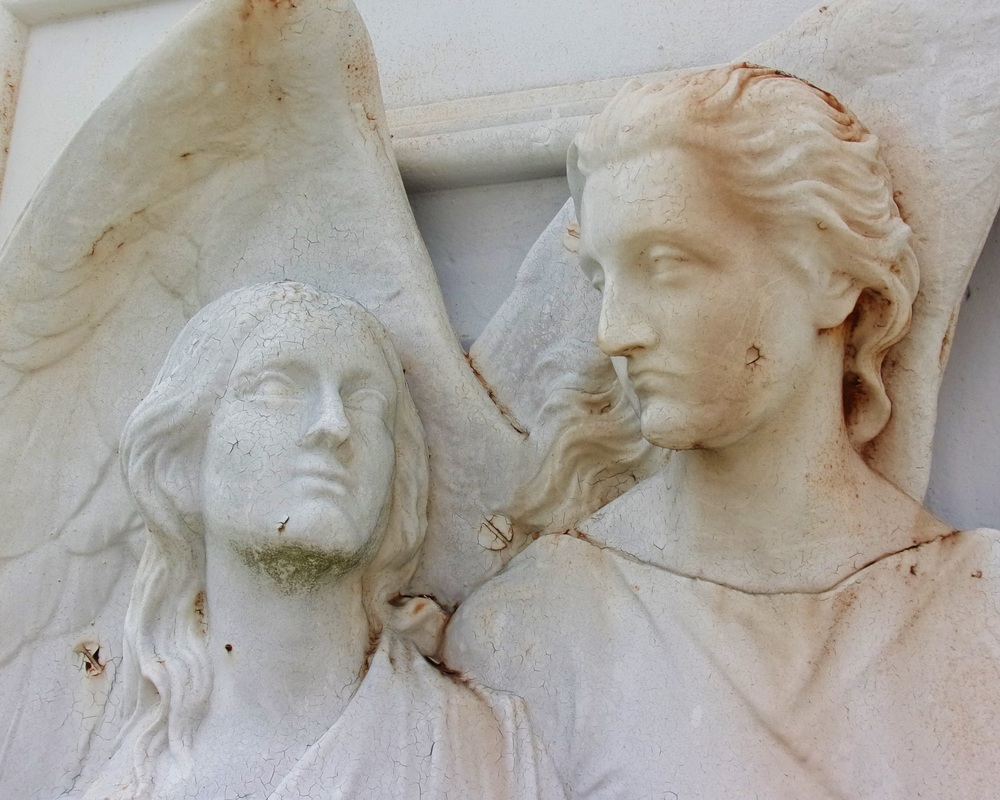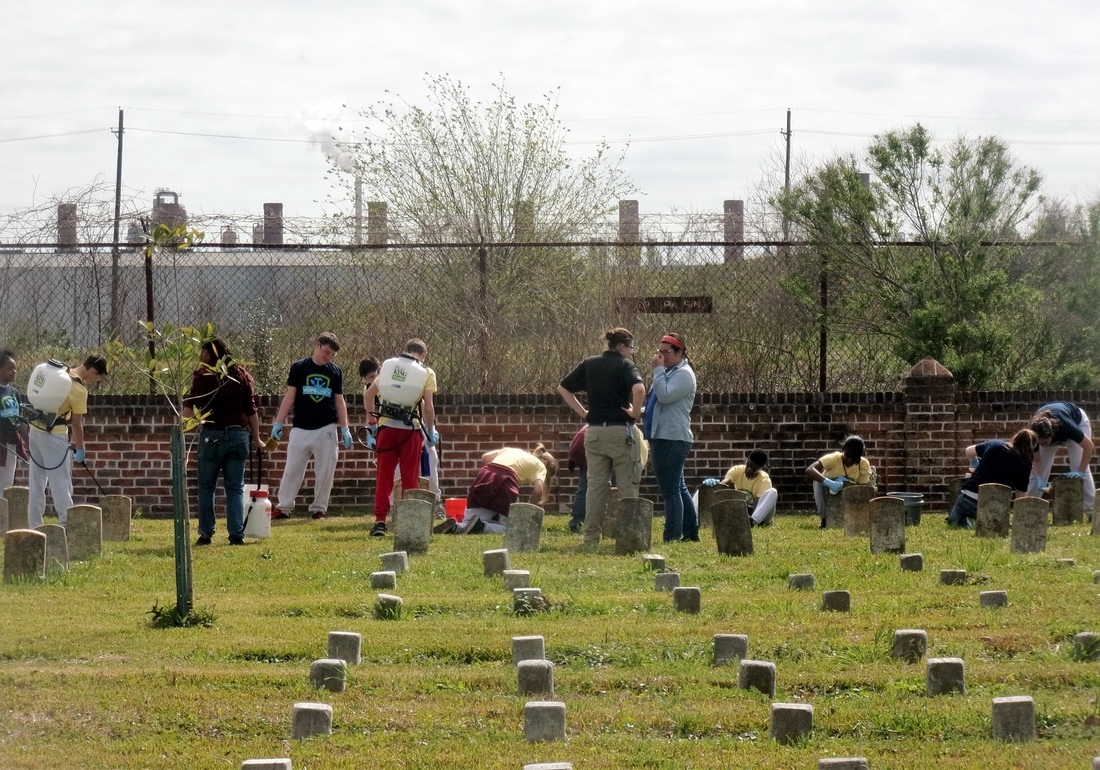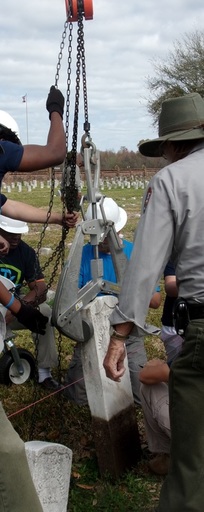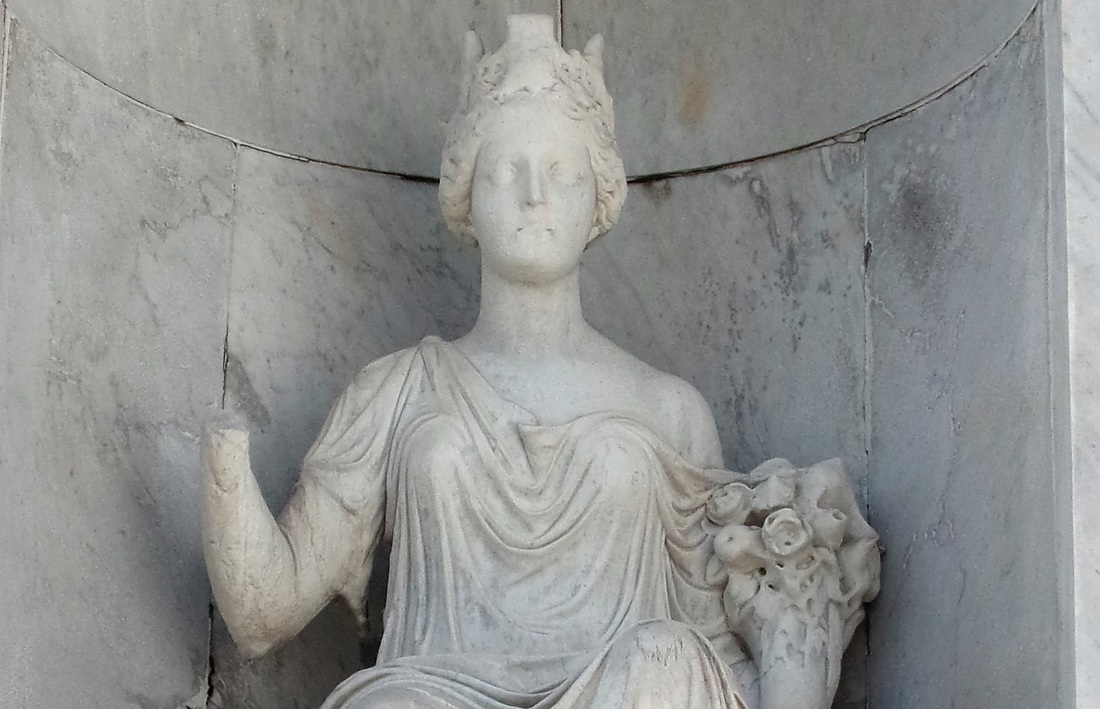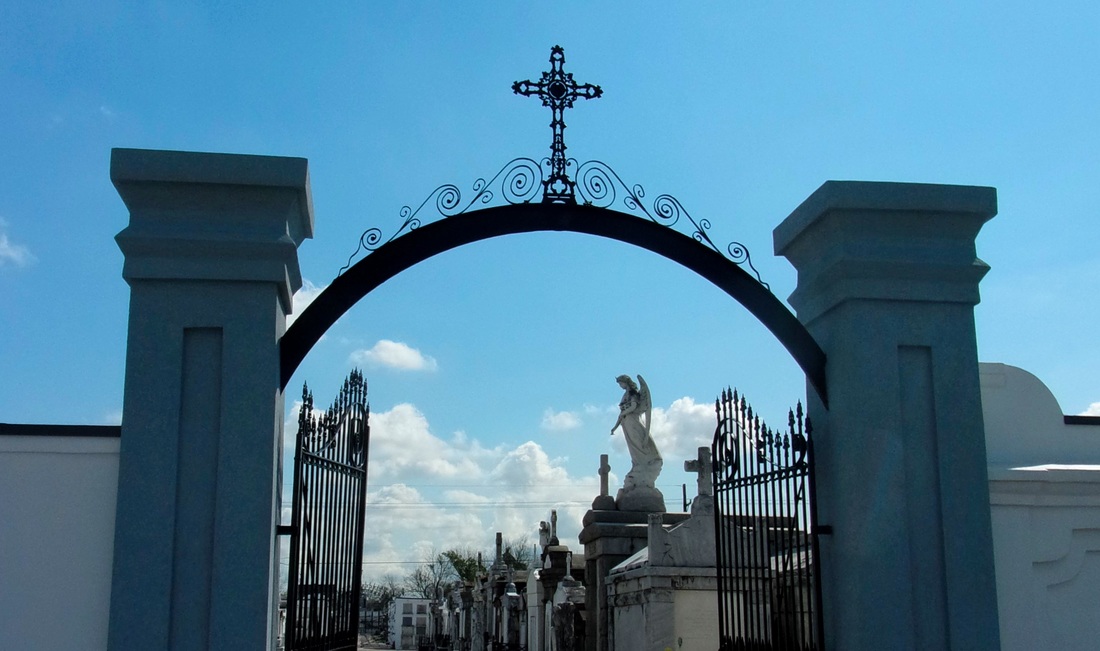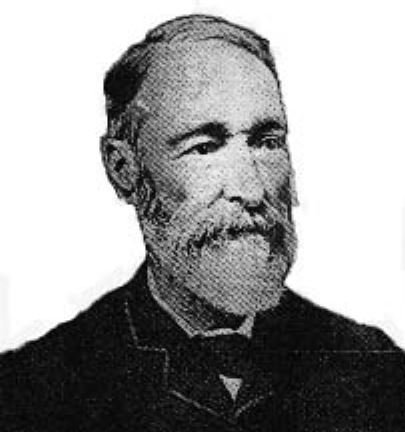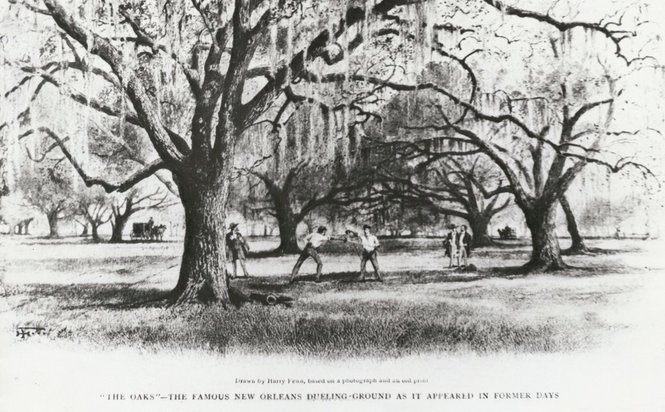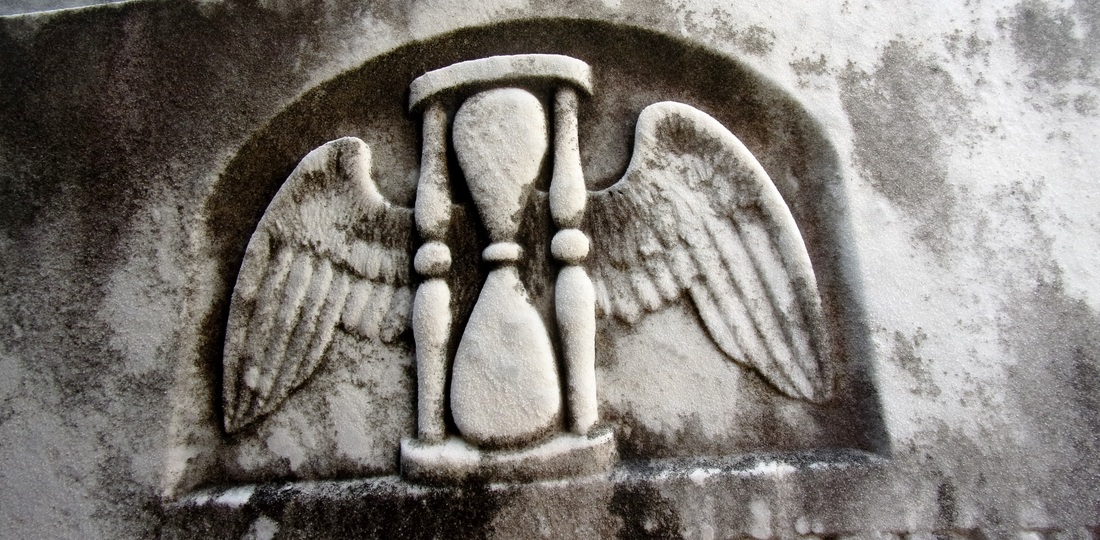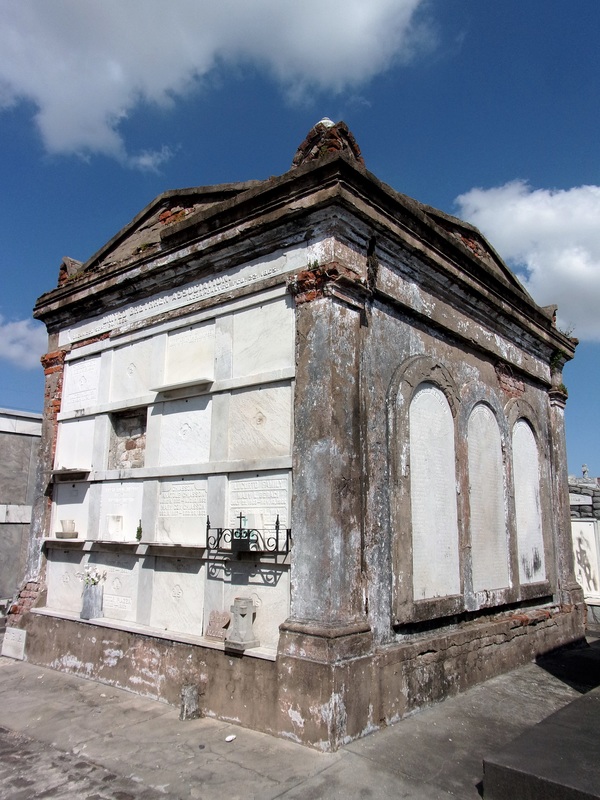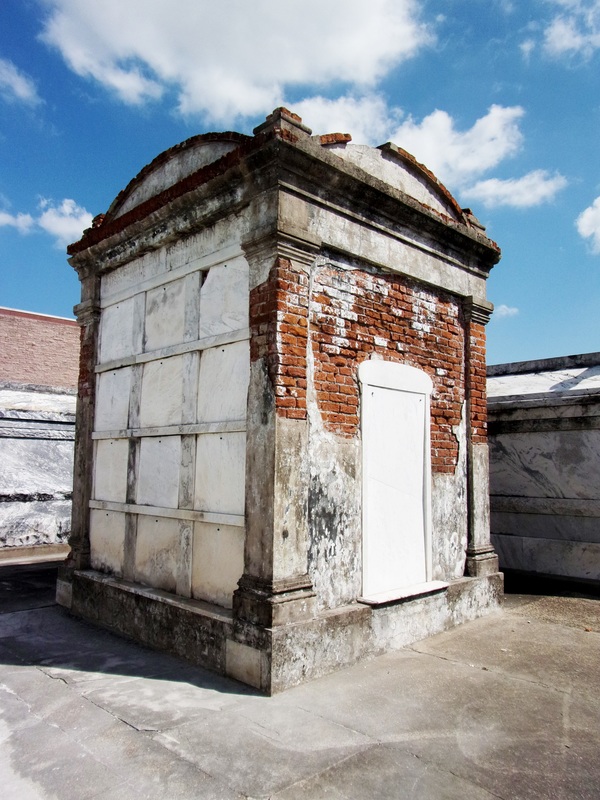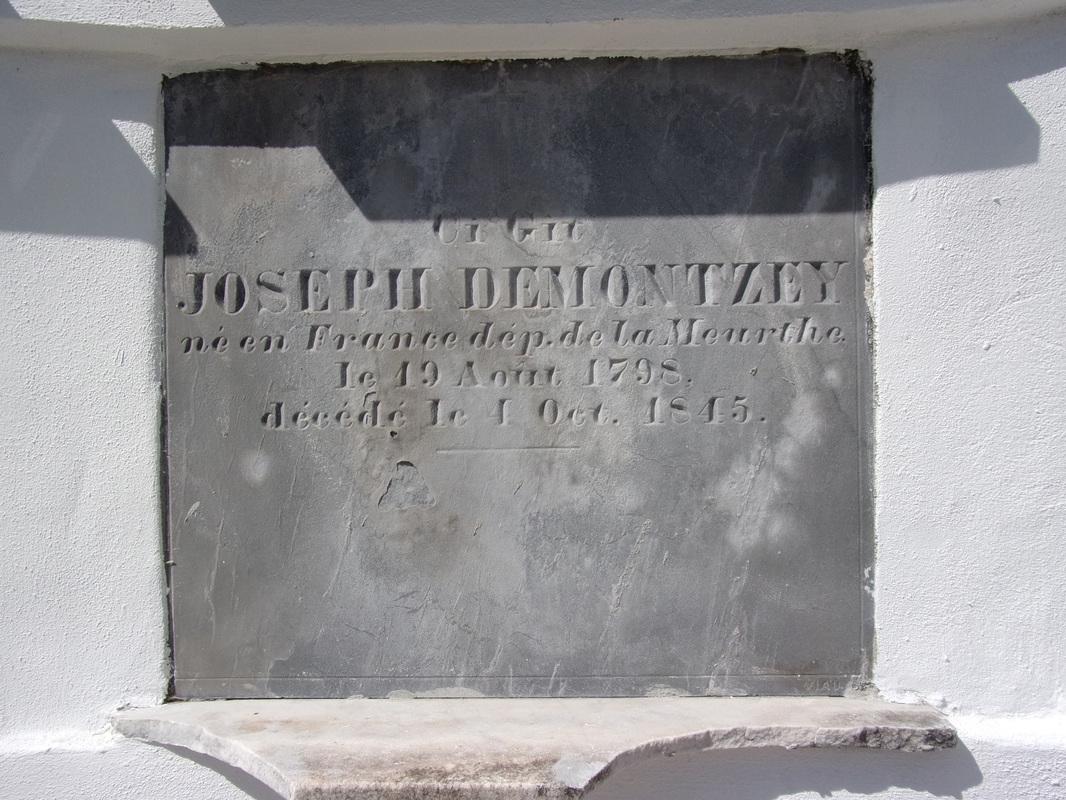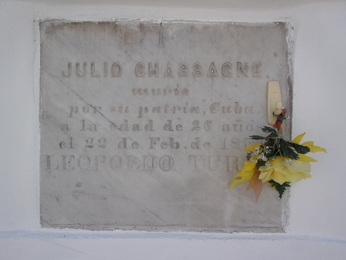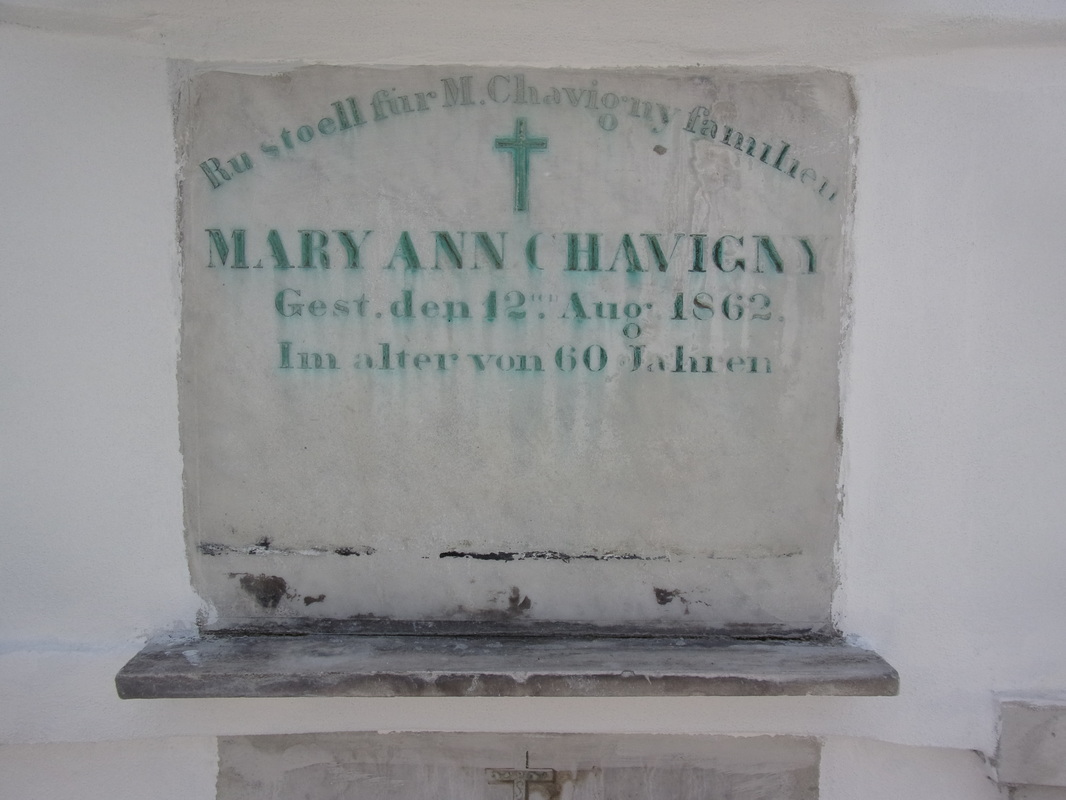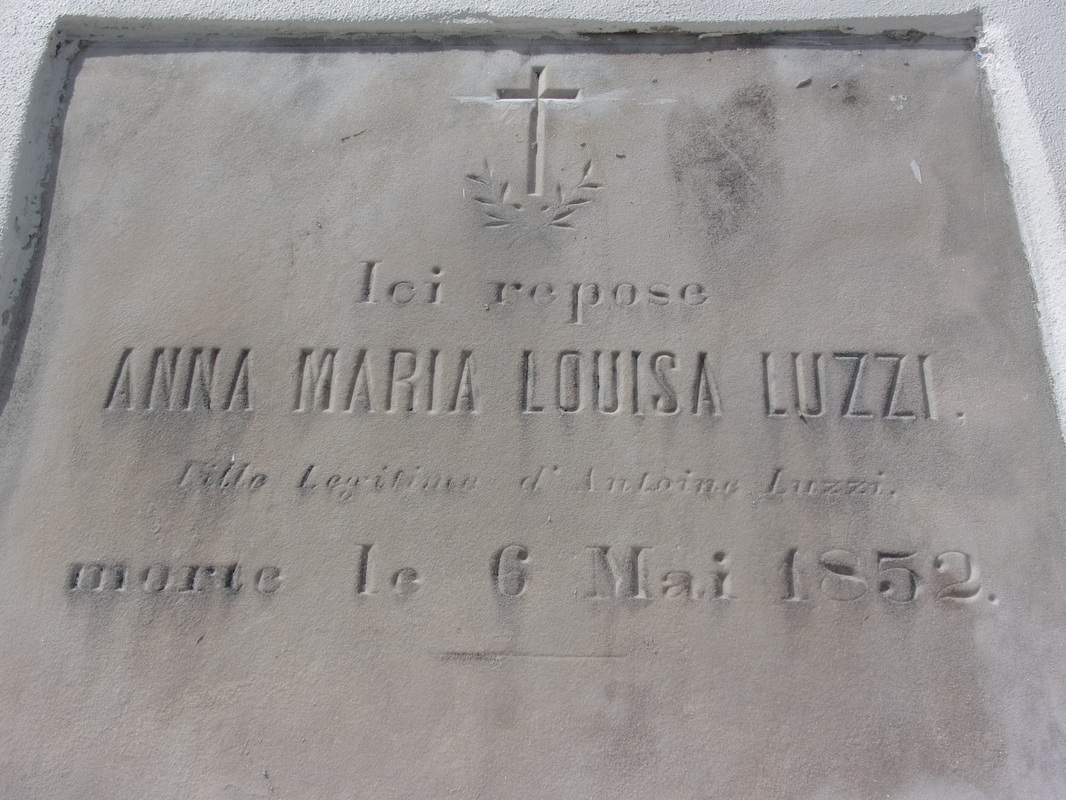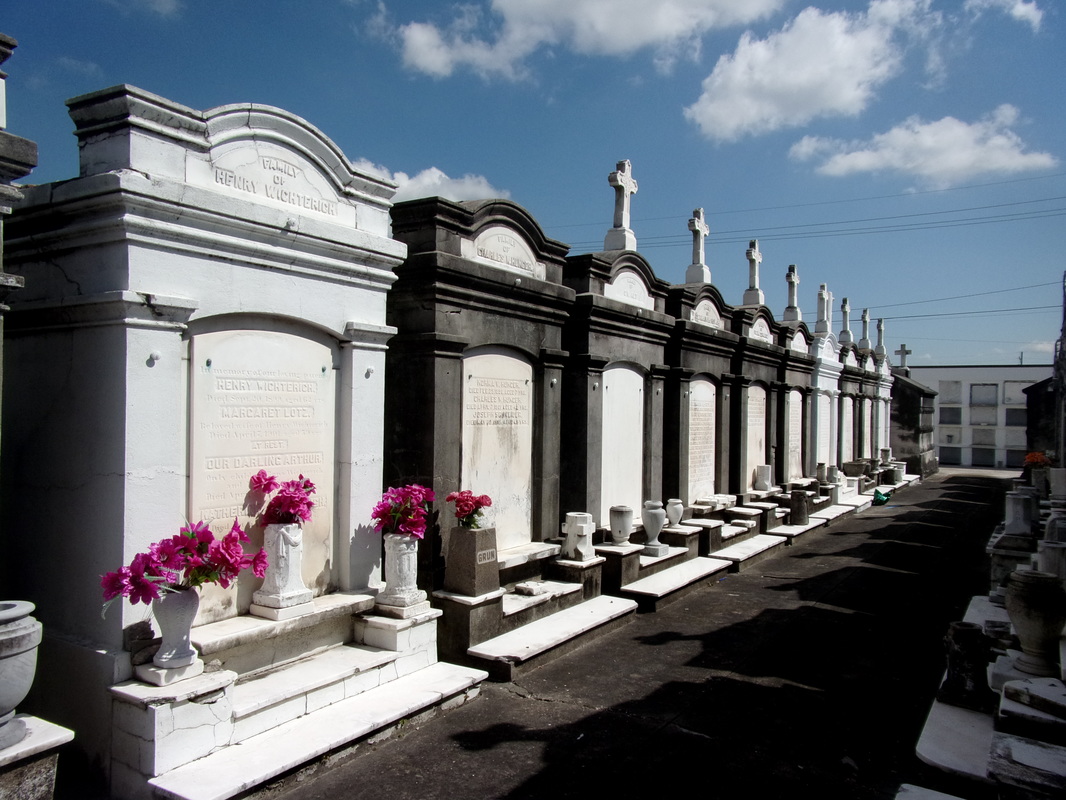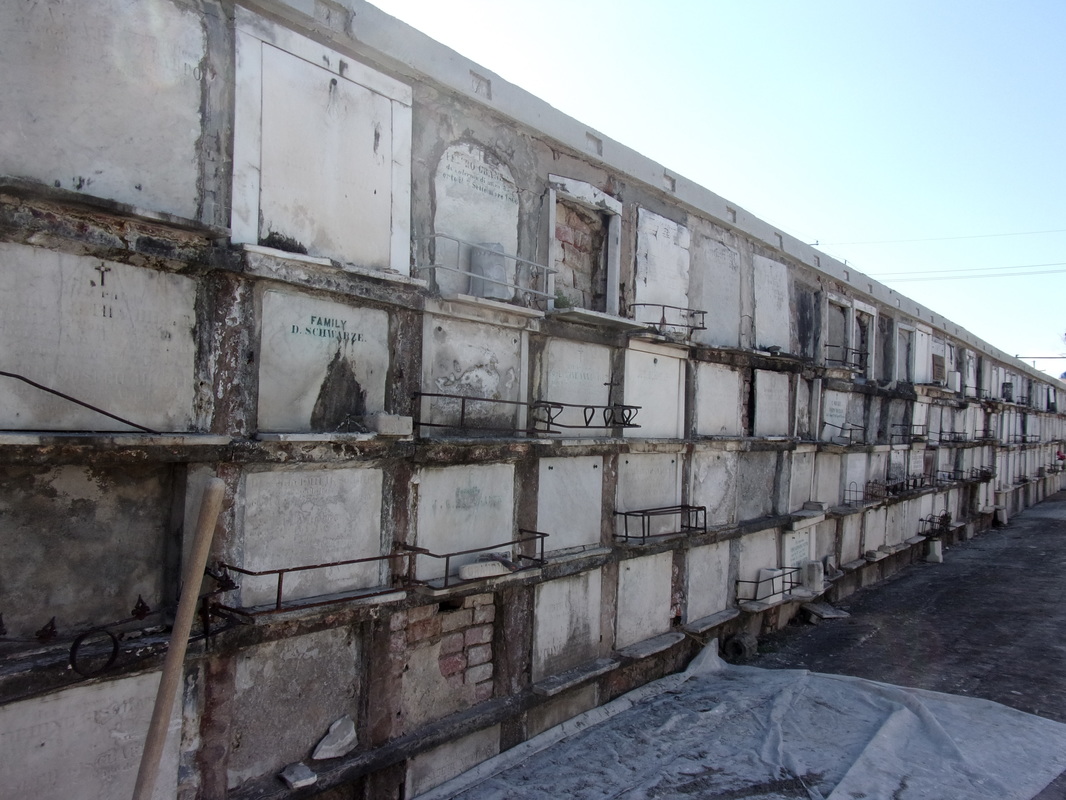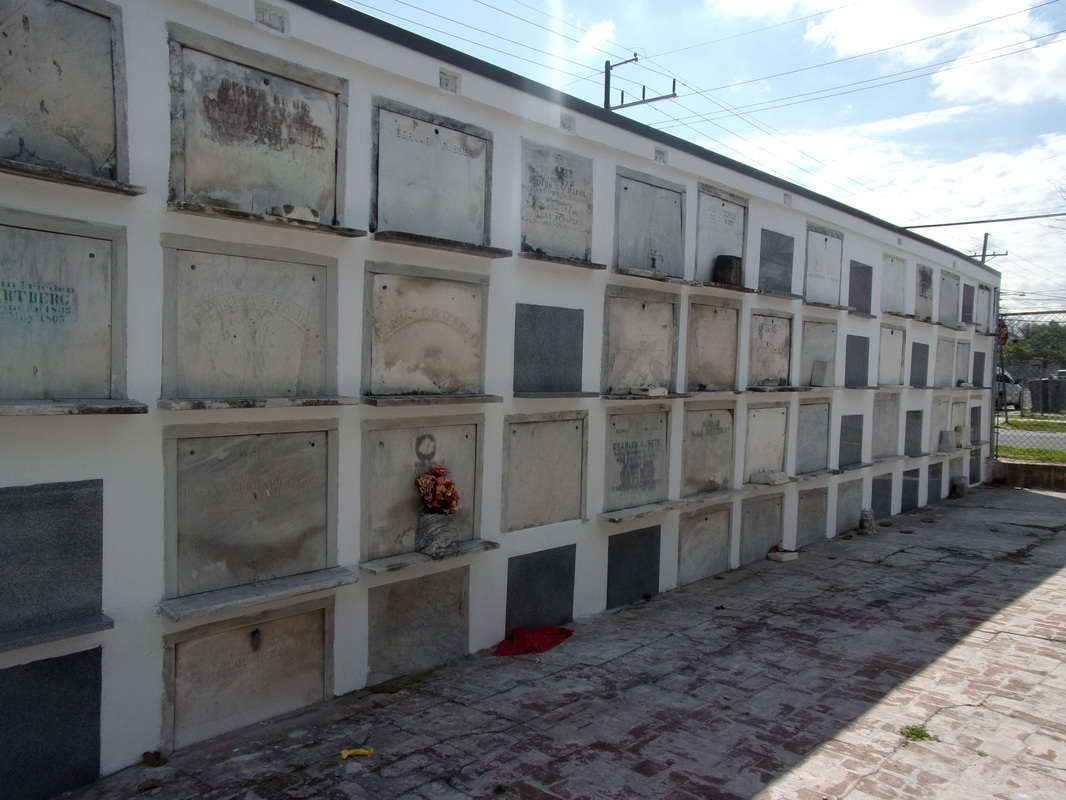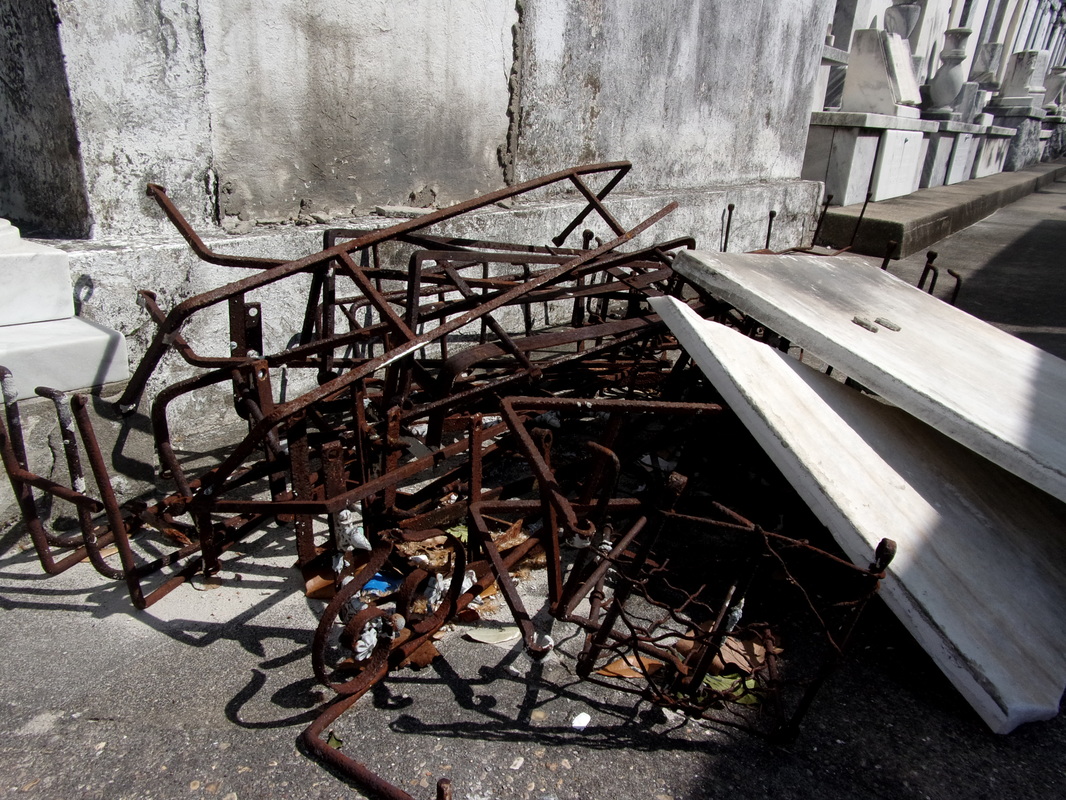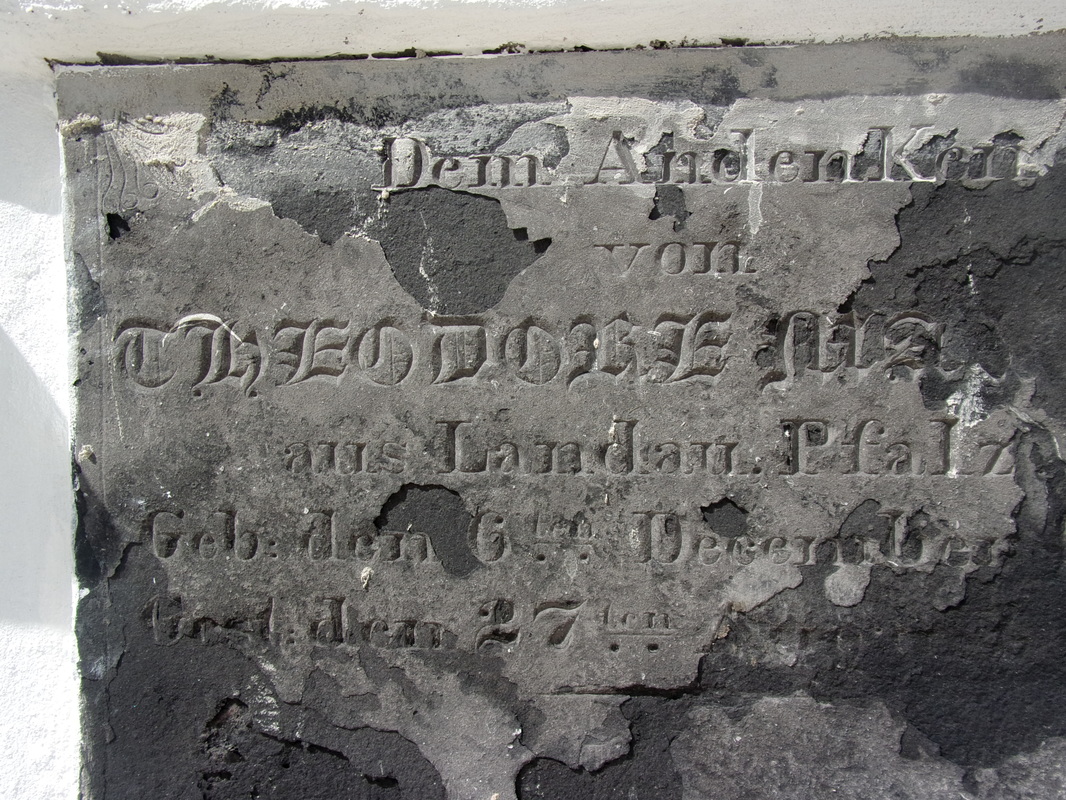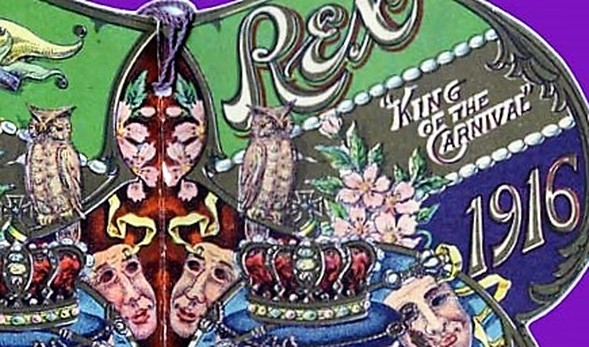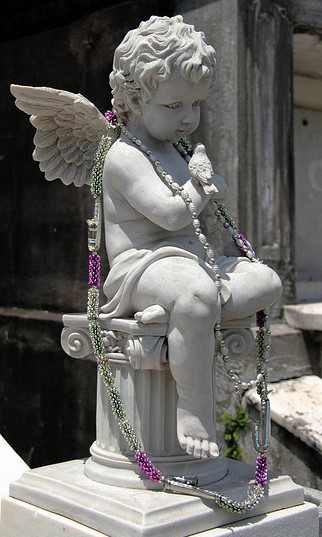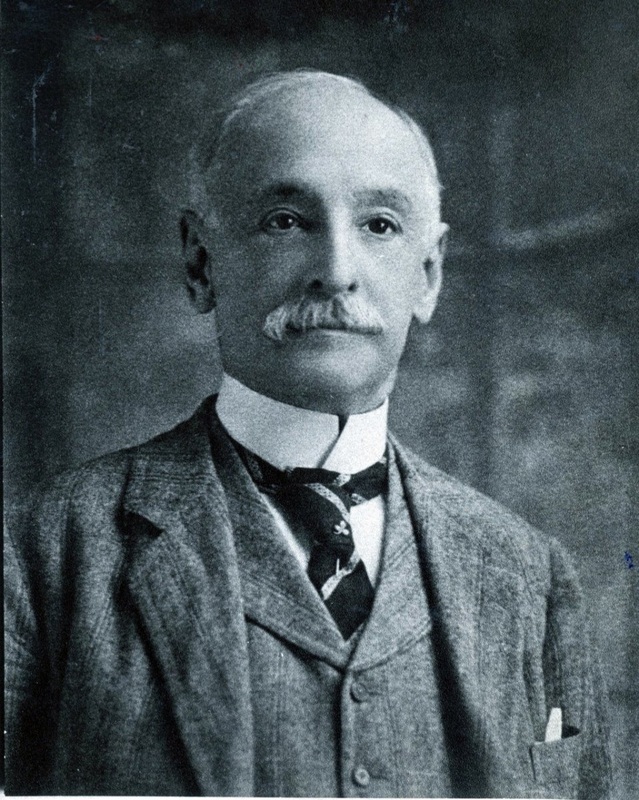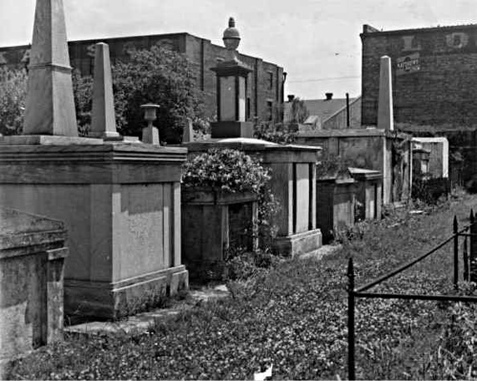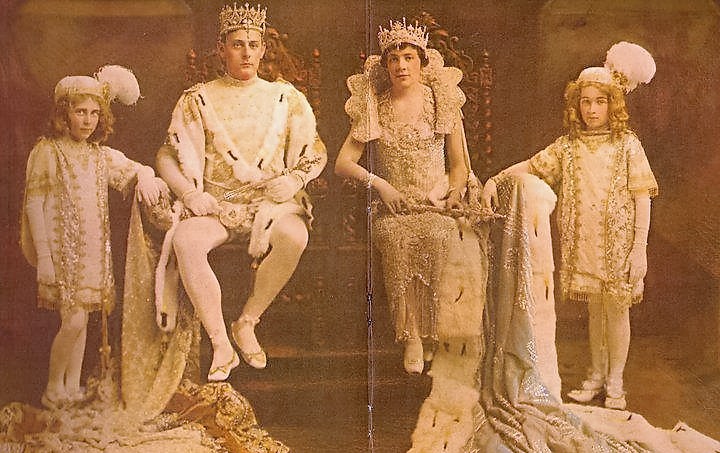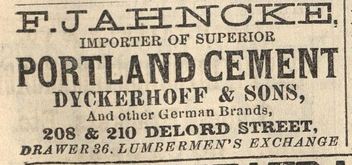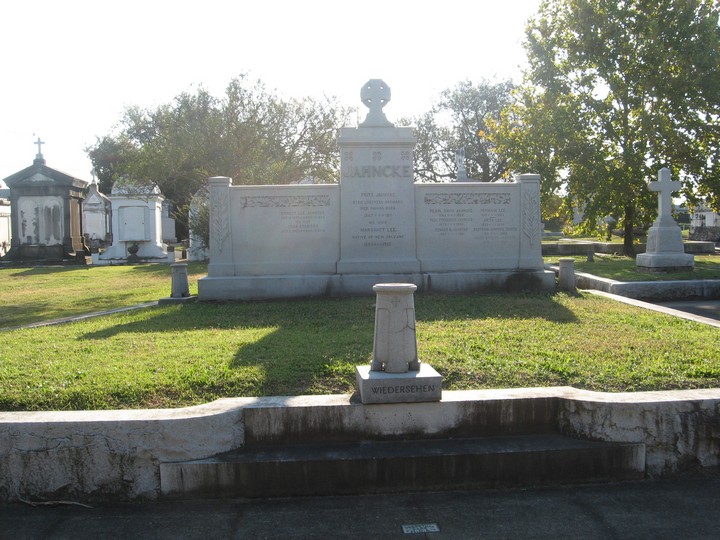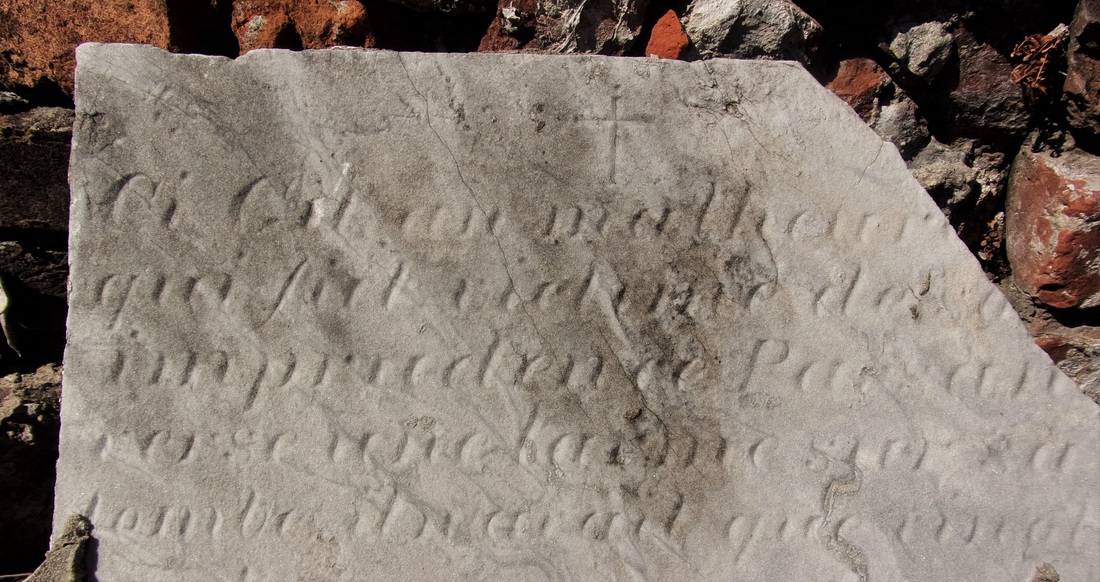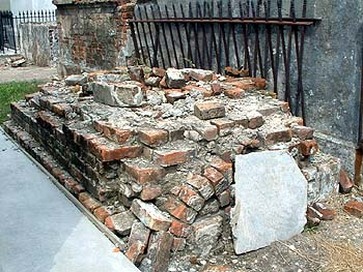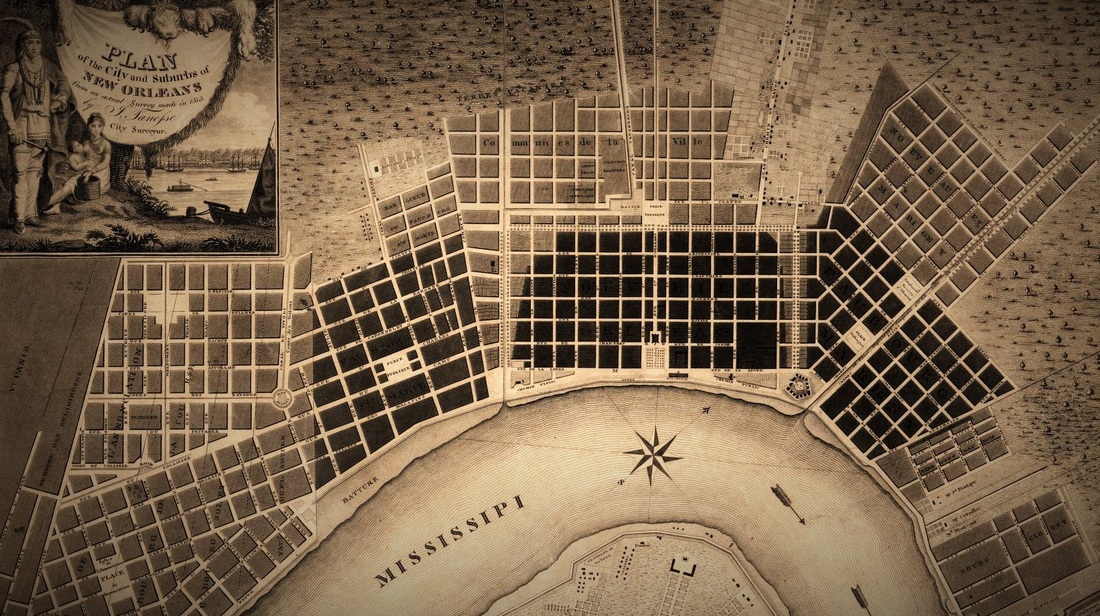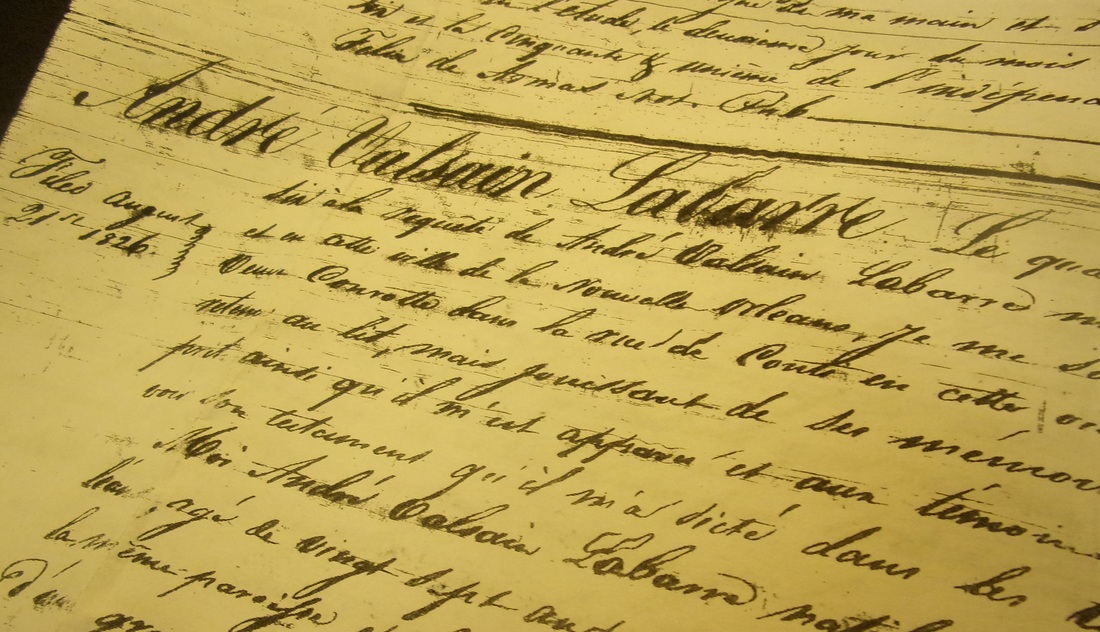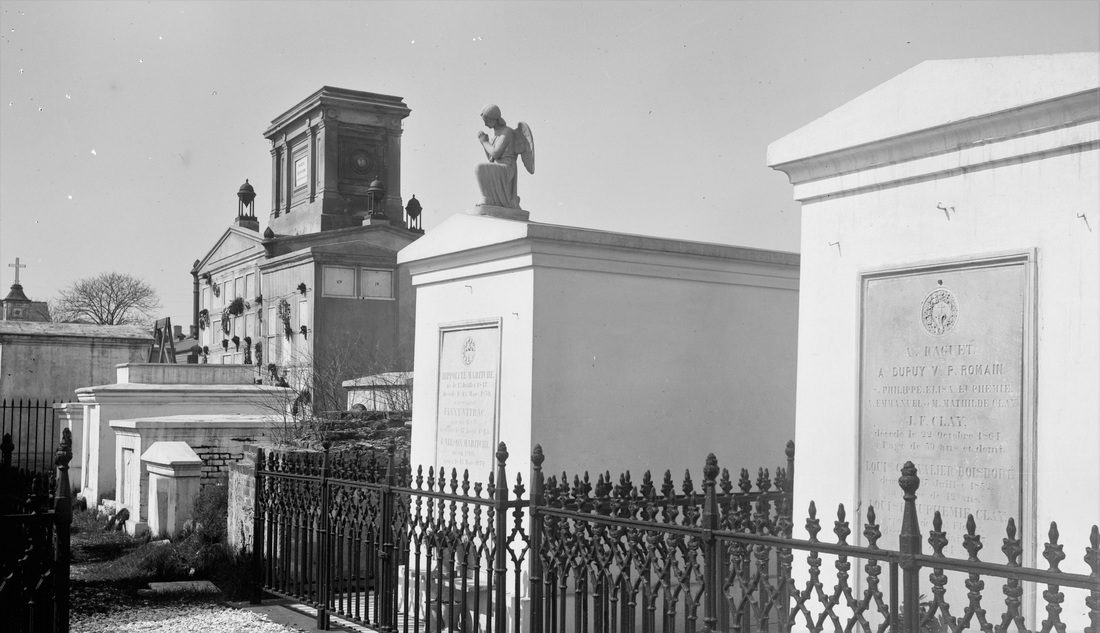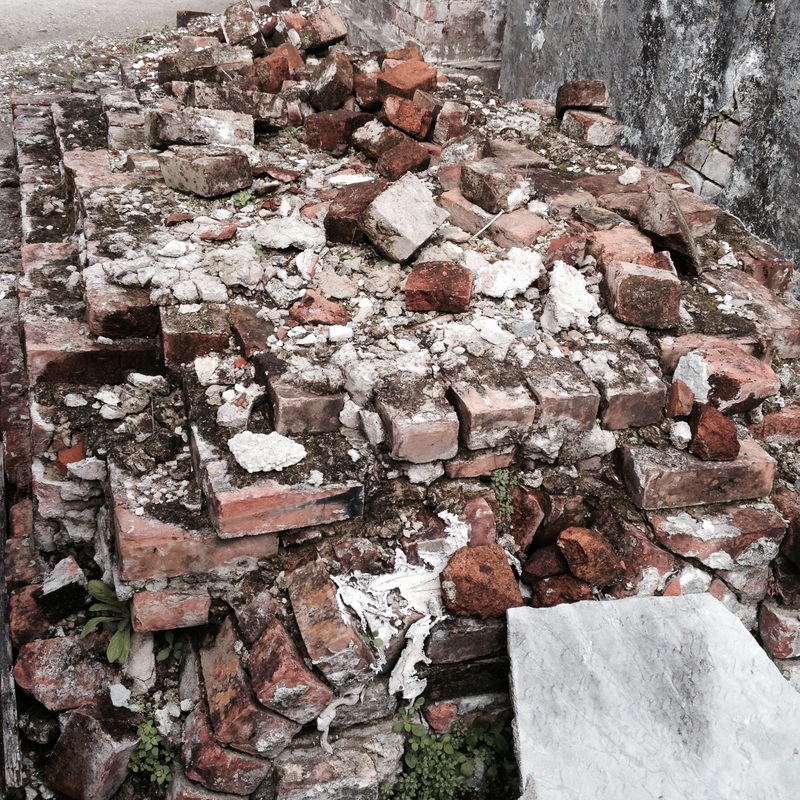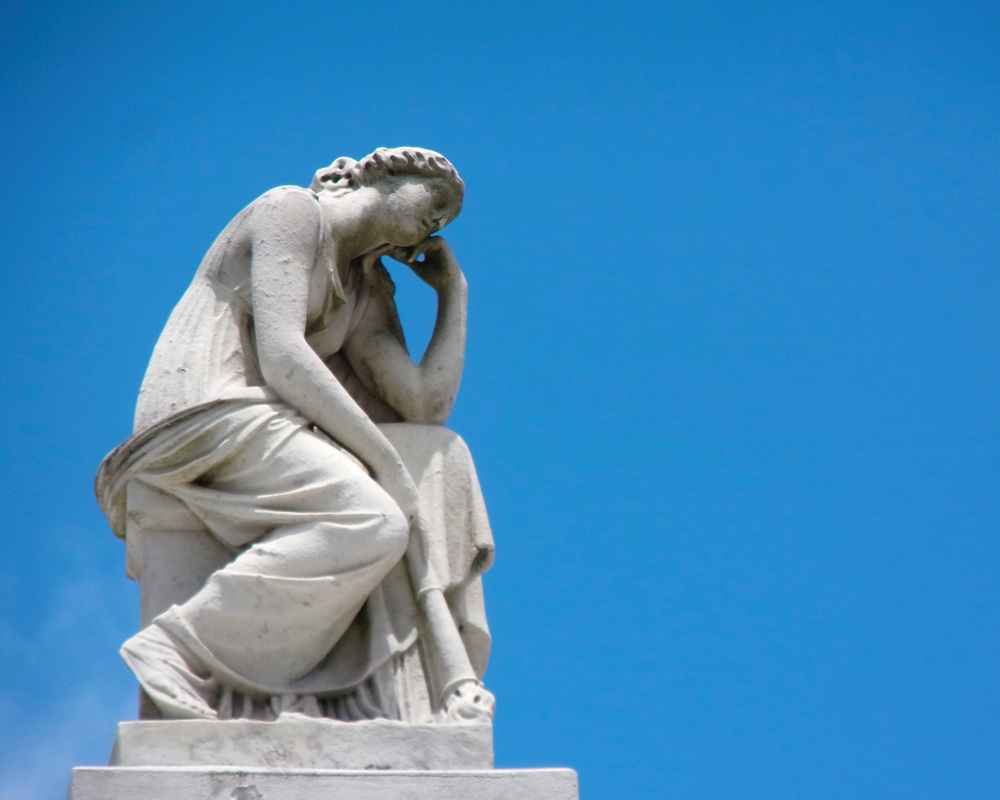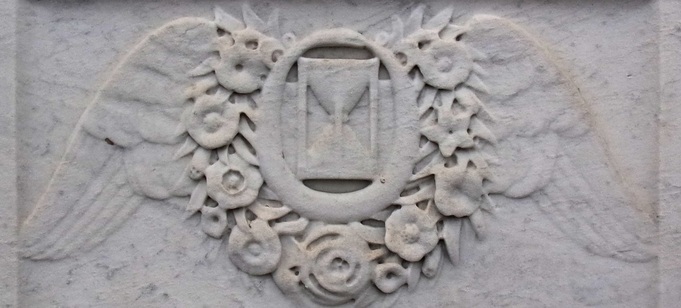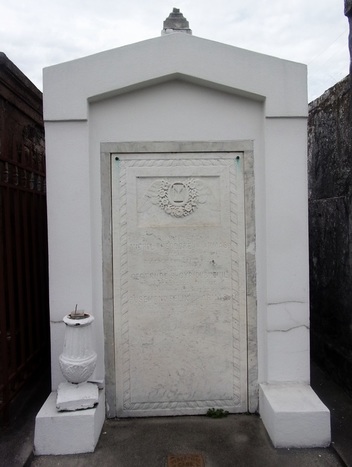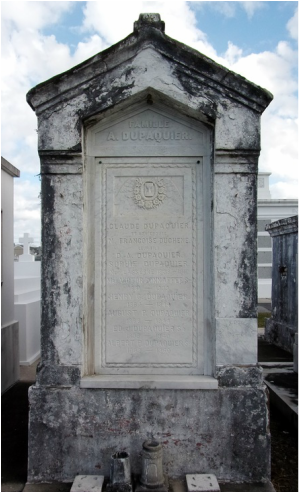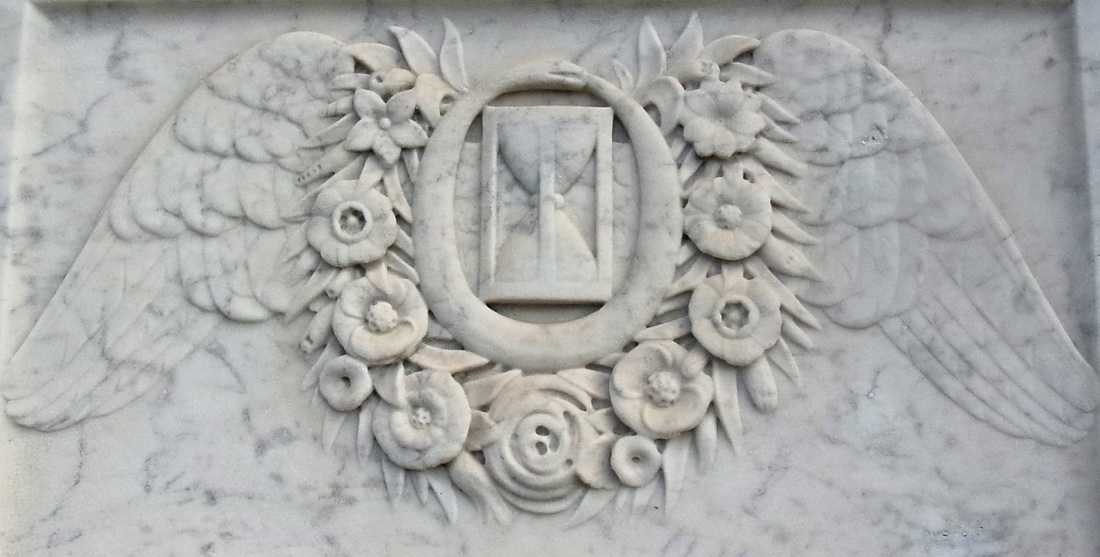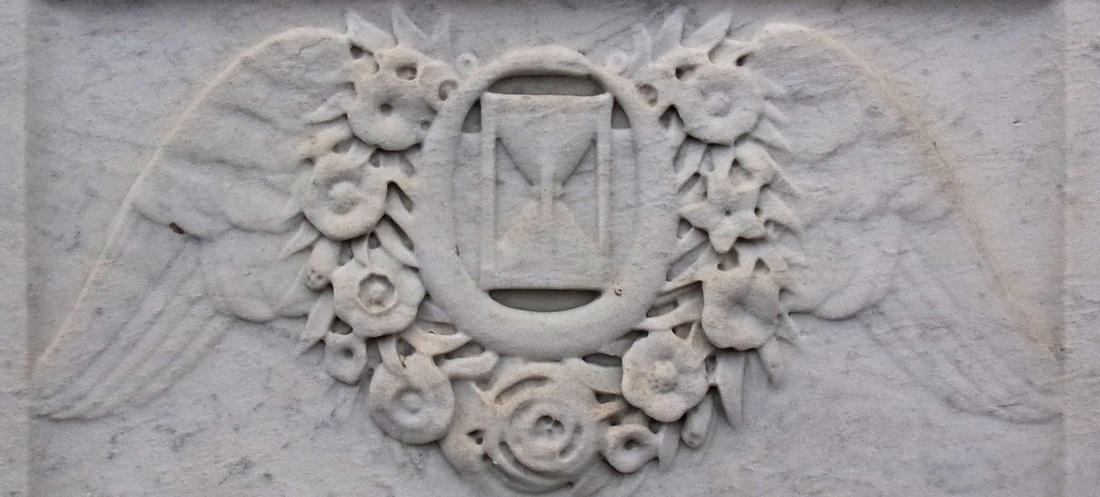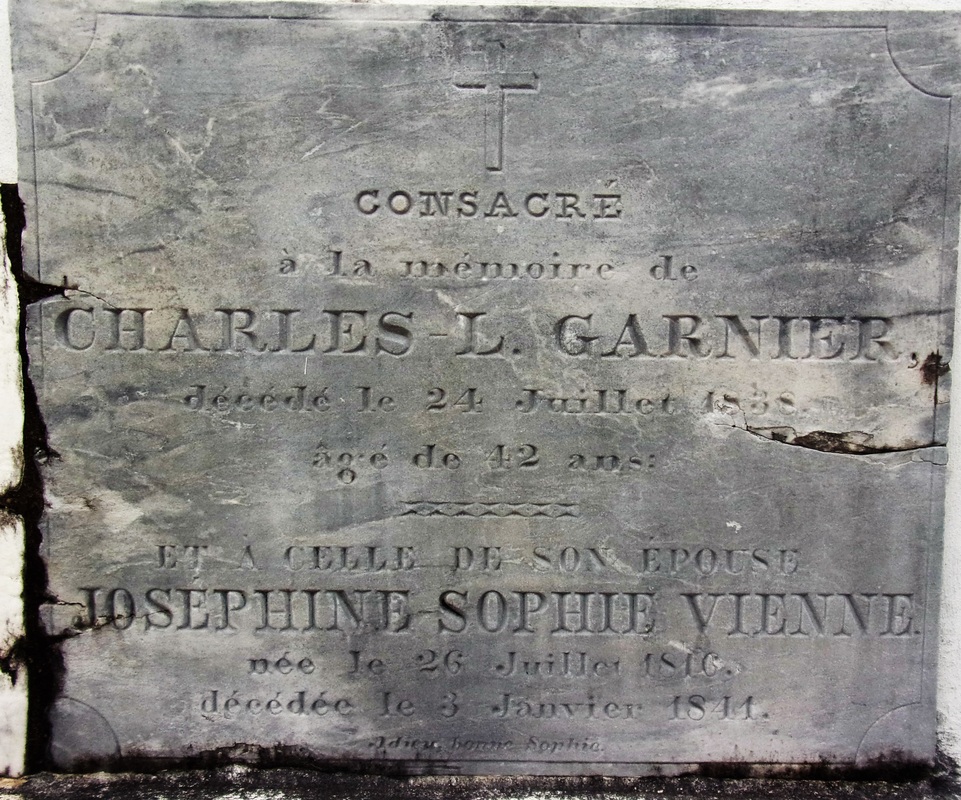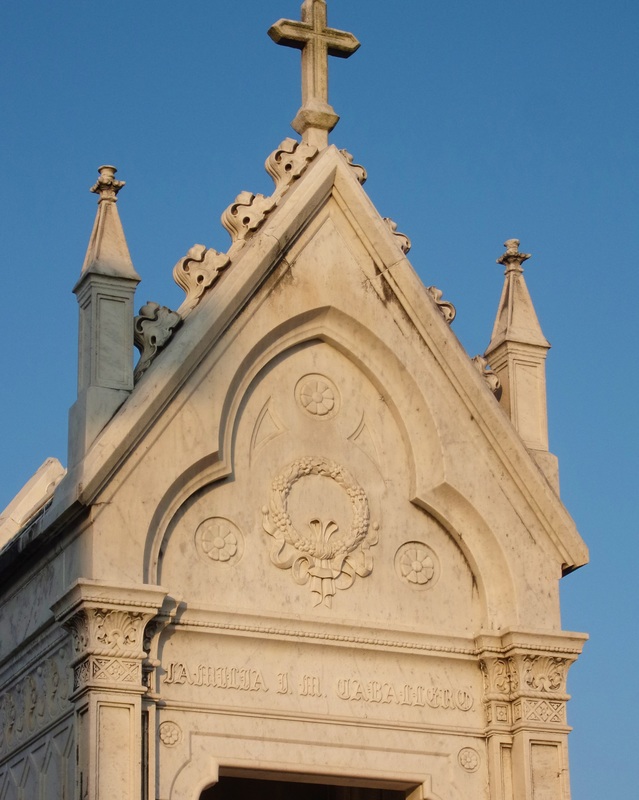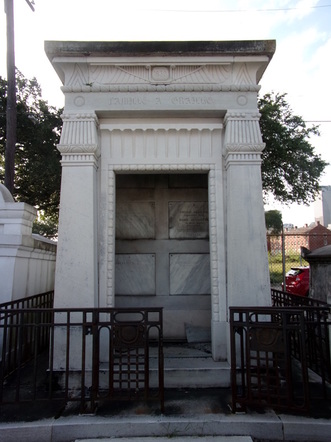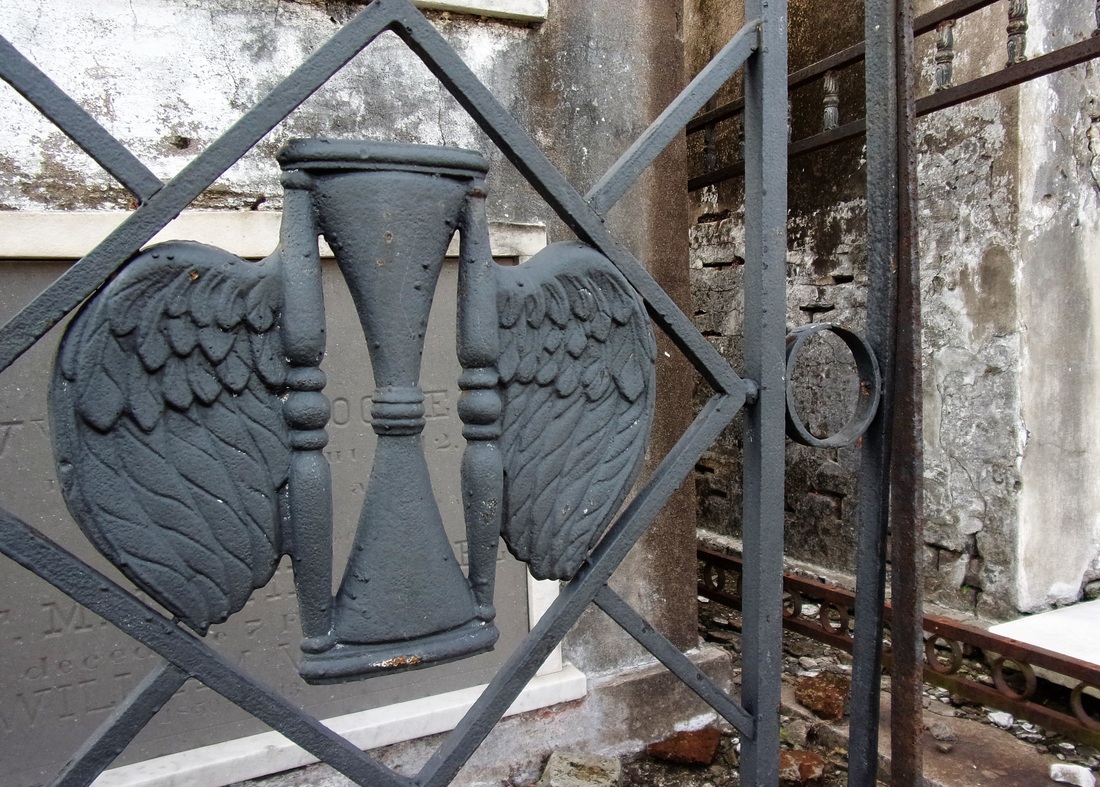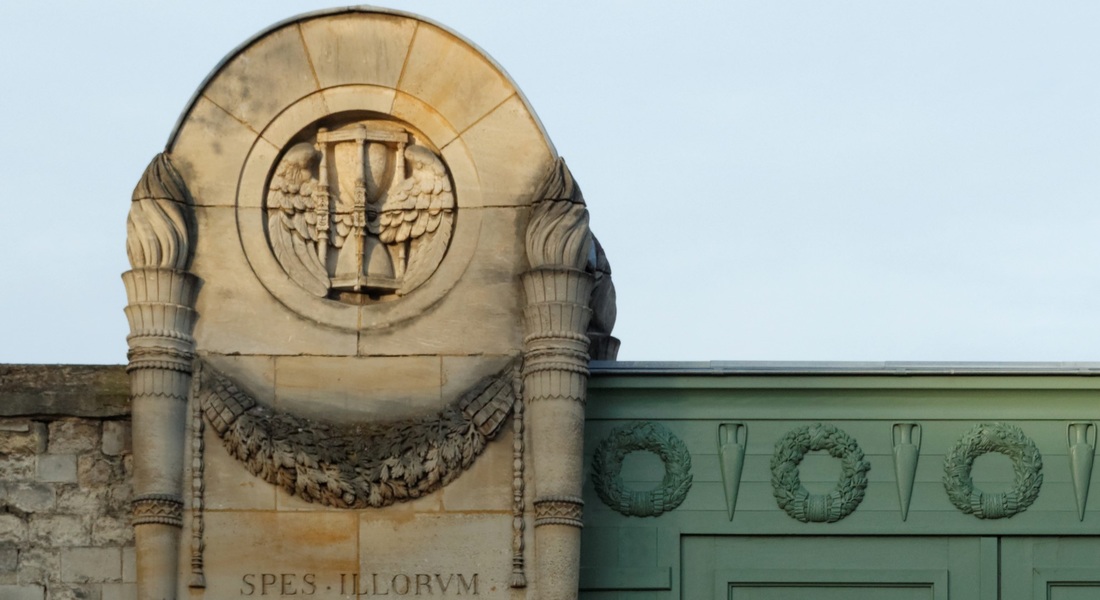|
This blog post is Part Two of a two-part piece on the tomb of the Sociètè Française de Bienfaisance et d’Assistance Mutuelle de Jefferson, located in Lafayette Cemetery No. 1. To learn about the history of this French Society, check out Part One here. Recently, Oak and Laurel Cemetery Preservation, LLC transcribed the burial records of the tomb of the Sociètè Française de Bienfaisance et d’Assistance Mutuelle de Jefferson, located in Lafayette Cemetery No. 2, thanks in part to a grant from genealogist Megan Smolenyak. The Society was absorbed by the Sociètè Française de Bienfaisance et d’Assistance Mutuelle de Nouvelle Orléans in 1900. About the Record Books The records of the Sociètè are housed at LSU Special Collections, Hill Memorial Library, in Baton Rouge. (MSS 318, 1012) The burial books appear to have been included with the larger collection of papers from the Sociètè Française de Bienfaisance et d’Assistance Mutuelle de Nouvelle Orléans (French Benevolent and Mutual Aid Society of New Orleans) which absorbed its Jefferson City counterpart in 1900. The collection is comprised of two books, dating from the tomb’s construction in 1872 through 1900. While later interments were certainly made in the Lafayette Cemetery No. 2 tomb, their record appears to have been incorporated into another, as-yet unstudied document. Within these two books are the burial documents for 186 individuals. Among these records, 142 people were buried in the society tomb in Lafayette Cemetery No. 2, 32 were provided formal burial aid by the society and were interred in family tombs throughout the city, and 12 were not specified as to burial location.[1] Each burial record documents the date and place of the individual’s birth, date and place of death, as well as cause of death and information regarding membership. These documents shed light on the lives of hundreds of people. They allude to intricate familial and professional relationships, personal tragedies, and public calamities. They offer a window into a rich community, the vestiges of which stand silent in this stately yet neglected tomb in Lafayette Cemetery No. 2. Today we share the stories of those buried within. The Foreign French: Founding Members and their Origins The Sociètè Française de Bienfaisance et d’Assistance Mutuelle de Jefferson was organized in 1868 by native-born French men – eight of whom are buried in the Lafayette No. 2 tomb. Much like the New Orleans French society, these immigrants sought fraternity among their countrymen. Incidentally (or perhaps not so much so), most of these men were born in the same French provinces (départments), and often in the same village. The majority of adults buried in the Sociètè tomb originated from two primary areas in continental France: the department now known as Midi-Pyrenees, including Gers, Haute-Pyrenees, Haute-Garonne, and Bass Pyrenees (now known as Pyrenees-Atlantiques), and the eastern departments of Alsace-Lorraine, specifically Haut-Rhin, Bas-Rhin, and Moselle. These two areas are nearly as geographically disparate as can be, with the former nestled along the Pyrenees mountains at the Spanish border, and the latter at the Rhine River beside present-day Germany.
In Alsace-Lorraine, a different climate motivated the eventual members of the Sociètè to emigrate from their homes. The Franco-Prussian War (1870-1871) forced many Alsatians from their homeland when the controls of the provinces shifted from France to newly-nationalized Germany. For French-speaking Alsatians, both Jewish and gentile, German citizenship was a less than desirable option. New Orleans was an attractive alternative due to its Francophone tradition. Among these Alsatian emigrants were sisters Catherine and Marie Sonntag, both in their early twenties from Altinstadt, Alsace. Nieces of Sociètè member O.M. Redon, they both died of yellow fever within weeks of each other in October 1872. They were buried in vaults 20 and 22 of the Lafayette No. 2 society tomb. While the people buried in this tomb overwhelmingly shared a linguistic and cultural bond, there is no shortage of strangers among the burials in Lafayette Cemetery No. 2. Although the tomb was built for French society members, those members were not always French. Strangers in a Strange Land: Non-French Buried in the French Tomb A handful of foreign-born non-French people were laid to rest in the Lafayette Cemetery No. 2 society tomb. Their stories contribute to the greater narrative of the society which at its heart was thoroughly New Orleanean in its cultural interactions. From Germany, Catherine Deffenback and brothers John and Jacob Schwenck were buried in this tomb at their time of death. The Schwenck brothers owned a saloon together on Magazine Street.[3] Leon Vignes, from Mont-de-Marrast, France, mourned the death of his Irish-born wife, Margaret, in 1884. She is buried in vault 35. Leon died fifteen years later and was buried in vault 38. He was not the only person to join the matrimonial melting pot: The wife of J.M. Gelé was born in England and died in 1872, buried in vault 26. Perhaps the most interesting foreign-born member of the society is not buried in the Lafayette No. 2 tomb but instead only blocks away in Lafayette Cemetery No. 1, although no tablet remains to mark his name. Louis Savini was born in 1830 in Mortara, Italy. By the time he was eleven years old, he and his family had taken residence in New Orleans. From the very scant documentation remaining, Savini appears to have led a colorful life. He owned a saloon in what is now the Central Business District on Common Street, near the Mississippi River.[4] For reasons unclear from available records, Savini joined the Sociètè Française de Bienfaisance et d’Assistance Mutuelle de Jefferson in 1874. Only months after joining the group, however, Savini was struck down by a “cerebral fever,” which could indicate encephalitis, meningitis, or scarlet fever. He died on June 1, 1874 in his home on Poydras Street. The Sociètè not only furnished his burial in Lafayette Cemetery No. 1, but also provided a procession befitting a French society member. Savini was buried in the tomb of his brother, Paul Savini, in Quadrant 2 of Lafayette Cemetery No. 1. Today, the tomb is in a state of dangerous neglect and has lost the closure tablet bearing Louis Savini’s name. As the Sociètè aged, its members increasingly were New Orleans natives. Over time, both the children of members and other Francophone Louisianans joined, advancing the process of assimilation in a new country. The Family Tomb At least one hundred and forty-two individuals are buried in the Sociètè Française de Bienfaisance et d’Assistance Mutuelle de Jefferson tomb in Lafayette Cemetery No. 2. Some were recent immigrants with little or no family left behind. For a striking number of society members, however, the tomb was the final resting place for multiple generations. It has already been noted that Leon and Margaret Vignes rest near each other in this tomb. They are also interred with their son, Joseph, who drowned at the age of 14 in 1891. He is interred in the same vault as his mother. The Fortassin family likely also utilized the society tomb for the interment of multiple generations. In 1870, twenty year-old Gabriel Fortassin, Jr., arrived in New Orleans from Trie, France. His parents joined him as well. In 1882, he married Alexandrine Claverotte.[5] The two would briefly move to San Antonio, Texas before returning to New Orleans. In his lifetime, Gabriel would bury his parents in the society tomb, as well as five of his infant children. When he died in 1927, he was given a French Society burial in Lafayette Cemetery No. 2.[6] One of Gabriel’s adult sons, Baptiste Fortassin was also buried in Lafayette Cemetery No. 2, in 1929. Two years later, Baptiste’s widow Marie Maille joined him. With no Fortassin tomb in Lafayette Cemetery No. 2, it is very likely they joined their relatives in this tomb, making it the last resting place of three generations of one family, with at least nine burials.[7] Other families utilized the society tomb similarly. Surnames such as Tujague[8], Abadie, Mouledous[9], Vignes, and Carrare appear multiple times through the burial books, representing multiple generations. These records also show combinations of the above-mentioned names, linked by intermarriage. Eleanor Vignes Tujague and Pauline Mouledous Tujague are both buried in the Lafayette Cemetery No. 2 society tomb. Society members formed a strong, interdependent community. They even stood at each other’s deathbeds to witness a last will and testament.[10] Death and burial were only the final threads that tied these French-speaking New Orleaneans together. In life, they lived and worked beside one another. As the French Society of Jefferson, members lived predominately within the boundaries of the former Jefferson suburb (portions of present-day Garden District, Irish Channel, Central City, and Uptown neighborhoods). Burial records note the residences of a multitude of members as near the St. Mary’s Market and along Tchoupitoulas Street. Even more records note residence as simply “aux abbatoirs,” or “near the slaughterhouses.” Which is no surprise: the majorit of members were butchers. A Workingman’s Society The Sociètè Française de Bienfaisance et d’Assistance Mutuelle de Jefferson shared members and celebrated social events with the Sociètè de Bienfaisance des Bouchers, or the French Butchers Society. Their enormous, eighty-vault society tomb remains also in Lafayette Cemetery No. 2. Members of each society lived near the Mississippi River, where cattle were unloaded at river docks. Until the late 1860s, the City of New Orleans had little regulation regarding the slaughter of livestock. Butchers were free to practice their trade where they pleased, usually near a market where they could sell their wares. This changed with a municipal law that required butchers slaughter livestock exclusively in a city-owned slaughterhouse, the goal of which was to prevent public health hazards.[11] Opposition to this law among butchers of both French societies led to civil unrest and years of legal battles. The case finally reached the Supreme Court in a landmark ruling known as the Slaughterhouse Case. Among the French and Butchers societies, the butcher’s trade was passed through generations and within a tight-knit community. Members lived in close proximity to each other, with addresses at Louisiana, Camp, Chippewa, Annunciation, Constance, Josephine, St. Mary, Tchoupitoulas, St. Andrew, Washington, Magazine, and Rousseau Streets. The propensity to take on the butcher’s trade among these society members is truly overwhelming. One casual cross reference of members’ names with an 1878 directory revealed nine butcher/members alive and working at the time: Gabriel Fortassin, Jr., Jean Abadie, Joseph Barrere, Pierre Lacaze, Bernard Lacoste, John William Lannes (Lannis), Pierre Sabatte, and Leon Vignes. The other three members searched, Victor Brisbois, Ulysses Mailhes, and Jacob Schwenck, were all listed as saloon owners or bartenders. Causes of Death If cursory research is to be trusted, the Sociètè Française de Bienfaisance et d’Assistance Mutuelle de Jefferson was populated by close friends who slaughtered animals and served alcohol for a living. When this living ended for each individual, however, the causes varied. It should be noted that 65 of the 142 burials (45%) in the Lafayette Cemetery No. 2 tomb were for children under six years of age. The Fortassin family, who buried five children in this tomb, were by no means unusual in their parental grief. Joseph Bararre and his wife Amanda Mailhes buried four children as well, all of whom were interred in vault 8. The high concentration of child burials in this tomb has a dual explanation. In addition to the well-understood status of childhood illness and mortality in the late nineteenth century, it was also much more likely for a family to bury a child in a society tomb than one built for a family. Married couples without their own family tomb were unlikely to purchase a lot for the burial of a child or stillborn infant. Instead, it was much more affordable to inter the child in a wall vault or society tomb, if available. Furthermore, the spiritual and emotional benefits of society-supported burial of a child were likely comforting. A significant percentage of the 65 infant/child burials were the stillborn or nonviable infants of society members. The other children of the Sociètè died of many common childhood maladies, including lockjaw (tetanus), cholera, croup, seizures, and whooping cough. Six children were listed as having died either of “bad teething” or a jaw ailment. In the nineteenth century, a range of many ailments was attributed to the process of teething in toddlers, including intestinal disease, seizures, meningitis, or even crib death. About half of the burial records in the Sociètè burial book list a cause of death. Among the adult members, most causes of death of typical of the time period: apoplexy, Bright’s disease, consumption (tuberculosis), and yellow fever. Surprisingly, only four burial certificates mark yellow fever as cause of death. This statistical anomaly may be explained by society members being buried hastily during times of epidemic, either in other tombs or too quickly to fill the burial form completely. “A Mort et Sans Espoir de Guerison” A few members, however, appear to have died in a slightly more unusual manner. Among them are:
All of the above-listed men were members of the Sociètè who were buried in the Lafayette Cemetery No. 2 tomb alongside lost children, fellow butchers, and more than a few bartenders, as well as many wives, nieces, and grandchildren. A Community Buried Together Nearly all vestiges of Sociètè Française de Bienfaisance et d’Assistance Mutuelle de Jefferson have faded from popular memory. The tomb itself does not have a single carved name on any of its forty marble vault tablets. Yet within the decaying stucco vaults of this tomb in Lafayette Cemetery No. 2 are the relics of a great communal history that remains vitally significant to New Orleans cultural heritage. It is the hope that this research might connect the descendants of those buried in this tomb with their ancestors. The full burial rolls of interments into this tomb from 1872 to 1900 (up to the society’s merger with Sociètè Française d’Assistance Mutuelle de Nouvelle Orléans) have been uploaded to FindaGrave, in hopes their descendants may find them. The burial books are also available as an Excel Spreadsheet , MS Access Database, or PDF Document. Click here for burials listed by vault number. [1] Unless otherwise noted, all content is referenced directly from the original burial books as transcribed and documented by Oak and Laurel Cemetery Preservation, LLC. Links to these materials can be found at the end of this blog post.
[2] Arnold R. Hirsch and Joseph Logsdon, editors. Creole New Orleans: Race and Americanization (Baton Rouge: LSU Press, 1992), 112. [3] Edwards’ Annual Directory…in the City of New Orleans, for 1872 (New Orleans: Southern Publishing Company 1872), 366. [4] New Orleans City Directory 1870, 531. [5] State of Louisiana, Secretary of State, Division of Archives, Records Management, and History. Vital Records Indices. Baton Rouge, LA, USA. [6] Times-Picayune, August 28, 1927, 2. [7] Times-Picayune, January 18, 1929, 2; [8] To our knowledge, if this family is related to Guillaume Tujague, restauranteur, it is only distantly. [9] Alternately spelled Moledous, Mouledoux, etc. [10] Pierre Lacaze, also from Trie, witnessed Sylvain Tujague’s final will in 1882. Louisiana Will Book, Vol. 21 (1880-1883). [11] “City Litigation,” Morning Star and Catholic Messenger, May 30, 1869, 5. In this article regarding the Butchers’ filed injunction against the City, the author notes their injunction as “a string of reasons as clear and cutting as the keenest cleaver could demonstrate.”
1 Comment
Adapted from Emily Ford, “The Stonecutters and Tomb Builders of Lafayette Cemetery No. 1, New Orleans, Louisiana,” Master’s Thesis, Clemson University, 2013. Full text here: http://tigerprints.clemson.edu/all_theses/1613/ The history of sextonship in New Orleans is as old as the city’s cemeteries. The origin of the cemetery sexton derived from European tradition, in which the sexton would care not only for the graveyard surrounding a church sanctuary, but also for the church itself. In New Orleans, the first sextons likely were part of a lay ministry, employed by the Catholic Church to care for St. Louis Cemetery No. 1 and, later Saint Louis No. 2. Lafayette Cemetery No. 1, however, was not administered by the Church or any other religious group. Instead, it was established in 1833 by the municipality of Lafayette, a suburb of New Orleans. Translating from the ecclesiastical to the secular sphere, the City of Lafayette employed a sexton to care for the cemetery at Washington Avenue and Prytania Street. From the cemetery’s founding into the 1950s, at least twenty-two individuals served as sexton of Lafayette Cemetery No. 1. Many were stonecutters and tomb builders, some were additionally undertakers, politicians, and masons. They cared for the cemetery in times of epidemic, vandalism, and population shifts. Through their stewardship, the landscape of the cemetery was formed. Phil Harty and the First Sextons of Lafayette Cemetery No. 1 Up to and after the City of Lafayette was incorporated into the City of New Orleans in 1852, the role of the sexton was to perform and record interments, submit interment records to the city council, and maintain the cemetery grounds. It was also his responsibility to enforce the ordinances of the city and state regarding interments and sanitary conditions.[1] These laws included the collection of a certificate of burial (presented by a physician or coroner to the deceased’s family), ensuring the deceased was properly placed in a coffin, and construction regulations regarding tombs. Failure to perform these duties resulted in punishment from City Council.[2] Sextons were additionally paid a fee for each interment based on the deceased’s status as colored or white, child or adult, and whether the interment was to be an act of charity. In the nineteenth century, these fees varied from 50 cents to $1.50, with a $3.00 charge for the opening and closing of tombs and vaults, to be paid by the owner.[3] The first sexton of Lafayette Cemetery No. 1 was most likely B.S. Quinman, who served from 1832 to 1844.[4] After Quinman, H.G. Hicks served briefly in the position. While many sextons constructed tombs in Lafayette No. 1, no structure or tablet in Lafayette Cemetery No. 1 bears either man’s signature. Their successor, however, seems to have made more of an impact on the cemetery. Philip Harty, mostly referred to in documentation as Phil Harty, served as Lafayette Cemetery No. 1 sexton from 1855 to 1861. [5] Only one of his signed works survive amidst the rows and aisles of tombs: the tomb of A. Thomas, located near the rear gate.[6] He lived at 197 Washington Street, across from the main gate of Lafayette Cemetery No. 1. This address was utilized by numerous sextons and stonecutters throughout the second half of the nineteenth century. Today, the lot is listed as 1427 Washington Avenue. The building is currently utilized as the administrative offices for Commander’s Palace restaurant. Phil Harty died August 14, 1861. His obituary, describing his death as “sudden,” states that Harty was well-known as a sexton and a “hearty, merry fellow up to the very hour of his death. Thousands he has introduced to the narrow house, and now he has gone himself, with scarcely a moment’s warning.”[7] D.F. Simpson, a local stonecutter, followed Harty as sexton of Lafayette Cemetery No. 1, from 1863 to 1868. He was also a stonecutter and tomb builder – his office was located on Race Street.[8] Examples of his work remain in the cemetery today, including the Stearns tomb and at least three constructed while Simpson was in business with later sexton J. Frederick Birchmeier. Following D.F. Simpson were James Hagan (1830-1908, sexton 1865-1867), and Joseph F. Callico (sexton 1867-1875).[9] James Hagan served as state senator representing Orleans Parish from 1880 to 1884. Based on remaining signed tombs and closure tablets, J.F. Callico was one of the most prolific stonecutters among the sextons of Lafayette Cemetery No. 1: today, nearly thirty tablets in the cemetery bear his signature. 1865 – 1900: A Thriving Craft Community The late 1870s were unusual for the stewards of Lafayette Cemetery No. 1 in that no one individual served for more than a few years. As had occurred in previous years, especially 1853, yellow fever epidemics were particularly difficult times for sextons. It is possible, then, that the 1878 epidemic, the marks of which are still very visible on the tombs and tablets of Lafayette No. 1, caused an upset in the administration of the cemetery. In quick succession, Dennis Irvin, Cornelius Donovan, John Barret and Patrick Gallagher served as sextons from 1876 to 1880. Patrick Gallagher likely left his office due to accusations against him that he attempted blackmail on an unnamed person.[10] After these men, J. Frederick Birchmeier, a stonecutter who had been active in Lafayette No. 1 for decades, became sexton.[11]
The turn of the twentieth century brought to Lafayette No. 1 a close-knit community of stonecutters and tomb builders, many of whom served as sextons. After J. Frederick Birchmeier retired, his colleague Hugh J. McDonald (1853-1895, sexton 1886-1895) took over stewardship of the cemetery. After McDonald’s death, stonecutter Charles Badger succeeded him. Badger was also the husband of Birchmeier’s daughter, Margaret.[14] Both Badger and McDonald were close colleagues of Gottlieb Huber, who was sexton from 1902 to 1915. The legacy of this community would continue for the next thirty years through another young protégée of these men. 1900 – 1945: The Alfortishes In 1911, Henry Alfortish became assistant to Gottlieb Huber at Lafayette Cemetery No. 1. Alfortish also worked with Huber privately, and would absorb Huber’s business after his death in 1926.[15] The influence of Alfortish and, later, his son Edward, would greatly change the cemetery. In the 1920s, Alfortish declared numerous lots abandoned and “open for sale.” He sold these lots and tombs to new clients and, additionally, provided replacement deeds for families who had lost their tomb ownership documents. It was also under the sextonship of Henry Alfortish that the wall vaults once located along Sixth Street were cleared and demolished. Numerous coping tombs located along this wall today bear Alfortish’s signature.[16] Edward Alfortish assumed sextonship of Lafayette No. 1 in 1942. However, the role of sexton was no longer seen as relevant in the city-owned cemetery. Few burials were made compared to the heyday of Lafayette No. 1, and many of the responsibilities of sexton could be carried out by other city officials. By around 1950, no individual would serve as sexton of Lafayette Cemetery No. 1 again. The caretakers of Lafayette Cemetery No. 1, from 1833 to 1950, built the cemetery as it is seen today. They designed and constructed its tombs, removed and replaced landscape features, fostered its dead and their families, and protected the cemetery from harm. Their names are placed alongside the names of Lafayette No. 1’s most famous residents, in the form of carved signatures at the bases of closure tablets and headstones. The story of this National Historic Landmark cemetery is very much their story. [1] “Ordinance Relating to Cemeteries and Interments,” Daily Creole, December 30, 1856, 4; State of Louisiana, The Revised Statutes of Louisiana (J. Claiborne, 1853), 386.
[2] “City Intelligence: Board of Health,” Daily Picayune, August 4, 1853, 1. [3] Ibid.; Currency evaluation oriented around historic standards of living, these costs equate to approximately $20-$40 per interment and $81 (2011 dollars) for the opening/closing of a tomb or vault. (www.measuringworth.com) [4] Louisiana State Board of Health, Biennial Report of the Louisiana State Board of Health, 1883-84 (Baton Rouge: Leon Jastremski, 1884), 40. [5] Daily Picayune, February 15, 1855, 6; Mygatt & Co.’s Directory for New Orleans, 1857, W.H. Rainey Compiler. L. Pessou & B. Simon Lithographers, 23 Royal Street, New Orleans, 1857, 49; Gardner’s New Orleans Directory for the Year 1859 (New Orleans: Bulletin Book and Job Printing Establishment, 1858), 377; Gardner’s New Orleans Directory for 1860 (New Orleans: Bulletin Book and Job Printing Establishment, 1859), xvi. [6] Based on a 2012 survey of all signed craftwork in Lafayette Cemetery No. 1. The Isaac Bogart tomb, located in Quadrant Three of Lafayette No. 1, is documented in the 1981 Save Our Cemeteries/Historic New Orleans Collection Survey of Historic Cemeteries as having a tablet signed by Phil Harty. The tablet has since been lost. [7] “Sudden Death,” Daily True Delta, August 15, 1861, 3. [8] Daily Picayune, November 18, 1866, 3. [9] Based on directories and municipal documents. [10] “An Official Suspended,” Daily Picayune, October 9, 1878, page 2. [11] Soard’s New Orleans City Directory for 1880 (New Orleans: L. Soard’s Publishing Co., 1880), 456; Soard’s New Orleans City Directory for 1882 (New Orleans: L. Soards & Co. Publishing, 1882), 142; Soards’ New Orleans Directory for 1883 (New Orleans: L. Soards & Co. Publishing, 1883), 452. [12] “A Singular Case,” Daily Picayune, June 14, 1868. [13] Receipt from J. Frederick Birchmeier to the widow of John Paul, Historic New Orleans Collection, MSS 365. [14] Daily Picayune, February 8, 1891, 1. [15] Times-Picayune, January 20, 1926, 2. [16] Receipts for lots Quadrant Three, Lots 16 and 17, Quadrant 1, Lots 270-275, the Moulin, Gonea, Legien, and Bittenbring tombs. Sexton’s book, page 127. Historic New Orleans Collection, Leonard Victor Huber Collection, MSS 365. On May 1, 1957, and only a few months shy of his 100th birthday, Albert Weiblen passed away in New Orleans. In his lifetime, Albert Weiblen was a revolutionary figure in New Orleans cemetery architecture. Under his carving hand, the craft of tomb building would expand from a hyper-local, individual cottage profession into a modern industry – spanning the eastern United States and powerfully altering the landscape of New Orleans cemeteries. A German Immigrant in New Orleans Albert Weiblen was born in 1857 in Metzingen, Wurttemberg, Germany. Sources suggest that he began his work as a sculptor in his homeland, apprenticing in the manner that was traditional for the time.[1] Weiblen immigrated to the United States in 1883 and soon afterward began work with local marble company Kursheedt and Bienvenu. Operational from 1867 to 1901, the company was co-owned by Edwin I. Kursheedt, a prolific stonecutter in his own right who, in addition to work in New Orleans’ Jewish cemeteries and other cemetery stonework, supplied the stone for the reconstruction of the Old State Capitol in Baton Rouge in the late 1880s.[2] At this time, New Orleans’ cemetery stonecutting industry was already changing. The florid, individualized Classical-revival tombs popular from the 1840s through the 1860s had given way not only to new styles inspired by Gothic and Italianate revival aesthetics, but also to economies of scale. The Yellow Fever epidemic of 1878 galvanized this trend. In this year, the construction of tombs shifted more to “cookie cutter” and slightly simplified styles, replicated by numerous carvers and builders.[3] Weiblen stepped into the cemetery craft scene in New Orleans at a time when this streamlining of tomb construction was in its infancy. New industrial technology, such as saws and machinery to cut granite and marble, new types of stronger hydraulic cements, and stonecutting technology powered by pneumatic chisels and even sandblasting, had been adopted elsewhere in the country, but were a long way off from making their debut in New Orleans cemeteries.[4] When these new tools and methods did arrive, though, it was often Weiblen who spearheaded their use. In 1887, Weiblen left Kursheedt & Bienvenu’s and started his own marble and granite company.[5] His first office and show room was located at 233 Baronne Street, a location he expanded by 1893.[6] Weiblen’s big break came in 1891 when his company won the contract to construct the memorial obelisk to New Orleans Superintendent of Police David Hennessy. Hennessy was murdered on October 15, 1890, an event which sparked riots in New Orleans and led to the lynching of eleven Italian-Americans. The contest had been open to many New Orleans monument men, including Charles A. Orleans, the city’s prominent monument builder at the time.[7] The monument was described by national trade periodical Stone magazine as “one of the handsomest monuments in New Orleans”:
From this location, Weiblen had a workshop complete with powerful equipment to cut, shape, polish, and engrave marble and granite slabs. At the turn of the century, Weiblen’s equipment was not only state of the art (the largest in the South), but was also one-of-a-kind in New Orleans, where technologies were relatively slow to catch on.[10] A skilled marketer and self-advertiser, Weiblen described this equipment in detail in his advertisements, spending nearly half of one circa 1900 advertising booklet explaining its advantages over “the old-time and very laborious manner of cutting by hand.”[11] That Weiblen frequently looked outside of New Orleans for materials and technologies made him, in general, a man of his time. By 1900, the monument industry in the United States was galvanizing as a national trade. Periodicals and trade magazines illustrating the newest and best quarries, saws, cutting methods, and others flourished. Even in New Orleans, Charles Orleans and others had begun to reach outward to peers in the east, newly accessible by infrastructure. Yet Weiblen certainly had a flare for this type of resourcefulness. In 1905, he recruited stonecutters directly from Barre, Vermont, for his shop in New Orleans.[12] The stonecutting shop on City Park Avenue holds in itself a history as visible as any of Weiblen’s tombs. Expanded into the company’s primary sales office in 1907, by the 1920s Weiblen came into possession of five marble sculptures that were once part of the old New Orleans Cotton Exchange. Two of these sculptures, caryatids from the Exchange entranceway, were incorporated into the showroom entrance. The other three, representing Commerce, Industry, and Agriculture, were scrapped for their marble, fell victim to vandalism, or were used as road fill, respectively. The caryatids, however, remain in the Weiblen building, which now houses the Orleans Parish Communication District.[13] The Quarry Man In 1911, Albert Weiblen and his son George leased an interest in a quarry at Stone Mountain, Georgia, from the Venable Brothers company. This was one of a number of savvy moves by the elder Weiblen that helped him cut down his supply chain. By the 1930s, Weiblen would lease another quarry in Elberton, Georgia. His sons, George, Frederick, and John, would all live at the Georgia quarries.[14] In the 1920s, the Weiblens – specifically George and Frederick (who died in 1927) – would begin a long journey of involvement in the carving of the Confederate monument at Stone Mountain, which would not be completed until 1970, the year of George’s death. At these quarries, Weiblen further expanded his infrastructural advantage. By 1936, Weiblen had constructed a full-service carving shop on-site at his Elberton quarry – complete with one of the largest air compressors in the country.[15] Paired with the rail spur he had also built, this permitted Weiblen Marble and Granite to streamline its orders directly from the source. In 1940, Weiblen moved all of his manufacturing operations to Elberton. From this point on, tombs, monuments, and other orders would be ordered from catalogs by customers in New Orleans, manufactured in Elberton, and sent direct by rail to Louisiana, ready for assembly.[16] This advantage also allowed Weiblen to flood the New Orleans market with the products of his quarries, directly transported by rail from their source. Between 1900 and 1940, Weiblen's activities bolstered a stylistic and material shift in New Orleans cemetery architecture. Granite was much more accessible than in the past, and led to new uses as facing and coping material. Georgia marble overtook other sources for new closure tablets, copings, tomb claddings, and other elements. Ever on the marketing edge, Weiblen Marble and Granite even coined a new name for a specific type of Georgia marble, distinguished by sweeping gray and white color patterns: Georgia “Creole” marble (now called “solar gray”). Other burgeoning New Orleans suppliers took up the source, leading Creole marble to be found in large sections of cemeteries like Greenwood, Masonic, and Metairie. Weiblen also attached his name to the granite his company supplied, which is known even today in some circles as “Weiblen gray.” A Cemetery Family Weiblen’s success was passed on to his surviving sons, George and John. George Weiblen operated the Stone Mountain and Elberton interests until his death in 1970. John Weiblen, alternately, assumed his father’s mantle as president of Weiblen Marble and Granite, after Albert Weiblen’s retirement. It was at this time, between 1948 and 1951, that the family company assumed controlling interest in Metairie Cemetery Association. While the purchase of arguably the most prestigious cemetery in New Orleans would have been a grand accomplishment, it also coincided with a larger trend among New Orleans stonecutters in the 1940s.[17] With the monument industry widening to a national scale, and paired with other factors surrounding cemetery management and use, the traditional model of the New Orleans stonecutter that once suited in the nineteenth century was no longer adequate after World War II. This trend was present across all New Orleans cemeteries. In Protestant Girod Street Cemetery, the position of sexton (caretaker), historically held by a stonecutter, was eliminated. This was true also of City-owned cemeteries like Lafayette, Carrollton, Holt, and Valence, in which the position of sexton was eliminated and the management of cemeteries delegated to the City Department of Property Management. The role of the stonecutter, then, was no longer supported by specific cemeteries.[18] Across New Orleans, it became more economically feasible for stonecutters and monument men to shift paradigms from being caretakers of cemeteries to owning the cemeteries outright. Sextons of the Lafayette Cemeteries for three generations, the Alfortish family moved to Gretna and opened Westlawn Cemetery. Victor Huber, monument dealer and caretaker of St. John Cemetery, assumed controlling interest of that burial ground and opened Hope Mausoleum. In 1951, the Stewart family purchased property adjoining Metairie Cemetery and opened Lake Lawn Park and Mausoleum.[19] In this sense, Weiblen’s shift from producer of Metairie’s monuments to owner of Metairie’s business was a natural one. John Weiblen preceded his father in death in 1956, leaving his widow, Norma Merritt Weiblen, to manage Metairie Cemetery, which she did so until the property was purchased by Stewart Enterprises, Inc., in 1968.[20] Passing the Torch According to son George, on the morning of May 1, 1957, Albert Weiblen “said he wanted to lie down before breakfast… took one deep breath and he was gone.” At the age of 99 years, Albert Weiblen died, leaving a legacy of innumerable monuments, buildings, statutes, and sculptures behind him. Still working on the Stone Mountain sculpture in the 1960s, George Weiblen noted that he wanted to find a way to carve his father’s name into the stone, “I don’t know how I will work his name in, but there is a way.” Long after Weiblen’s death, the cemeteries of New Orleans bear the mark of his work at nearly every turn. One estimate suggests that nearly half the tombs and monuments in Metairie Cemetery were constructed by Weiblen’s company.[21] In fact, a street off of Canal Boulevard near Greenwood Cemetery is even named after the great monument man. Albert Weiblen was buried in Metairie Cemetery, under a red granite monument. Weiblen's monuments, tombs, buildings, and other projects are innumerable. Weiblen even designed and built the Cuban capitol at Havana. The collection of images below is only a small example of the work of his lifetime.
[1] Leonard V. Huber, Peggy McDowell, and Mary Louise Christovich, New Orleans Architecture, Vol. III: The Cemeteries (Gretna: Pelican Publishing, 2004), 55, 62; “Time Marches On, but Weiblen Memorials Remain to Remind,” Times-Picayune, January 25, 1937, 170.
[2] Emily Ford, The Stonecutters and Tomb Builders of Lafayette Cemetery No. 1, New Orleans, Louisiana (MS Thesis, Clemson University, 2013), http://tigerprints.clemson.edu/all_theses/1613/, 96. [3] Ibid. 121-132. [4] Ibid. 164-181. [5] “Time Marches On, but Weiblen Memorials Remain to Remind,” Times-Picayune, January 25, 1937, 170; Soards’ New Orleans Directories, 1885-1910, these directories discourage the notion that Weiblen actually purchased Kursheedt & Bienvenu, which continued until 1901. [6] “Albert Weiblen Marble and Granite Co., Inc.” Times-Picayune, January 25, 1937, 170. [7] Huber et. al., New Orleans Architecture, Vol. III: The Cemeteries, 61-62. [8] “The Hennessy Monument,” Stone – An Illustrated Magazine, Vol. V (June-November 1892), 142. [9] “Ship Brings Cargo of Italian Marble,” Times-Picayune, July 27, 1914, 8; “A Big New Orleans Plant,” Rock Products, Vol. VII, No. 7 (January 1908), 23. [10] “A Prominent Southern Establishment,” The Reporter, Vol. 32 (August 1899), 7. [11] c. 1900 advertising pamphlet, Weiblen Marble and Granite Company, from Tulane University Southeastern Architectural Archive, Collection 39. [12] “Wanted,” Barre Daily Times, July 26-30, 1905, 7. [13] “More about the caryatids,” Times-Picayune, November 17, 1987, 12. [14] “Fred. E. Weiblen Succumbs Here: Was Executor of Granite Work on Confederate Monument,” Times-Picayune, April 12, 1927, 3. [15] 1936 advertising brochure, Tulane University Southeastern Architectural Archive, Collection 36. [16] 1946 advertising brochure, Tulane University Southeastern Architectural Archive, Collection 36; “Marble Works as New Policy,” Times-Picayune, October 2, 1940, 11. [17] “Stone Company Executive Dies,” Times-Picayune, March 23, 1956, 5; Huber, et. al., 59. [18] “Girod Cemetery Vandals Hunted,” Times-Picayune, June 7, 1952, 3; “A Strong Fund,” Times-Picayune, August 23, 1942, 10; Ford, 116. [19] “Lake Lawn Park Plans Revealed: One of Largest Mausoleums in US Promised,” Times-Picatune, March 8, 1950, 42. [20] “He brings city of dead to life,” Times-Picayune, April 14, 1985, B-8. [21] Huber, et. al., 55. Above: Ceramic portrait and brass cover, Hook and Ladder Cemetery, Gretna, Louisiana. The art of the photograph transferred to ceramic belies a hidden history in New Orleans cemeteries. In more typical (belowground) cemeteries throughout the United States, photo ceramic portraits are often the most remarkable feature of the landscape. Here in the Crescent City, they are fewer in number and often outshined by monumental architecture. Yet in the midst of curious tombs, grand Continental designs, and stories of intrigue, they remain: Small, uniformly-sized, concave ceramic disks onto which timeless photographs of the deceased have been fired. Happy couples, glamorous ladies, innocent children, all immortalized on their tablets and headstones. Perhaps even more so than memorial sculpture, porcelain photographs connect the cemetery visitor with the cemetery resident, gazing out from the realm of years passed.
Bulot and Cattin’s process was only the first iteration of a “transferotype” or transferal processes of original images to hard surfaces. Most involved the same basic method in which the original image was duplicated via the collodion process, the collodion layer was then soaked until it separated from its glass plate, and slipped over the ceramic disk. After this preparation, the ceramic was fired in a kiln until it was fixed. After firing, the final product was often brushed with enamel. Myriad modes of image transferal were patented and modified by various nineteenth century inventors, including Alphonse Louis Poitevin, Mathieu Deroche, and Lafond de Camarsac (who won a gold medal at the 1867 Paris Exposition for his process). The intricacies of each process are not necessary for this story, but are exquisitely explained by the Dutch Enamelists Society (Vereniging van Nederlandse Emailleurs) here: History of Enamel Photography Photo Porcelain in the United States In both the United States and in Continental Europe, the use of photo porcelain on memorials and monuments became popular among Southern and Eastern Europeans. In Italy in particular, it is said to have become widespread. Evidence or literature to support why photo porcelain was more desirable among these communities is scant. In the United States, most sources suggest that photo porcelain was a way for immigrants to maintain connections to family and culture in a strange land.[3] Prior to the 1890s, portraits were obtained by families through retailers (often photographers) who ordered their wares from specialists in Europe. This changed in 1893 when Joseph Albert Dedouch established his own patents and company in Chicago, Illinois. Dedouch’s company produced a vast number of porcelain photographs. Dedouch was so successful that his products were given a new name – “Dedos.” Over time, the finer aspects of the art developed – the addition of chromatic tints to color the photograph, and manual editing of images to improve overall appearance.
Ceramic portraits in Savannah Cemeteries like Laurel Grove and Bonaventure display many of the same issues these artifacts face throughout the country. Chips, impact marks, and theft are common. Ceramic Portraits in New Orleans The tradition of ceramic portraits in New Orleans, however, appears to have caught on much later. From 1910 to 1930, other trends such as Georgia marble, tree-trunk monuments, and advances in stonecutting technology appear contemporary with the rest of the country. Conversely, nearly all photo porcelain dates from the 1950s onward. Even from this period to the present, ceramic portraits are rare. There are a number of reasons why this may have been the case. Photographers and monument companies, who would have typically brokered the sale of ceramic portraits, may have simply chosen not to tap into this market until much later. It is possible, as well, that the process of constructing, purchasing, and maintaining above-ground tombs seemed incongruous with the installation of these artifacts. What is evident from the presence and location of these portrait is that, like the rest of the country, they remained popular among Italian immigrants and Americans of Italian descent. Perhaps the only cemetery in which ceramic portraits are commonly visible is St. Roch Cemetery No. 2, in which the New Orleans Italian community has a distinct presence. Above: Photo porcelain portraits from St. Roch Cemetery No. 2, dating from the 1950s through the 1980s. (Photographs by Emily Ford)
As for the famous “Dedos,” the Dedouch company survived the twentieth century intact and was sold in 2004 to Canadian company PSM. The Canadian company still sells the “Dedo Classic,” although these portraits are pigmented by precision machinery, whereas the original Dedouch portraits were hand-painted for more than a century. Preserving photo-ceramic portraits is a multi-faceted and nuanced task. It must require aspects of documentation, materials conservation, and skilled artisanship. For by preserving the antique processes by which these portraits were made, their cultural heritage as a whole is safeguarded for future generations. Of course, it is impossible to protect resources that have never been defined. In New Orleans, no comprehensive attempt has ever been made to catalog instances of photo porcelain in cemeteries. If they are to be preserved for the future, and protected from vandalism or theft, documentation is essential. In a world in which images have become ubiquitous yet ephemeral, photo-ceramic memorial portraits offer a connection to the most deeply personal and sentimental aspects of memorial art. The opposite of ephemeral, their tangibility and endurance create in our cemetery landscapes a memory almost even more real than the people they memorialize. [1] Johann Willsberger, The History of Photography: Cameras, Pictures, Photographers (Doubleday: 1977), 145; “Photographic Correspondence,” from Notes and Queries: Medium of Inter-Communication for Literary Men, Artists, Antiquaries, Genealogists, etc. Vol 12, July-Dec, 1855, 212.
[2] Reports on the Paris Universal Exhibition, Volume 2 (London: George E. Eyre and William Spottiswoode, 1869), 66. [3] Ronald William Horne, Forgotten Faces: A Window into Our Immigrant Past (San Francisco: Personal Genesis Publishing, 2004). This publication may be the only book specifically dedicated to photo porcelain, although it focuses almost entirely on the cemeteries of Colma, California. Marilyn Yalom, The American Resting Place: 400 Years of History Through Our Cemeteries and Burial Grounds (New York: Houghton Mifflin, 2008), 20-21. [4] Maison Blanche advertisement, Times-Picayune, March 30, 1932, 26; Sears Roebuck prices from The American Resting Place, 20. Find your tomb, Research your tomb, Restore your tomb The text below is excerpted from a recent presentation to the 2016 Annual Conference of the Louisiana Historical Association, presented by Emily Ford, MSHP, of Oak and Laurel Cemetery Preservation, LL New Orleans cemeteries are so unique that the simple mention of them creates a picture in one’s mind. That picture is likely one of intricate aisles populated by stately, yet crumbling, above-ground tombs; long abandoned, anachronistic cities of the dead which offer up stories through their carved tablets. Traditional histories of New Orleans cemeteries have been static, and ever tied to their place in popular culture. For example, Lafayette Cemetery No. 1 was founded in 1833 as part of what is now the Garden District. Over the next century, families built above-ground tombs ranging in style from simple masonry structures to grand Classical revival masterpieces. From this foundation, the interpretation of the cemetery usually branches into famous people buried therein, or a focus on specific architectural gems. These interpretations usually rely on a few primary sources. Some cemetery records, selected newspaper articles, and general contemporary observations of the cemetery as it exists in the moment tend to dominate the narrative. What few critical analyses of cemetery architecture exist tend to be repeated through numerous secondary sources. This tends to amplify their subjects as singularly important. For example, the excellent research of Patricia Brady on the stonecutter Florville Foy published in 1993 has been so revisited that the place of Foy among hundreds of other nineteenth century stonecutters appears paramount, as opposed to part of a larger craft community.[1] Beyond the few comprehensive histories relevant to New Orleans cemeteries lie the bulk of what is currently available – histories that focus on cemetery “residents” (for example, Marie Laveau or Colonel Harry T. Hays), high architecture, or the occult. These histories rely on the basic historiographies previously mentioned and typically add curious second-hand stories or rehashed false reports. For example, the translation of the tablet of André Valsin Labarre in St. Louis Cemetery No. 1 has been repeated incorrectly for more than a century, but never once has it been noticed that it is located in the wrong lot.[2] Conversely, more dynamic and critical approaches to writing cemetery history will inevitably stumble upon landscapes which dramatically changed as their stakeholders did. For example, the landscape of Lafayette Cemetery No. 1 was not always one of above-ground tombs. The first stakeholders in this cemetery, predominately German and Irish immigrants, found above-ground burial to be perverse, and instead buried below ground. It was not until the 1850s, when their assimilated children gained control of the family lot, that tombs were constructed to emulate the New Orleans ideal.[3] Facts like this not only present a more accurate history of each cemetery, but also accentuate the changing uses each lot would see over time. Sale of lots, demolition of tombs, changes in materials, adaptive reuse, abandonment, and changes in technology are a constant presence in the history of any New Orleans cemetery. Consideration of these details empowers preservationists, stakeholders, and cemetery authorities to more appropriately care for these resources. By shifting the view of cemeteries from that of static landscapes (“outdoor museums”) to one of functional cultural resources, their history and their preservation are dually served. A critical approach to cemetery history combines a multifaceted catalog of primary resources. Original records vary in their condition and availability. With regard to tomb construction, cultures of craft typically focused on the final product and not on drawings, plans, or specifications. In order to piece together the history of a New Orleans cemetery, some creative and rigorous searching is in order. By pairing what primary resources are available with thorough and educated examination of the landscape itself, it is possible to determine the life story of any city of the dead. Original Cemetery Records There are between 32 and 46 historic cemeteries in New Orleans, depending on the criteria employed. Each one is unique in age, architecture, and culture. They also vary in terms of ownership and, thus, quality and location of records. In general, there are four types of cemetery ownership –
Records of cemetery burials, constructions, demolitions, or demographics were kept by the owning body of each cemetery. Owning bodies vary in their methods of access, preservation, and retention of records. Historic Images What cemetery records cannot contribute to the preservation and documentation of cemeteries is often accessible in a variety of traditional and non-traditional photographic resources. The use of historic photographs in the identification of property and the preservation of individual tombs has not been frequently visited. Furthermore, many photographs which can prove crucial to preservation efforts are difficult to find. When located, however, these photographs can tell the story of an entire cemetery, save a tomb from demolition, or re-unite a family with their property. The photographs of Clarence John Laughlin are an excellent example. Recently digitized by the Historic New Orleans Collection, the photographs date from the 1930s through the 1970s. Laughlin’s prolific hauntings through New Orleans cemeteries prove to be time capsules without compare. Identification of precise location of photographs yields not only histories of specific structures but also entire landscapes. For example, a 1920s postcard showing St. Roch Cemetery and a 1907 photograph of Holt Cemetery show an overwhelming prevalence of wooden markers. Comparison with present-day landscapes indicates enormous changes in the use of cemeteries over time – notably, the industrialization of the monument industry by mid-twentieth century. This shift overwhelmingly transformed cemeteries from highly individualized properties maintained by families to largely mono-stylistic landscapes maintained by cemetery staff – or not maintained at all. As we move into the twenty-first century, the presence of Hollywood in New Orleans cemeteries has created a new type of historiography. Productions like Easy Rider, Love Song for Bobby Long, NCIS, and dozens of others with scenes taking place in New Orleans cemeteries inadvertently document them. Easy Rider is a significant example. Fortunately for historians and preservationists, Peter Fonda’s place in the arms of the statue of “Italia” provides an image taken only years before a heavy-handed “restoration” permanently damaged it. Ephemera and Oral Histories Numerous resources exist beyond photographs and scant cemetery records. These require some amount of supporting evidence, and are best paired with observations of the built environment itself. Some ephemeral records were produced by the purchasers of the tombs themselves. Tomb deeds, once a common part of family papers, are rare, but those that do exist show that many tombs have a chain of title. Such evidence is also present in the notarial archives of tomb builders like Hugh McDonald, Paul Monsseaux, and James Hagan. The full potential of all of these resources is reached when paired with on-site examination of the landscape. This is achieved through painstakingly inspection of tombs for alterations, materials, and inscriptions. Larger-scale data collecting also proves fruitful. For example, while primary resources suggest stonecutter Anthony Barret predominately served a German-speaking market, database compilations of his signed work in Lafayette Cemetery No. 1 confirm the breadth of his presence in the German community. These conclusions are additionally supported by oral histories and interviews with the ever-dwindling community of cemetery craftsmen and caretakers, whose potential has rarely been formally tapped. In conclusion, the hidden historical record of New Orleans cemeteries reveals dynamic landscapes that were specific to their community, and constantly shaped by that community. By resurrecting these histories, which highlight stewardship, family involvement, and participation with cemetery authorities, these values can be preserved. Through these means, we can more accurately represent New Orleans heritage and community agency for those who take interest in it and are inheritors of it. Have questions about cemetery interment research or architectural histories of cemetery properties? Contact Oak and Laurel Cemetery Preservation, LLC. [1] Patricia Brady, “Florville Foy, F.M.C.: Master Marble Cutter and Tomb Builder.” Southern Quarterly 32, no. 2 (Winter 1993): 9-20.
[2] Emily Ford, “André Valsin Labarre: Victime de Son Imprudence,” http://www.oakandlaurel.com/blog/andre-valcin-labarre-victime-de-son-imprudence (January 9, 2016). Based on in situ investigation, Archdiocese records, and 1930s WPA Index (housed at NOPL), this well-known tablet has travelled from Labarre’s actual resting place. [3] “History and Incidents of the Plague in New Orleans,” Harper’s New Monthly Magazine 7 (June-Nov. 1853), 798; Bennet Dowler, Researches upon the necropolis of New Orleans, 22; George Edwin Waring and George Washington Cable, History and Present Condition of New Orleans, Louisiana, and Report on the City of Austin, Texas (Washington, D.C.: Government Printing Office, 1881), 58; John Frederick Nau, The German People of New Orleans, 1850-1900, 15. Architectural histories within the landscape of Lafayette Cemetery No. 1 confirm this progression from below-ground burials to above-ground tombs and (eventually) copings. 2016 is already shaping up to be a great year for Oak and Laurel Cemetery Preservation, LLC. More than ever before, we’ve had such exciting opportunities to share our research and knowledge of New Orleans cemetery preservation with others. This week, we presented to the Louisiana Historical Association annual conference in Baton Rouge. If you enjoyed this presentation (or if you missed it) you can catch us at these upcoming speaking events and volunteer opportunities.
Oak and Laurel Cemetery Preservation, LLC will also be participating in a number of presentations this year. On June 1-4, we will be participating in the national conference of the Vernacular Architecture Forum (VAF), in Durham, North Carolina. There, with Dr. Peter Dedek of Texas State University, we will present to conference attendees on the contribution of African American labor organizations to the architecture of Lafayette Cemetery No. 2. If you can’t make it to North Carolina, you can check out our brief synopsis on the topic here. On September 15, Oak and Laurel will have the great pleasure of presenting to the Italian American Cultural Center. In this lecture, we will discuss the impact of Italian Americans on our New Orleans cemetery landscapes. Learn more here. There are some other events coming up that we can’t wait to attend! On Saturday, April 16, author of recently published New Orleans cemetery opus Death Embraced, Mary Lacoste, will present to the conference of the International Cemetery, Cremation, and Funeral Association in New Orleans. The conference will be a great gathering of professionals in the funerary industry, and we’re excited to see Mary bring some New Orleans flavor to the event. Death Embraced is available at many local New Orleans bookstores, as well.
On April 27, we’re looking forward to seeing Dr. Daniele Maras of Columbia University present at Loyola University in a lecture entitled, “A Way to Immortality: Greek Myths of Divinization and Etruscan Funerary Rituals.” Check out details here. 2016 is going to be a great year for cemetery and funerary scholarship and research in New Orleans. We’ll see you out there among the tombs! On March 6, 1888, Don José “Pepe” Llulla died in what is now the Bywater neighborhood of New Orleans. At the age of 73, Llulla had made himself famous for two things: he was a renowned duelist, and he also owned St. Vincent de Paul Cemetery. Llulla’s life was the kind from which New Orleans legend are spun. He was a valiant Spanish swordsman who frequently took up the mantles of honor and integrity on the field of one-on-one battle. Upon being knighted by the King of Spain, he was gifted a wreath of victory spun from the shining tresses of Spanish women’s hair. He once pulled a machete on a Cuban revolutionary. His legacy, then, is double-edged: Llulla’s contribution to the landscape of New Orleans cemeteries is second only to his impact on the city’s romantic imagination.[1]
The nature of his work in New Orleans caused Llulla to gravitate toward the art of fencing, which was practiced not only in combat but in private salons. Llulla studied under a local duelist from Alsace named L’Alouiette, whose salon he later took over and became teacher himself. From here, Llulla’s reputation as a witty, cunning, and skilled fencer and duelist only grew. Although additionally skilled with firearms, his weapons of choice were more often swords, foils, and (to a lesser extent) knives. Accounts differ as to how many duels Pepe Llulla actually engaged in (and won), but they generally agree between twenty and thirty matches. Hearn notes that many of these ended not in bloodshed but with the retreat of his opponent. In fact, he suggests that Llulla only actually killed two men. The only match which Pepe had declined was reportedly one in which the opponent chose “poisoned pills” as his weapon of choice – a type of Russian roulette with cyanide – and this only after objection from the duel’s referees. While Llulla’s opponents on the field of honor were of many backgrounds – New Orleans Creoles, Alsatians, Germans, and others – he made special efforts to combat Cubans. The man with the poisoned pills was from Havana. In another instance, a Cuban opponent chose machetes as the weapon of choice, as he believed that such weapons were not available in New Orleans. From the account, it appears as if Llulla instantly produced two matchetes, at which point the Cuban disappeared. Beginning in the 1860s and finally culminating decades after Llulla’s death, the cause of Cuban independence from Spain had a theater in New Orleans. Cuban revolutionaries frequented the Louisiana port and sought support among the Spanish-speaking citizens of the city. Llulla’s passionate Spanish patriotism flared especially against these men, whom he saw as traitors. Reportedly, he posted flyers all over New Orleans in French, English, and Spanish languages, challenging any Cuban revolutionary to duel him personally. Llulla’s reputation and bravado prevented any takers to this challenge, although it did lead to a number of assassination attempts, one of which reportedly occurred in Llulla’s own cemetery, although he escaped unharmed. For his bravery and loyalty, Llulla was formally knighted by Kings Charles III of Spain, who awarded him “a wreath and likeness of himself made from the silken tresses of Spanish ladies’ hair.”[4] Through his lifetime, Pepe Llulla dabbled in many different business ventures. He purchased real estate and ran a logging company. For some time, he staged bull fights in Algiers. Yet he is best remembered as the proprietor of the “Louisa Street cemeteries,” which he likely purchased in the 1840s – although one source states date of purchase as 1857. “One of Our Finest and Best-Managed Burial Grounds” St. Vincent de Paul Cemeteries No. 1 and 2 are located on Louisa Street, near Robertson in the St. Claude neighborhood of New Orleans. Often confused with another set of cemeteries with the same name located Uptown, these cemeteries were likely the parish cemeteries for the Catholic church of St. Vincent de Paul, located on Dauphine Street in the Bywater neighborhood. The exact founding date of this cemetery is quite unclear. Some sources have presumed the property came into use as a burying ground in the 1830s, but an exact citation or primary source is not provided. In fact, the exact year in which Llulla purchased the cemetery remains unclear. On the far periphery of twentieth century studies of New Orleans cemeteries, St. Vincent de Paul experiences the twin historical blows of scant documentation and academic apathy.[5] Despite its present-day low profile, St. Vincent de Paul Cemetery flourished under the management of Pepe Llulla. Wall vaults in the cemetery’s oldest sections are galleries for some of the most talented stonecarving of the 1840s and 1850s – the delicate hand-tooled flowers of Florville Foy, ornate German Fraktur by Anthony Barret, inverted torches and wreaths carved by Americo Marozzi and Audré Samonzet are all present. The integrity of these stones surpasses that of even the older, better-known St. Louis Cemeteries, which have been frequently altered over time. Most of these tablets are framed with railings of cast- and wrought-iron, accented with zinc finials. The aisles of St. Vincent de Paul Cemetery No. 1 retain the marks of large-scale tomb development. Rows of identically-built structures line the brick-paved walkways, each bearing the alterations and changes in material that would develop over time and use. The society tombs of the United Brethren and Sons of Louisiana (signed by “Joseph Llulla, 1873”) while today faded from their Classical-revival glory, bely the historic grandeur of the landscape. In the 1870s, St. Vincent de Paul Cemetery was described as “one of our finest and best-managed burial grounds” by the New Orleans Democrat. By this time, the cemetery had developed into a verdant landscape with reportedly excellent drainage – a constant problem in New Orleans cemeteries. Juniper and cedar trees shaded the aisles, roses and other fragrant flowers grew in the garden lot of the Hermann Lodge of the Independent Order of Odd Fellows (no longer present today). Newspapers even took note that families in Uptown New Orleans had begun to purchase lots in St. Vincent de Paul, preferring it to the Lafayette Cemeteries of their home district.[6] Above Left: 1845 tablet in French carved by German carver Vlau. Above Right: 1853 tablet for Cuban native, carved by French carver Florville Foy. Bottom Left: 1862 tablet in German carved by Italian carver Azereto. Bottom Right: 1852 tablet in French carved by Italian carver Parelli. (Photos by Emily Ford) The cultural associations of those who buried loved ones in St. Vincent de Paul Cemetery No. 1 and 2 are strikingly diverse. While in other cemeteries it is clear that those with linguistic or national similarities typically utilized the same burying grounds – for example, French-speakers in St. Louis No. 2, Americans in Lafayette No. 1, Italians in St. Roch No. 2 – St. Vincent de Paul represents all walks of life and nations of origin. Tablets in French, English, German, Italian, Portuguese, Spanish, and even Chinese line its wall vaults. In addition to the tombs of the French Sons of Louisiana and the Societe Francaise, St. Vincent de Paul was also once home to tombs dedicated to the members of the German Louisiana Wolthatickeits Verein and Italian Tiro al Bersaglio, although both tombs have since disappeared. Pepe Lulla never married, but did have at least three children - Joseph, Jr., Isabella, and Louisa. His two daughters married two brothers - Manuel and Vincente Suarez. Joseph Jr. and Isabella passed away before their father's death in 1888, and he left his estate and cemetery to his daughter Louisa. For the next two decades, the cemetery was under her care and that of her husband Manuel. [8] The landscape of the cemetery shows slowed development and little new tomb construction with the exception of some large, 1920s-style tombs near the Villere Street wall vaults. St. Vincent de Paul No. 2, which sits between Desire and Piety Streets, shows an explosion of coping construction, likely between 1910 and 1930. It was during this period that two of St. Vincent de Paul’s more famous “residents” were buried, the African American spiritualist leader Mother Catherine Seal and the Romany “queen” Marie Boscho.[7] In 1910, ownership of the St. Vincent de Paul Cemeteries transferred to the Stewart family. Stewart Enterprises later became the second-largest funerary corporation in the world, which also owned Metairie-Lakelawn Cemetery and Mount Olivet Cemetery in Gentilly. During this time, St. Vincent de Paul No. 3 was heavily developed, including a large community mausoleum on Villere Street. In 2005, a service building and other property belonging to St. Vincent de Paul Cemetery on Louisa Street was damaged in Hurricane Katrina and was demolished. In 2013, Stewart Enterprises was purchased by first-largest funerary corporation Service Corporation International (SCI), who now owns St. Vincent de Paul Nos. 1, 2, and 3. A Threatened Legacy In 2015, SCI announced that it would spend $7.2 million in “improvements” to its recently-acquired cemeteries in New Orleans, including St. Vincent de Paul. Unfortunately, these improvements have dangerously ignored preservation ethics and best practices. For St. Vincent de Paul No. 1, this has meant encasing the Louisa, Urquhart, and Piety-street wall vaults in heavy, inappropriate Portland cement-based stucco, as well as treating its 140 year-old tablets with harsh bleach and pressure washing. Perhaps most troubling, the delicate ironwork rails that once framed each wall vault have been torn out and lay entangled in the cemetery’s aisles. The extent of the damage to these vaults will only be truly visible in decades to come, when material constrictions, lack of ventilation, and material weight will destroy the historic fabric underneath. The legacy of Pepe Llulla is one of romance and anachronistic bravado, of sword fights and burning candles on marble tombs through the night of All Saints’ Day. The place of the cemetery he built in New Orleans’ larger funerary landscape is much more important than it has been given credit for. If this fact is not soon realized, St. Vincent de Paul Cemetery will be lost before it is ever truly understood. [1] The vast majority of knowledge regarding Don Pepe Llulla comes from the observations of Lafcadio Hearn, whose documentation of Llulla appears to have influenced all later writing on the man.
Lafcadio Hearn, and S. Frederick Starr, ed., Inventing New Orleans: The Writings of Lafcadio Hearn (Oxford: University Press of Mississippi, 2001), 49-60. [2] Ciaran Conliffe, “Jose ‘Pepe’ Llulla: The Gravedigging Duelist,” http://www.headstuff.org/2015/03/jose-pepe-llulla-the-gravedigging-duellist/ [3] Hearn, 52. [4] “Death of Senor Don Jose Llulla,” States Item, March 7, 1888, p. 4. [5] Christovich, Huber, et. al., New Orleans Architecture, Vol. III: The Cemeteries (Gretna: Pelican Publishing, 1974), 32. [6] “A Mournful Holiday. How All Saints’ Day Was Celebrated in Our Cemeteries,” New Orleans Democrat, November 2, 1878, p. 8; “All Saints’ Day. An Outpouring of All Our Population to Decorate the Graves,” New Orleans Democrat, Nov. 2, 1878, p. 1. [7] Author Zora Neale Hurston wrote an excellent piece on Mother Catherine, which can be read here: http://www.fiftytwostories.com/?p=1068. [8] Thank you to descendants of Pepe Llulla - Nancy Suarez Gustitus, Linda Suarez Lee - and Marga Llull for correcting and clarifying the succession of Pepe Llulla, Louisa Llulla, and the Suarez brothers. During Mardi Gras season, New Orleans sees increased tourist traffic to one of its most popular attractions: its cemeteries, particularly Lafayette Cemetery No. 1 and St. Louis Cemetery No. 1. It nearly seems counterintuitive to visit a place of death and remembrance on a trip so populated with mirth and celebration. Yet the relationship of New Orleans cemeteries to its carnival celebrations is much richer than simply beads on wrought iron or the odd Muses shoe left on a tomb shelf. While the Carnival celebration is one of life and vivacity, the themes of mortality and cemeteries often creep into the mix. From death-themed floats, krewes, and costumes to actual celebrations in the cemeteries themselves, our cities of the dead have been part of the Mardi Gras stage since the 19th century.
The first (and last) Jewish man to serve as Rex in New Orleans’ Mardi Gras, Salomon later moved to New York, although he visited New Orleans each year for Mardi Gras for decades after his reign. He died in 1925 and, surprisingly, it appears as if no one knows where he was buried. His final resting place seems to remain a mystery. His sister Delia, however, married local liquor dealer Otto Karstendiek and, upon her death in 1866, was buried in the only cast-iron tomb in Lafayette Cemetery No. 1. Lewis Salomon was remembered as the first Rex for decades after his great parade. And although his final resting place may remain a mystery, it stands to reason that it does, in fact, exist someplace. Unfortunately, neither of these things were true for the third King of Carnival, Rex 1874, A.W. Merriam.
Merriam’s funeral was held days later and, in an even more tragic turn of fortune, his moral remains were paraded to Girod Street Cemetery, where he was interred.[1] While the old king may have rested in peace for as long as seventy years, Girod Street Cemetery was demolished in 1957. Whether the remains of A.W. Merriam were transferred to Hope Mausoleum (as all unclaimed remains of white people reportedly were) or elsewhere, or at all, is anyone’s guess. No record concerning Girod Street Cemetery includes his name. Rex rules his chaotic kingdom for a day. He is emblematic of both disarray and refinement, satire and grace. Upon the close of the evening on Shrove Tuesday, when Rex has met with the Court of Comus and the curtain is drawn on the season, Rex relinquishes his rule until next year, when he returns in the guise of another man. For most of those who served as Rex, death and burial was a rather uneventful affair. Yet one King of Carnival would have a much greater impact on the cemeteries of New Orleans than simply being buried there. The Builder King In 1915, Mardi Gras took place on February 16. Rex this year was Ernest Lee Jahncke, who “headed the procession on a golden chariot of state symbolic of his imperial power… crowned with jewels and wearing a mantle of cloth of gold, [sitting] upon the throne in the center of the car, gracefully acknowledging the plaudits of his subjects.” The theme that year was “Fragments from Sound and Story,” and featured such floats as “The Fatal Kiss of Undine (the water nymph)” and “The Barter of Mephistopheles,” illustrating the bargain of Dr. Faust with the devil.[2] Rear Admiral (USNR) Ernest L. Jahncke (1878-1960) served as assistant secretary of the Navy from 1929 to 1933 and was himself a “renowned yachtsman.[3]” He was the son of Fritz Jahncke (1847-1911), a German immigrant and founder of Jahncke Navigation Company. The elder Jahncke was instrumental in one of the greatest shifts in tomb construction in New Orleans history. Beginning in 1879, Jahncke was one of the first building supply dealers to make Portland cement available for his clients. While Portland cement had been available elsewhere in the country as early as the 1860s, its use was nearly unheard of in New Orleans prior to Jahncke’s business. Since the 1700s, builders in New Orleans cemeteries used mortars, stuccoes, and renders mixed from hydrated lime, a material procured from burning limestone or oyster shells in a kiln. These materials required protection from the elements, usually achieved by limewashing tombs on a regular basis.
The materials which Fritz Jahncke had made available to New Orleans cemetery builders would eventually replace lime-based stuccoes and shift the way tombs were constructed. Just as importantly, Jahncke established himself as a great paver, paving sidewalks and streets using new cement mixes and replacing the brick and shell-lined avenues that once marked neighborhoods and cemeteries. These materials in cemeteries cut down on the need to mow grass or perform other landscaping. An unintentional consequence of this paving process was the exacerbation of drainage issues in cemeteries which continue to this day. The Jahncke family expanded from serving as Mardi Gras royalty a century ago to owning a shipyard and a dry dock in addition to the cement company. Ernest continued these businesses into the twentieth century and long after his reign as Rex. He was, however, the Rex spokesperson who, in 1942, announced that Mardi Gras would be cancelled that year in the spirit of solemnity and frugality in the face of World War II. Both Ernest and Fritz Jahncke are buried in Metairie Cemetery. In the next installment of our examination of New Orleans cemeteries in Mardi Gras history, we bring death to the party itself and check out cemetery and mortality-themed floats, krewes, and costumes.
Special thanks to Mary Lacoste, author of Death Embraced, for drawing our attention and curiosity to Mr. Labarre. On any given day in St. Louis Cemetery No. 1, hundreds of people walk down a back alley toward the “Musicians’ Tomb.” Led by tour guides, they may stop at a newly constructed-tomb or point out a newly-restored one. A few point out the tablet of André Valcin Labarre. One tour guide points to the loose-lying, grey-veined little tablet and states, “He was a bad boy,” as they walk past. The tablet is leaned up against a structure that has likely not been tended for nearly two hundred years. Half-collapsed, it is hardly a tomb any longer. Like uncountable burials in St. Louis Cemetery No. 1, it is on its way to becoming completely erased. But Labarre’s tablet remains. Now broken and missing a piece, the Labarre tablet has long been referred to as among the most interesting in the cemetery. Its French inscription is difficult to read, let alone translate, but the words “victime de imprudence” remain visible. These three words have made the tablet a sensation, although nearly all accounts of its message have been incorrect. In a way, this is a story of a man who died young and was buried in St. Louis Cemetery No. 1. But if this was all there was for André Valsin Labarre we wouldn’t be intrigued by him today. Instead, this is also a story of how one man’s epitaph led to a century of confused transcriptons, translations, and misunderstandings. In the nearly two centuries since his death, he continues to sow imprudence.
From the mid-1700s, the Labarre family owned significant holdings of land in what would become Jefferson Parish. Beginning with Francois Pascalis de Labarre Sr., who served law enforcement and municipal roles, a number of Labarre men claimed the post of sheriff in Jefferson’s early days.[2] Biographers and genealogists refer to the Labarre family as tied to their land, known as Chapitoulas Plantation or the Chapitoulas Coast.[3] The property line for this plantation is still demarked as Labarre Road in Jefferson. The family’s ancestral home, White Hall, is now home to the Magnolia School. André Valsin Labarre (usually addressed as simply Valsin) was born on December 15, 1798 at Chapitoulas Plantation. He is described as having less attachment to the plantation homestead than his parents, siblings, and cousins. According to one genealogist, Valsin was “the first of the Labarre family to move back to the city” of New Orleans since Franscois Pascalis Sr. purchased the Chapitoulas plantation in 1750.[4] Labarre lived in the Faubourg Marigny in 1822, when he married Virginie Conrotte (c. 1808-1850). The two had only one child, Samuel Placide Labarre, born December 4, 1822.[5] As for what André Valsin Labarre could have possibly done to deserve a tablet that suggests he died of his own imprudence, there is no clear answer. As we will see with later interpretations of his tablet, much is up for conjecture. His will shows a fondness for fine possessions: a “big horse of superior quality,” Spanish saddles and riding gear, a double-barreled hunting gun. He also owned five slaves: Fortune (30 years old), Thom (28), Constant (18), Maria (19), and Eliza (15). Thom and Fortune were “carters,” leading some to assume they “operated a cart and sold goods for their master.[6]” Beyond this means of income, it appears Valsin held no definite occupation, suggesting he may have been a man of leisure who enjoyed fine guns and horses.[7] On July 14, 1826, notary Carlile Pollock visited twenty seven year-old André Valsin Labarre at a home on Conti Street, likely the home of a relative.[8] Pollack was called to the house by Virginie Conrotte. Wrote Pollack: on j'ai trouvé le requerant malade retenir au lit, mais jouissant de memoire et entendement naturels, et bien d'esprit “there I found the sick man confined to his bed, but sound of memory and understanding, and in good spirits.” Pollock had been called to compose the last will and testament of André Valsin Labarre. In this will, Labarre named his oldest brother, Francois Pascalis Labarre II, executor and beneficiary of his property. He also requested that his brother care for his widow and son, Samuel Placide Labarre, and see that his son completed proper schooling.[9] No record documents exactly what had caused his illness. Valsin died on Monday, August 14, 1826, one month after writing his will. His obituary in La Courier de Louisiane only confounds the possible cause of his death, but describes him fondly: Mr. Valcin Labarre est décédé Lundi soir, à l'age de 27 ans, a la suite d'une longue et cruelle maladie. Doué d'une excellence constitution et a fleur de l'age, il semblant devoir fournir une longe carriere dans cette vies mais une entiere negligence de lui-meme a donné prise a la fatale maladie qui l'enleva a une nombreuse et respectable famille, a une interessant et jeune espouse, et un enfant en bas age. Mr. L. avait d'excellentes qualites qui le font regretter d'un nombreux cercle d'amis. “Mr. Valcin Labarre died Monday night at the age of 27, following a long and cruel illness. Endowed with an excellent constitution and in the flower of his age, it seemed he should have had a long career in his life, but a complete negligence of himself gave rise to a fatal sickness which swept him away from a large and respectable family, young and caring wife and a small child. Mr. L’s brilliant qualities will be missed by a large circle of friends.”[10] The Epitaph This sense of wasted potential is echoed in the poignant tablet his family erected at his grave. After close study of the tablet, as well as all past transcriptions of it, this is the epitaph carved for André Valsin Labarre: 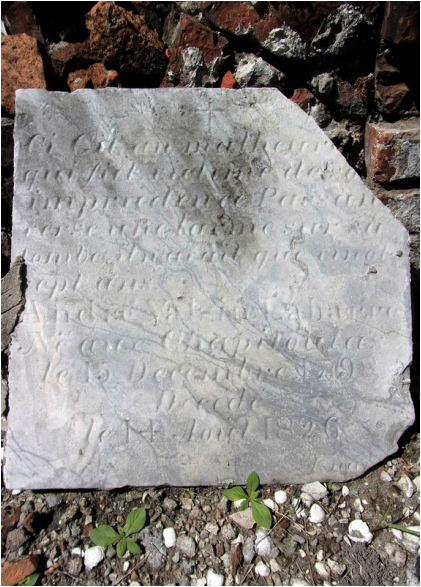 Ci Gît un malhereux qui fut victime de son imprudence. Passant, verse une larme sur sa tombe, il n’avant que vingt sept ans. André Valsin Labarre Né aux Chapitoulas le 15 Decembre 1798 Decedé le 14 Aout 1826 Here lies an unfortunate who was a victim of his own imprudence. Passerby, shed a tear upon his grave, he was only twenty seven years old. André Valsin Labarre Born at Chapitoulas December 15, 1798 Died August 14, 1826 Labarre’s tablet was carved by Jean Jacques Isnard from gray marble. Isnard (1779-1859) was one of the earliest stonecutters in New Orleans. His prolific work can be found throughout St. Louis Cemetery No. 1. Valsin’s death and burial in 1826 was the end of a short, but presumably happy life. His cause of death will likely remain a mystery. “Indiscretion or Excess” The phrase “victim of one’s own imprudence,” appears in rather specific narratives in the nineteenth century. It suggests a negligence of self-care by way of excessive living or failure to treat illness in its preliminary stages. For example, a woman who dies of consumption because she did not treat a cold was a victim of her own imprudence. Alternatively, the term “victim of imprudence” was frequently used in advertisements for men who had contracted venereal disease. In the case of Labarre, others have suggested perhaps the excesses of drink, although no record can confirm. For whatever reason, Valsin’s family requested such language for his tablet. Little would they know that the words they paid Isnard to carve would become somewhat of a legend a century later. A Travelling Tablet Perhaps the greatest mystery of all, however, is where Valsin himself was originally buried. A survey completed in the 1930s notes the tablet to be located in St. Louis Cemetery No. 1, Aisle 8-R, although it does not specify lot number. Today, Valsin’s tablet is located in Aisle 7-R. Unfortunately, the original cemetery records for 1826 do not specify lot number. While we may love Valsin’s immortal eulogy, his mortal remains may never be located for sure. One Hundred Years of Mistranslation Nearly 75 years after Valsin’s death, in 1900, the New Orleans Daily Picayune wrote a full-page piece on local cemeteries in honor of All Saints’ Day, November 1. This was a common annual occurrence in which newspapers would describe the scene at each cemetery, noting curious epitaphs or beautiful new tombs. With this article, Valsin’s memory was revived in a very peculiar way: On one old slab, almost defaced with age, is the inscription “Ci git un malhereuse qui fut victim de son imprudence. Verse un larme sur sa tombe, et un ‘De Profundis’ s’il vout plait,” por son ame. Il n’avait que 27 ans, 1798.” The translation reads: “Here lies a poor unfortunate who was a victim of his own imprudence. Drop a tear on his tomb and say if you please the Psalm, ‘Out of the Depths I Have Cried unto Thee, Oh, Lord’ for his soul. He was only 27 years old.[11] Three years later, on November 2, 1903, the Picayune printed the exact same paragraph in another All Saints’ Day article. This printing birthed two widely-repeated falsehoods regarding Labarre – that he had died in 1798 (the year he was born), and that the tablet had an additional line regarding a psalm, which it clearly does not. This misunderstanding would perpetuate itself, making scholars and authors truly the victims of their own imprudence. In 1919, a tourist brochure said of St. Louis Cemetery No. 1: “The inscriptions are in French, and many of them tell how he who sleeps beneath ‘fell in a duel, the victim of his own imprudence.[12]’” It is unclear if this is directly inspired by Labarre or perhaps another now-missing tablet. Unfortunately, even the most revered of New Orleans cemetery texts replicate to the Labarre myth. In one seminal 1974 book, the authors suggest again that Labarre’s is the oldest tablet in the cemetery, quoting the Picayune article. The text also muses that perhaps the poor fellow had died in a duel. From 1974 to 2004, three other publications cite this faulty article, each suggesting that it is the oldest tablet in the cemetery, and that the deceased had met his end in a duel. One insists that the tablet is long lost to history. All this time, André Valsin Labarre’s tablet has sit idly by as tour groups wind in and out of the cemetery aisles.
New Orleans cemeteries typically identify the owners of tombs by direct lineage. Through this lens, there are no descendants to claim care of the prodigal son’s tablet. Valsin’s son, Samuel Placide Labarre, married Emma Labranche in 1866. Their union produced one son, who Samuel named after his father, Valsin. Valsin Labarre died around 1890. There is no indication that he married or had children. Additionally, Virginia Conrotte remarried after Valsin’s death. She and her new husband, Daniel Gregoire Borduzat had at least four children. Unfortunately, the surname Borduzat appears nowhere in indexed cemetery records. If indirect relatives to Valsin Labarre remain, they have not reconnected with his burial place. Both the tablet to his memory and Valsin himself have become, in a sense, immortal for the most peculiar of reasons. Yet their fate remains suspended between the aisles of New Orleans' oldest cemetery, awaiting the next chapter in their story. [1] Stanley C. Arthur and George Campbell Huchet de Kernion, Old Families of Louisiana (New Orleans: Harmanson, 131), 98-104.
[2] Arthur and Campbell, 98. [3] William Reeves, De La Barre: Life of a French Creole Family in Louisiana (New Orleans: Polyanthos, 1980), 79, 88. [4] Reeves, 88. [5] Reeves, 175. [6] Reeves, 119. [7] Probate inventory of André Valsin Labarre, New Orleans Public Library microfilm KR 308, Old Inventories, Vol. L, 1821-1832. [8] 1821 New Orleans directory, Louis Labarre, No. 14 Conti. [9] New Orleans will documents, New Orleans Public Library, VRD410, 1805-1833, Recorder of Wills, Vol. 4, 106. [10] La Courier de Louisiane, August 16, 1826, 2. Accessed via microfilm, New Orleans Public Library. Translation composite of a number of translations from French speakers, William Reeves, and Emily Ford. [11] “All Saints Day,” Daily Picayune, November 2, 1900, 3. [12] Garnett Laidlaw Eskew, “In Old New Orleans,” from Travel, Vol. XXXII, No. 4 (Feb. 1919), 26. At the end of the main aisle in Square 1 of St. Louis No. 2 is a simple tomb with a low-pitched gable roof. Coated in modern cement and latex paint, it is difficult to determine much about its original appearance. Perhaps it was once coated in brightly-colored stucco, or its roof tiled in slate or terra cotta. Ironwork may once have enclosed its simple design. Without the fortunate discovery of an historic photograph, which is extremely rare, the elegant past of this tomb may never be known. But the de Armas tomb offers a hint to the scrutinizing eye. Its marble closure tablet is embellished with an ornate relief carving depicting a winged hourglass encircled with a floral wreath. The hourglass is surrounded by a snake eating its tail – the ouroboros – a symbol of immortality. Among the few depictions of the winged hourglass in St. Louis Cemetery No. 2, this carving is by far the most detailed. Such a carving is indicative of a level of style and craftsmanship long faded from New Orleans cemeteries. At one time it was not alone in its ornamental beauty, but instead belonged to a rich landscape of beaded wreaths, draped urns, and weeping angels. Even today, the de Armas tomb is not alone in one regard. Nearly three miles away, St. Louis Cemetery No. 2’s younger sister, St. Louis No. 3, stretches along the edge of Bayou St. John in long aisles. Amidst its large lots and photogenic tombs is the tomb of the Depaquier family. Uncompromised by modern repairs, the faded stucco walls bely that the tomb was once limewashed a dark rose color. The pitch of its roof is reminiscent of the de Armas tomb. The closure tablet of Dupaquier tomb is bordered with a carved braided rope. Atop its simply-lettered epitaph is a winged hourglass nearly identical to that found on the de Armas tomb in St. Louis Cemetery No. 2. Studies of cemetery craftsmanship in New Orleans have shown that few motifs, materials, or methods in cemetery stonecarving are the result of happenstance. Who carved these tablets? What do they symbolize? And why did the Dupaquier and de Armas families end up owning identical tablets? The de Armas and Dupaquier Families The two tombs are the burial places of the patriarchs of their respective families. In St. Louis No. 2, Michel Theodore de Armas (sometimes listed in documents as Michael or Miguel), was a notary and lawyer who was born in New Orleans in 1783 and died in 1823.[1] In St. Louis No. 3, Claude Dupaquier was born in France in 1806, arrived in New Orleans in the 1840s, and died in 1856.[2] Between 1823 and 1856, life expectancy was around 37 years, so that these men died at age 40 and 50 (respectively) is unremarkable. Both de Armas and Dupaquier had children that became important members of New Orleans’ business and social circles after the Civil War. Dr. Auguste Dupaquier, who is buried with his parents, was described as having a “gentle, loving, and kindly temperament, mixed with firmness and rare energy, and he secured the affections of all whom he approached.[3]” Dr. Dupaquier had no discernable interaction with the children of de Armas, and it is unlikely that the families had enough relation to construct matching tombs knowingly. One significant similarity between the Michel de Armas and Claude Dupaqueir was their preference for the French language. Both tablets are carved in French.
In nineteenth century New Orleans, a person’s linguistic and cultural identity often determined who they chose to carve their final epitaph or build their eternal resting place. For de Armas, or his widow, Gertrude St. Cyr Debreuil, it would have been a given that they chose Paul Hippolyte Monsseaux. New Orleans cemeteries are populated with the small, often overlooked signatures of local stonecutters. Often these signatures wear away, and craftsmen often neglected to sign their work at all. Many stonecutters began their careers working for other more established cutters, signing the name of their master instead of that of the apprentice. These realities complicate the study of cemetery craftwork. In the case of the de Armas closure tablet, a small, clean-lettered signature is present at its bottom right-hand corner – MONSSEAUX. The Depaquier tomb retains no signature at all. Paul Hippolyte Monsseaux Like Claude Depaquier, Paul Hippolyte Monsseaux (1809-1874) was a French native who arrived in New Orleans as an adult.[4] Present in New Orleans by 1842, Monsseaux is best known as the stonecutter who built many tombs designed by architect J.N.B. De Pouilly. These included many famous tombs in St. Louis Cemetery No. 2. Monsseaux often worked with other stonecutters in either a master/apprentice role or as business partners. In addition to his work for J.N.B. de Pouilly, his signature is often found beside other cutters like Tronchard and Kursheedt & Bienvenu. Through his entire career, Monsseaux held the same marble yard on St. Louis Street at the corner of Robertson Street – directly beside St. Louis Cemetery No. 2 and New Basin Canal. Through his career, Monsseaux also sold marble to fellow stonecutters; he partnered with others to secure equipment and technology that advanced the trade. Most notably, he owned a steam marble works for some time in the 1870s, the rights to which he lent to other cutters Stroud and Richards.[5] Monsseaux’s accomplishments were many, but his clientele was rather distinct. Most of Monsseaux’s signed tablets are carved in French. In this manner, Monsseaux is a French counterpart for German-speaking stonecutters of the time who served a distinctly German clientele. There are always exceptions – Monsseaux built the DePouilly-designed Iberian Society tomb in St. Louis Cemetery No. 2. Yet the majority of his work served French-speaking clients who belonged to the upper echelons of New Orleans society. Stylistic Inspirations and Symbolism French speaking upper-class New Orleaneans in the 1830s were enthralled with the style and beauty of tombs found in Paris’ Pere Lachaise Cemetery at the time, and Paul Hippolyte Monsseaux gladly catered to that demand. Sarcophagus-style tombs with corner acroteria and inverted torches appeared in St. Louis No. 2 during this time. These tastes adapted through the 1850s and into the first years of St. Louis Cemetery No. 3. Greek Revival temples and Egyptian Revival tombs rose in the squares of the both cemeteries, mimicking the aisles of the great French burial ground. Often, it was Monsseaux who provided his clients with these romantic sepulchers. Pere Lachaise Cemetery is populated with hundreds of winged hourglasses. In fact, the first image to greet the visitor at the cemetery gate is a pair of such hourglasses. This is also the case at Montparnasse Cemetery, also in Paris. The history of the winged hourglass as a funerary symbol appears to split along linguistic and cultural lines in the United States. In the English-speaking Northeast, it is contemporary with the skull-and-crossbones and death’s head, symbolizing the fleetingness of time. In this context, the winged hourglass was contemporary to the 18th century and faded from popularity by the 1830s. French-speaking New Orleans funerary culture developed more closely to that of Paris than its American cousins, however. The winged hourglass is seldom seen in tombs constructed prior to 1820. It does, however, appear to grow in popularity from 1820 through the 1850s, when the de Armas and Dupaquier tombs were constructed. This inspiration was drawn directly from the Parisian cemeteries. And New Orleans was not alone in this inspiration. Not to be outdone as a European city in the New World, Buenos Aires’ Recoleta Cemetery, founded in 1822, hums with the flutter of winged hourglasses. The de Armas and Dupaquier families may never have known each other, but they are together twin scions of a lost cemetery landscape. Opulent with their floral wreaths and outspread wings, their hourglass tablets were likely carved by Monsseaux himself or an apprentice. It is possible, even, that the Dupaquier tablet was a replica of de Armas’, carved by a student still learning his trade. Or, perhaps, both designs were borrowed from a pattern book imported from Paris. In any case, they endure as silent reminders of the importance of each tomb in the larger landscape of our historic cemeteries. [1] Florence M. Jumonville, Ph.D., ‘Formerly the Property of a Lawyer’: Books that Shaped Louisiana Law. New Orleans: University of New Orleans Library Facility Publications, 2009, 7.
[2] Orleans Death Indices 1804-1876. Vol. 17, 312. [3] “Death of Dr. Dupaquier,” New Orleans Daily Democrat, April 8, 1879, p. 8. [4] Charles LeJ. Mackie, “Paul Hippolyte Monsseaux: Marble Dealer,” printed in SOCGram, Fall 1984, 14-16. [5] Daily Picayune, May 18, 1871, 3. |
About the Author:Emily Ford owns and operates Oak and Laurel Cemetery Preservation, LLC. Archives
November 2019
Categories
All
|
- About
-
Restoration
- Services
-
Portfolio
>
- Turning Angel Statue, Natchez, MS
- Ledger Monument, Baton Rouge, LA
- Pyramid Statuary, New Orleans, LA
- Bronze and Granite Monument, Carville, LA
- Box Tomb, New Orleans, LA
- Vernacular Concrete Monument, Pensacola, FL
- 1830s Family Tomb, Covington, LA
- 1850s Family Tomb, New Orleans, LA
- 1880s Family Tomb, New Orleans, LA
- Headstone and Monument Restorations, Pensacola, FL
- Society Tomb, New Orleans, LA
- Education
- Blog
- Contact
|
Oak and Laurel Cemetery Preservation, LLC is a preservation contractor in New Orleans, Louisiana, specializing in historic cemeteries, stone conservation, educational workshops and lectures. Oak and Laurel serves the region of the Southeastern US.
|
QUICK LINKS |
CONNECTNew Orleans, Louisiana
restoration@oakandlaurel.com (504) 602-9718 |
Proudly powered by Weebly

